| Author |
Message |
 |
|
|
 |
|
Advert
|
Forum adverts like this one are shown to any user who is not logged in. Join us by filling out a tiny 3 field form and you will get your own, free, dakka user account which gives a good range of benefits to you:
- No adverts like this in the forums anymore.
- Times and dates in your local timezone.
- Full tracking of what you have read so you can skip to your first unread post, easily see what has changed since you last logged in, and easily see what is new at a glance.
- Email notifications for threads you want to watch closely.
- Being a part of the oldest wargaming community on the net.
If you are already a member then feel free to login now. |
|
 |
![[Post New]](/s/i/i.gif) 2017/12/12 21:36:13
Subject: Curis' Normans and Medievals (Aetius, Owen and Dracula added 23rd August)
|
 |

Regular Dakkanaut
|
In the lands of the north, where the black rocks stand guard against the cold sea, in the dark night that is very long, the men of the north lands sit by their great log fires and they tell a tale…
Exploring Citadel Miniatures' pre-slotta ranges is a real journey of discovery and wonder for me. My knowledge of Games Workshop's miniature ranges starts with 1991's Catalogue 1 – which only goes back as far as 1986 and not right to the beginning of Citadel history (1979) as the name suggests. There's a great many pre-1986 miniature ranges I have no awareness of, and so I'd never painted any pre-slotta stuff until I found out about this Gnoll.
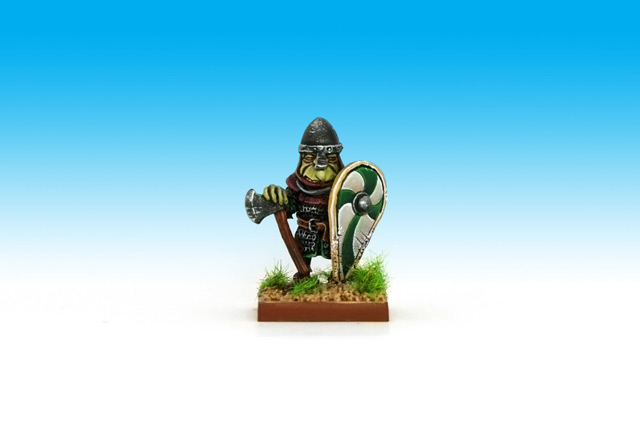
Gnollin the Gnoll.
This is no ordinary Gnoll – his nasal helm, kite shield and hafted axe mean he's Fantasy Tribes FTG14 Gnorman the Gnoll. I picked him while I was trawling the net for 1980s Citadel Normans to reinforce my army. His giant nose and teeny legs do put me in mind of Noggin the Nog.
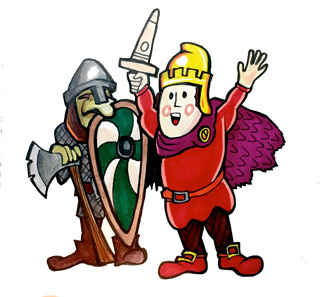
"Hello" said Noggin, cheerfully. "Very pleased to meet you."
Gnolls in the Warhammer World are described as having ruddy flesh, but I thought that when placed alongside regular Normans he'd work better with green skin to reinforce his inhumanity. As I found out reading Goblin Lee's blog on Gnolls, the Fantasy Tribes Gnolls were later rebranded as C12 Great Goblins, so I can claim the green flesh is goblin rather than botched Gnoll.
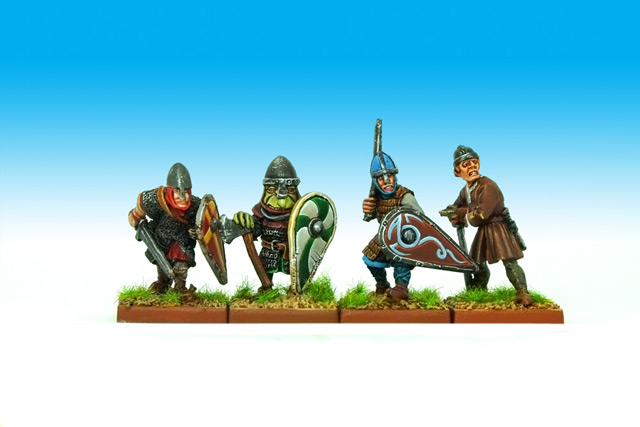
Gnollin with more Normans I've painted since Salute 2017.
I now have fifteen Norman Sergeants, which allows them to rank up pleasingly in a five-by-three regiment. Though these models have been primarily used in Saga where round bases are king, I do like the 20mm square bases to make them into a neat and imposing regiment.
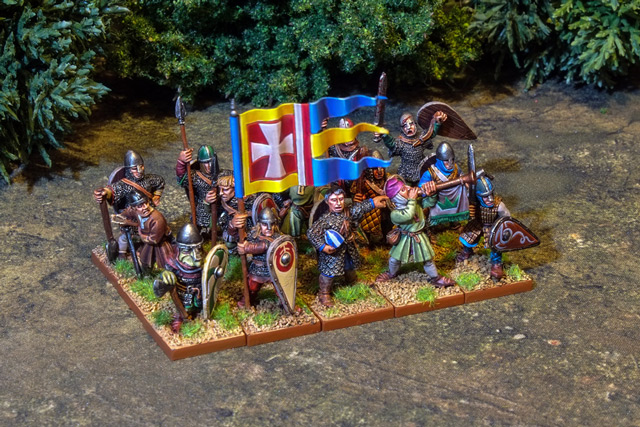
Lord Weuere happy to let Gnollin in his shieldwall.
I really enjoy slipping this little piece of fantasy into my historical force; I want to push that envelope further. Watch this space!
|
|
This message was edited 3 times. Last update was at 2018/08/23 11:55:00
|
|
|
 |
 |
![[Post New]](/s/i/i.gif) 2017/12/14 02:06:43
Subject: Curis' Normans and Medievals
|
 |

Regular Dakkanaut
|
Decades of exposure to Games Workshop’s marketing materials has conditioned me not to paint individual figures, but regiments, and then armies. There was no stopping at just one Gnorman Gnoll. Gnot on your gnelly. eBay trawling has turned up two more preslotta gems from 1981–3.
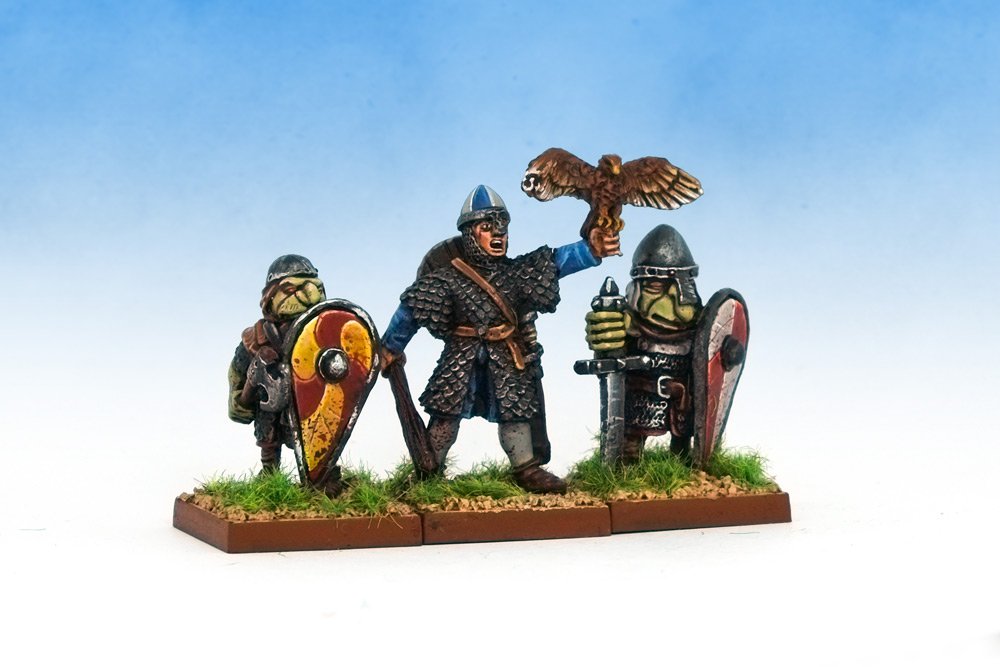
Lord Tisserand with his hawk Antonius, accompanied by two Gnolls.
Lord Tisserand is a simple conversion of the Wargames Foundry ex-Citadel Normans with the arm from a Black Tree command figure holding a hawk swapped in to make him a regimental champion. I also sculpted on a strap so he could carry a shield while waving around the Bird of Command – but that’s barely worth mentioning as this sentence took longer to type than the strap took to sculpt.
You can see the original figure as it appeared in White Dwarf 92, with the cliché French names variously inspired by Inspector Clouseau, Rémy Martin cognac, Marie Brizard liquer and maybe ‘Allo ‘Allo characters.
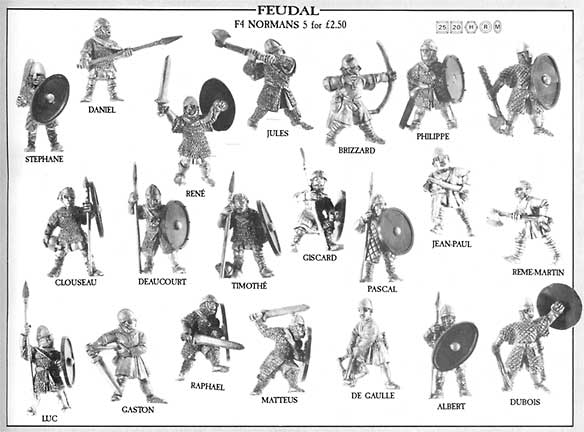
And just what is the French for “cliché”?
Why a hawk? Hawks were a symbol of authority in Norman times. The Bayeaux Tapestry initially shows Harold holding a hawk, and switches to showing William holding a hawk when his claim to England’s throne becomes legitimate.
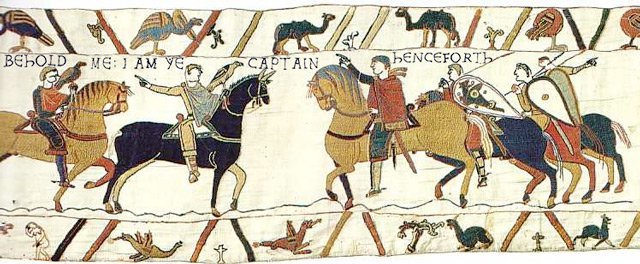 [/i] [/i]
I might push this idea of animals symbolising command into the realm of fantasy and model a Norman King on a giant hawk or griffon. I am enjoying the blend of historical and fantasy in the same project.
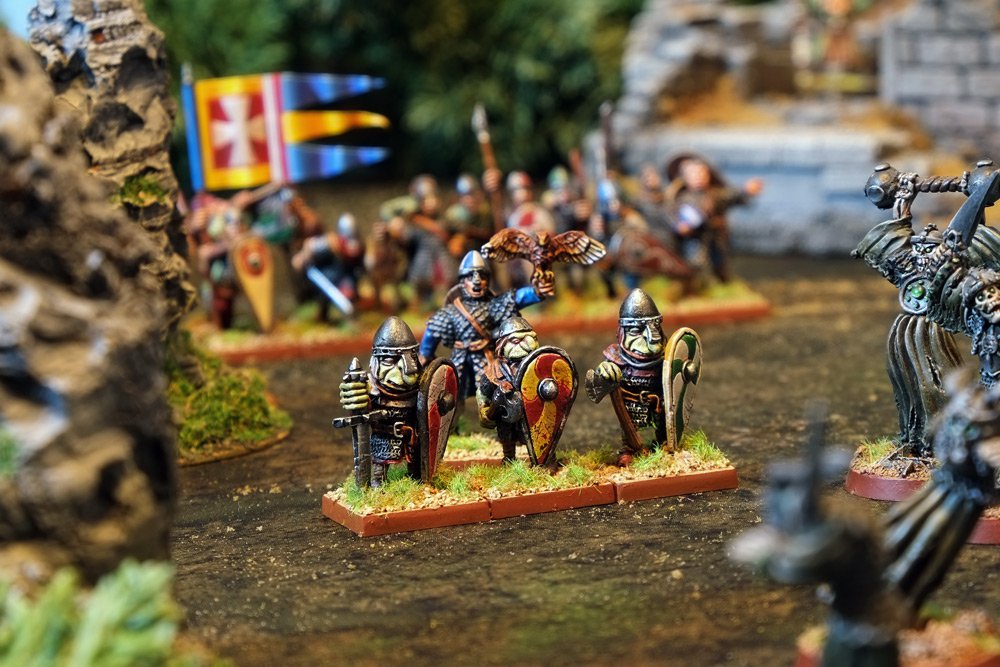
Lord Tisserand and the Gnolls against Undead Wights.
All three Gnolls I have painted now are variants of the same figure. In the above image the right-most Gnoll is the unadulterated miniature. The one on the left I converted with an arm and sword from a 1980s Citadel Goblin. The central Gnoll is the resculpted version that appeared in the later C13 range – who has the same body but a new weapon arm and head. Challenge now is how to convert future Gnolls to provide enough variety for a complete Gnorman regiment.
|
|
|
|
 |
 |
![[Post New]](/s/i/i.gif) 2017/12/15 21:38:20
Subject: Curis' Normans and Medievals
|
 |

Regular Dakkanaut
|
Friar Tuck, legendary tonsured companion of Robin Hood, joins my miniatures collection.
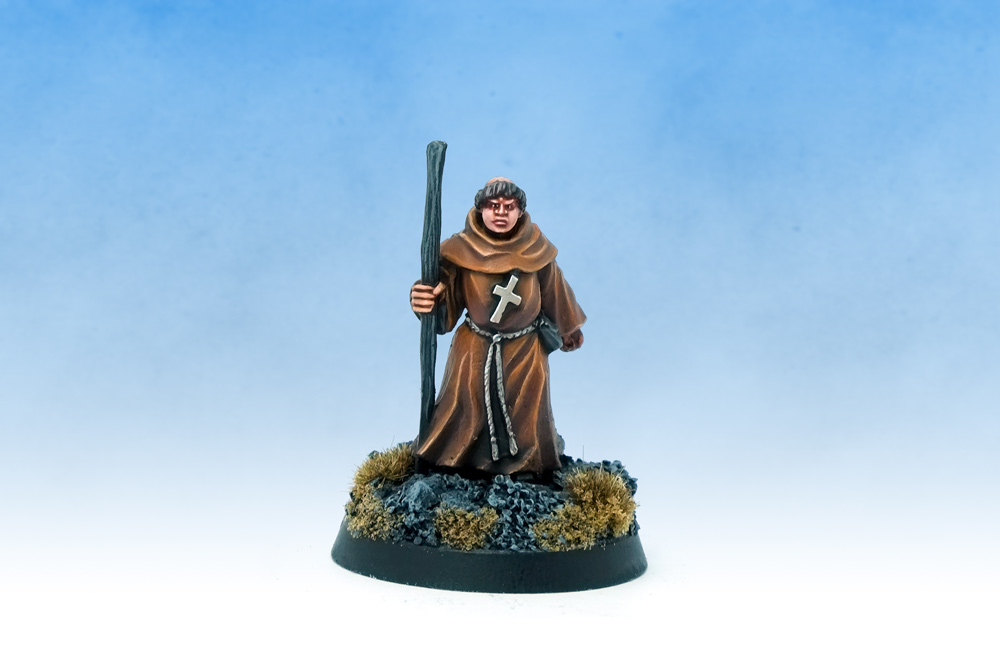 “Praise the Lord! And pass the tax rebate!”
“Praise the Lord! And pass the tax rebate!”
Friar Tuck was an impulse purchase whilst acting as Nottingham cultural attaché for visiting family members. Warlord Games (a Nottingham company) have a small range of Heritage Miniatures they’ve slipped into local tourist spots like the the National Justice Museum and Nottingham Tourism Centre. I quite enjoyed making my turbo-nerd purchase in a regular retail outlet – it’s like being able to buy Dungeons & Dragons in the same place as your milk and morning papers.
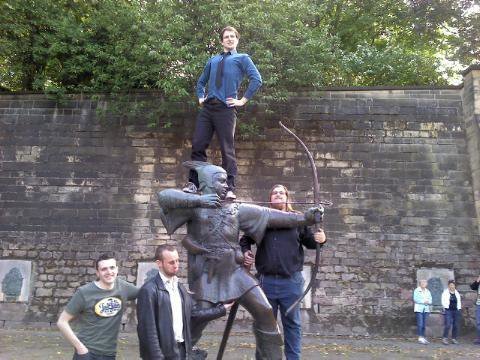 “If Curis has seen further it is by standing on the shoulders of giant Robin Hood statues.”
“If Curis has seen further it is by standing on the shoulders of giant Robin Hood statues.”
Tuck’s base was originally built up with sand to accommodate the cast-on scenic base. But the original sculpted base features what looks like a little tombstone with FRIAR TUCK engraved on it, which I thought implies he’s the friar that’s just buried Friar Tuck, or alternatively Friar Tuck’s ghost. That was too much narrative for me. So I chopped it off.
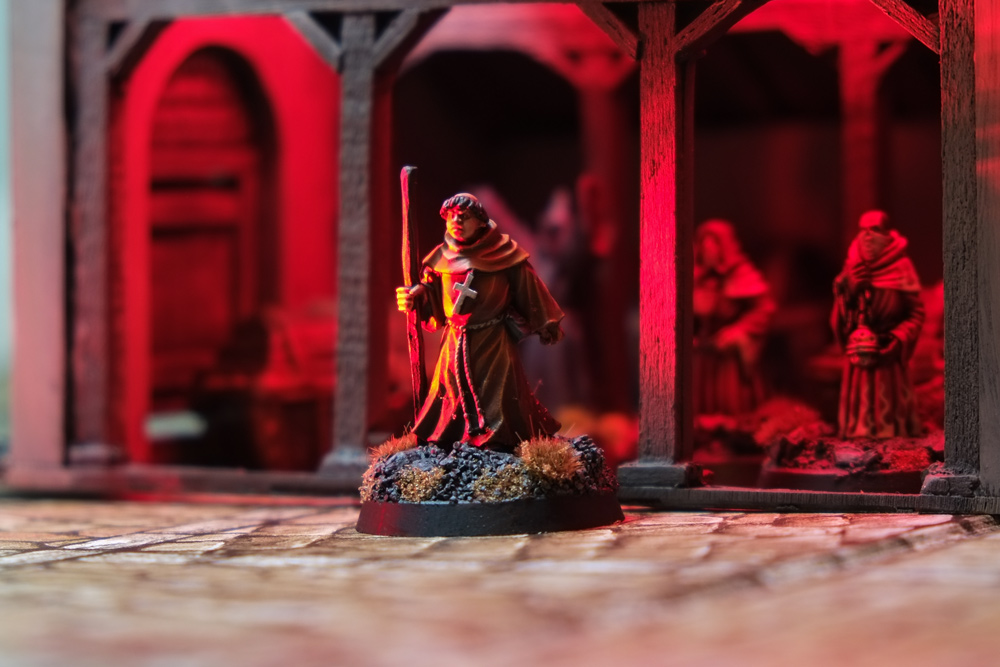 Friar Tuck in the Monastery of Abingdon.
Friar Tuck in the Monastery of Abingdon.
The basing style matches my Warhammer Age of Sigmar and Dungeons & Dragons miniatures, and not my Citadel Normans. Tuck is too big to stand alongside the older 1980s Perry sculpts, plus friars are anachronistic in Norman times. But then friars are anachronistic in the classic Robin Hood setting of Richard the Lionheart. I plan to paint some monks/friars/priests that are compatible with my Normans.
Cool ending tangent fact: – the Friar Tuck action figure from the Robin Hood Prince of Thieves toyline was based on the Star Wars Gamorrean Guard?
|
|
This message was edited 1 time. Last update was at 2017/12/15 21:38:48
|
|
|
 |
 |
![[Post New]](/s/i/i.gif) 2017/12/18 18:50:13
Subject: Curis' Normans and Medievals
|
 |

Regular Dakkanaut
|
Saint Augustine arrived in Britian AD 597 to revitalise Christianity. For the next four hundred years, crudely constructed churches like this one appear across the island.
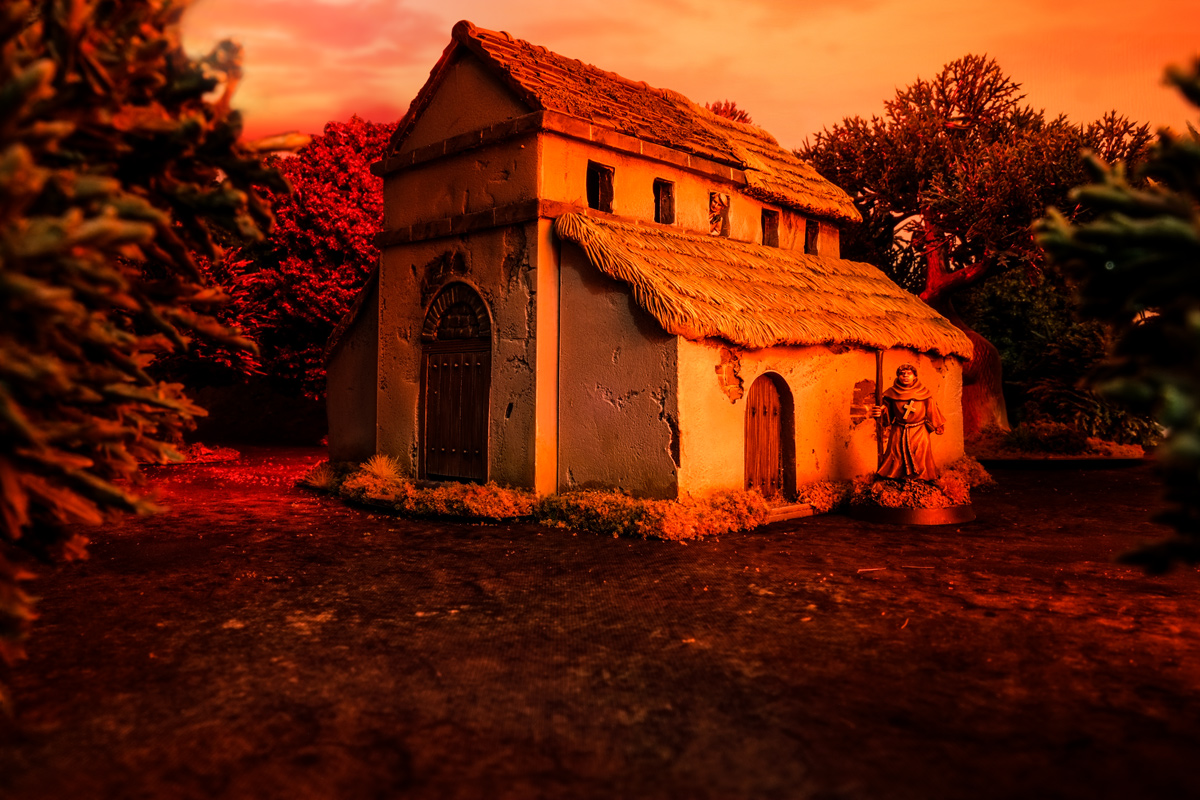 A humble friar takes a stroll around the Saxon minster at sunset.
A humble friar takes a stroll around the Saxon minster at sunset.
“But Curis,” I hear you cry, “Friars didn’t exist until centuries after the Dark Ages ended. Your inclusion of Friar Tuck in the photograph above is highly anachronistic.” Well, look carefully and you’ll see Doctor Who is also in the photo to sweep your anachronism away. It’s a unique concept for a Doctor Who episode – transporting a medieval friar back a few centuries and committing all sorts of theological faux pas in the Dark Age monastic communities. And by “unique” I mean “rubbish”.
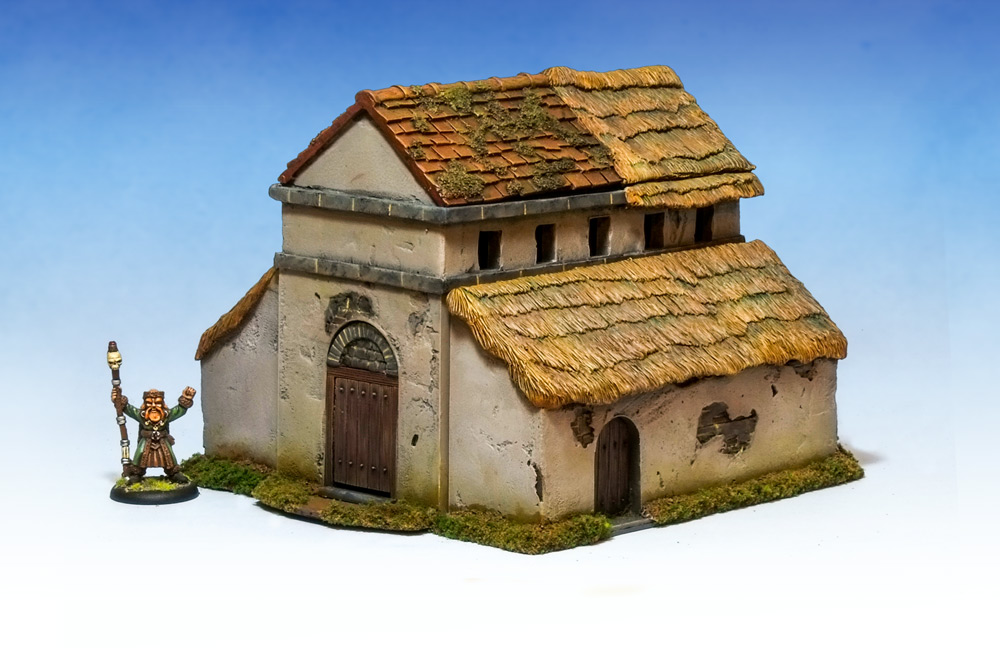 Obscure early Warhammer druid shown for scale, and perhaps further anachronisms.
Obscure early Warhammer druid shown for scale, and perhaps further anachronisms.
This church was a Salute 2017 purchase from 1st Corps. It’s five hunks of resin that combine to form a solid-looking and (deliberately) wonky building. There’s a lot of mdf terrain on the market, but resin’s ease of assembly and feel of structural heft can’t be beaten. I particularly like the roof being half tiles and half thatch – suggesting the builders couldn’t loot enough tiles from derelict Roman structures. Another nice touch is the plaster crumbling from the exterior to reveal the non-ashlar masonry typical of churches built before the Norman Conquest.
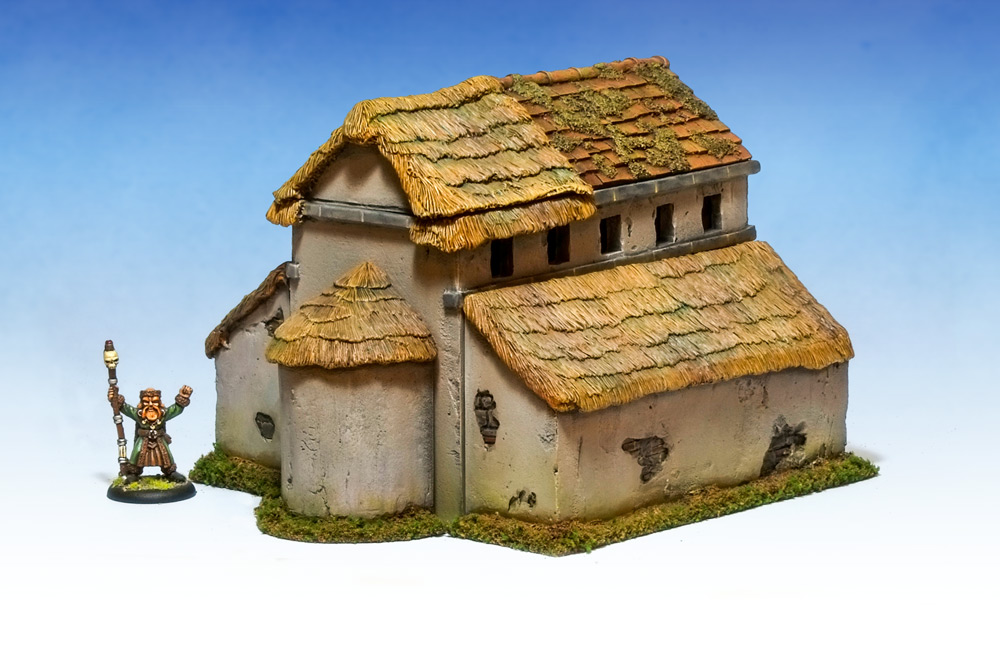
As a special birthday treat AJ took me to Butt Road – the site of a similarly laid out church built AD 320–340. You can see the curved apse in the left of the photo below and the (modern) blocks of oak marking the position of the church’s internal posts.
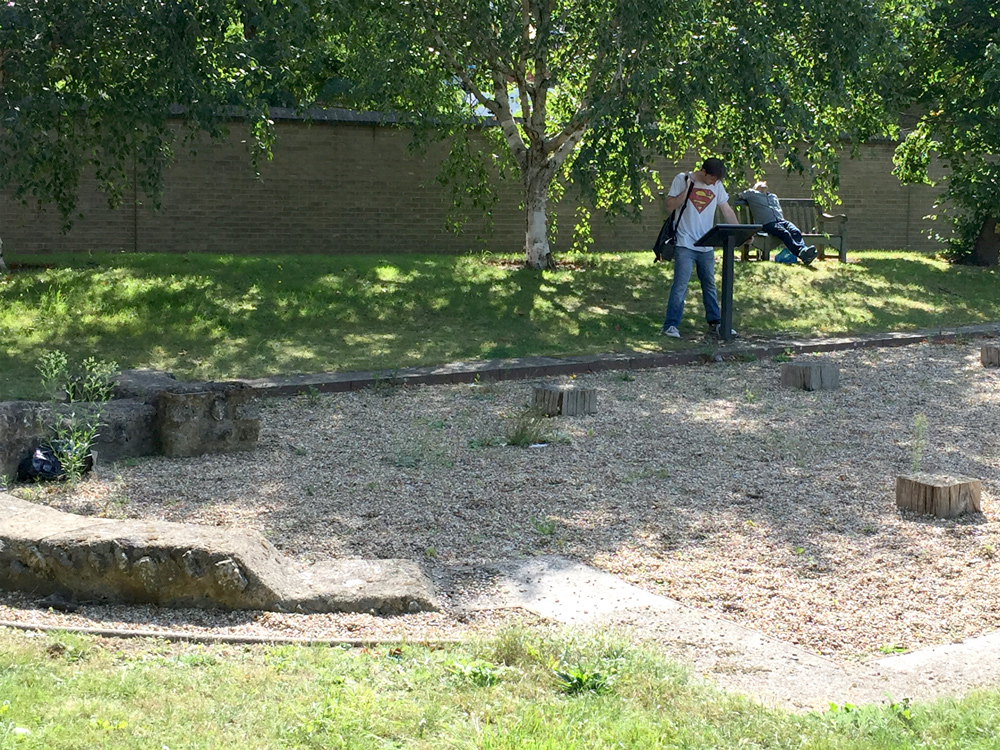 Also enjoying the Late Roman church – a local Essexman passed out drunk on cans of cider.
Also enjoying the Late Roman church – a local Essexman passed out drunk on cans of cider.
My model church has those internal wooden posts as part of the interior detail too. You might remember seeing them already on this blog as I’ve been cheeky and used the half-painted interior as backdrops for Chaos Thugs and Friar Tuck.

As a pleasing touch, you can take the two portici off the side of the church and combine them into a thatched cottage. This will come in useful for that inevitable point when my regular opponents despair at me trotting out the church for its seventeenth game in a row.
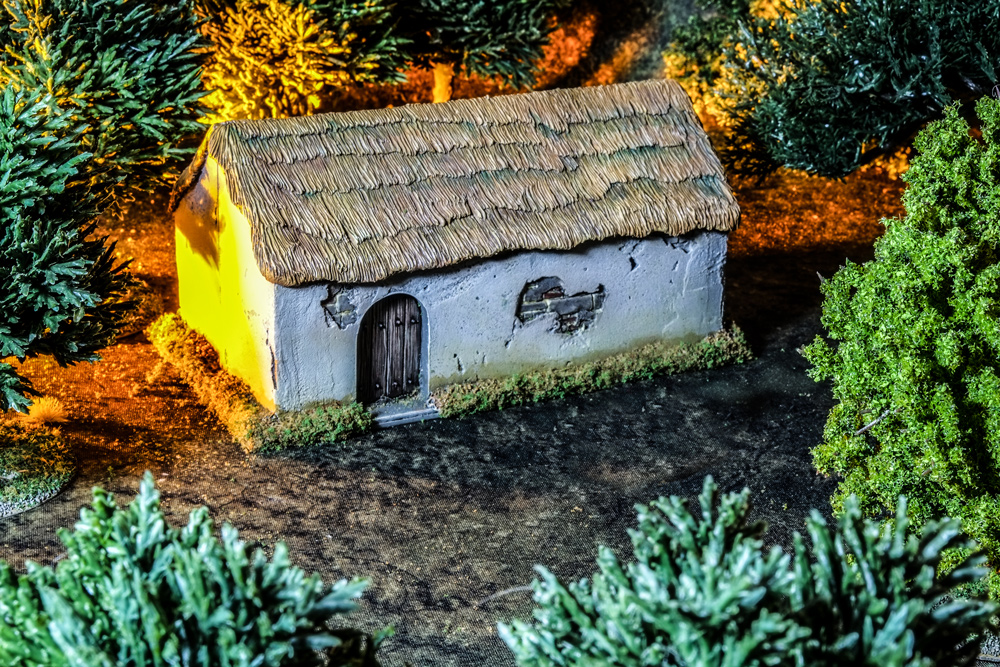 "Fussake Curis, we’re playing a 6mm science fiction and this cottage is no better than that bloody church."
"Fussake Curis, we’re playing a 6mm science fiction and this cottage is no better than that bloody church."
Disappointingly, both doors on the kit are have entirely smooth and detail-free planks, which I had to paint the wooden texture onto. It seems at odds with the love and care the sculptor put into the tiles and thatch to skimp on the doors. A minor flaw.
Such a big piece of terrain is a pain to photograph. In the end I couldn’t resist sticking some goggly eyes on it.
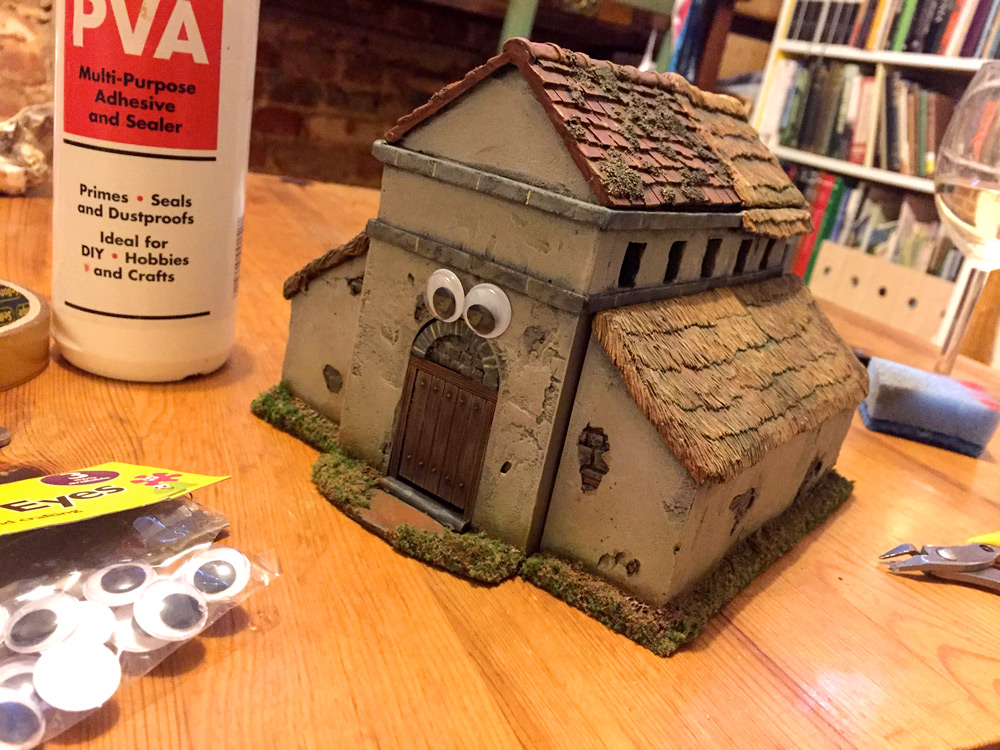 Too late, the true meaning of Pope Benedict’s final statement becomes clear. “The church is alive.”
Too late, the true meaning of Pope Benedict’s final statement becomes clear. “The church is alive.”
I want to push the modelling on the church further with:
Adjacent burial ground with Renedra’s plastic gravestones
Interior detailing, such as an altar, and benches for the clergy
A base for the piece, to get rid of the awkward grassy lip
A selection of Dark Age civilians and monks.
But the piece is finished enough for Dark Age and Early Medieval gaming.
|
|
This message was edited 1 time. Last update was at 2017/12/18 18:50:46
|
|
|
 |
 |
![[Post New]](/s/i/i.gif) 2018/03/27 16:44:05
Subject: Curis' Normans and Medievals
|
 |

Regular Dakkanaut
|
Back in 2014 I proudly declared I was starting a Late Imperial Roman army, and showed off my first test model. I adhered to the time-honoured tradition of planning an army, buying an army, telling everyone about my plans… then only painting one figure before quietly packing everything away and never mentioning it again. But the hiatus is over! Here is the second finished model – Praeses Lanceas Araneus.
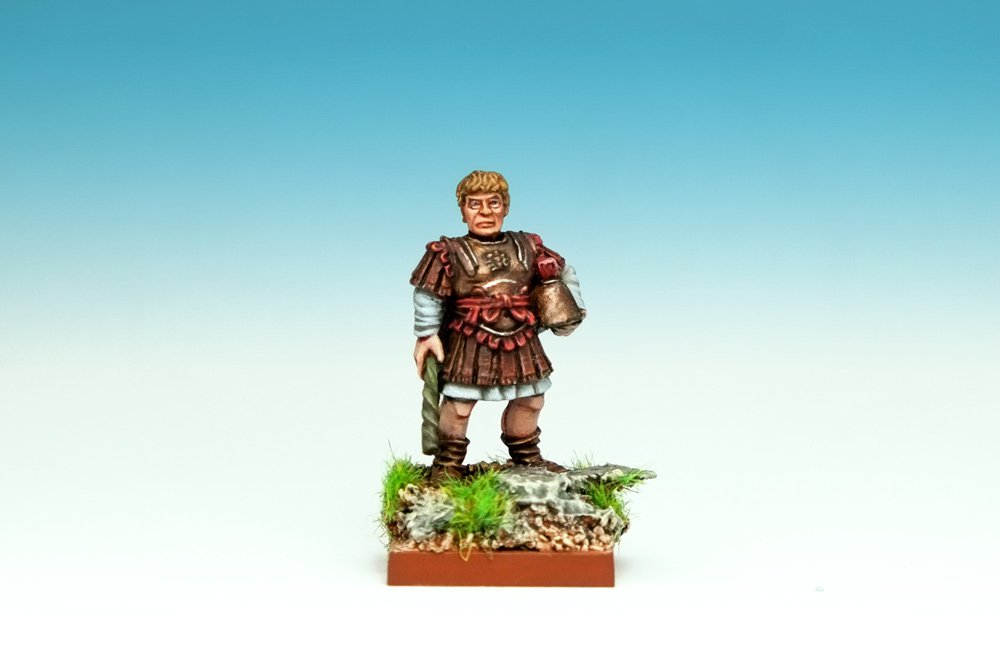
The figure, as with all the Foundry Late Imperial range, is really very small. I plan for other parts of my army to draw from manufacturers with chunkier proportions and a slightly larger scale – Black Tree, Crusader, Footsore et cetera. To avoid the subordinates towering over him, I built up his base with bark. I only decided this after painting him, and ended up repainting his legs and shoes after I'd cut and filed him off his intrinsic metal base. That was not clever, but I'd regret more having his head only come up to nipple-height in a front rank of spearmen.
Araneus didn't immediately strike me as Late Imperial Roman – his chest armour and his vine staff look much earlier. I had to check with Foundry he wasn't an exile from their Early Imperial Roman range. The figure does appear in the John Lambshead Fall of the West – the excellent Warhammer Ancient Battles supplement focussing on the last 126 years of the Roman Empire.
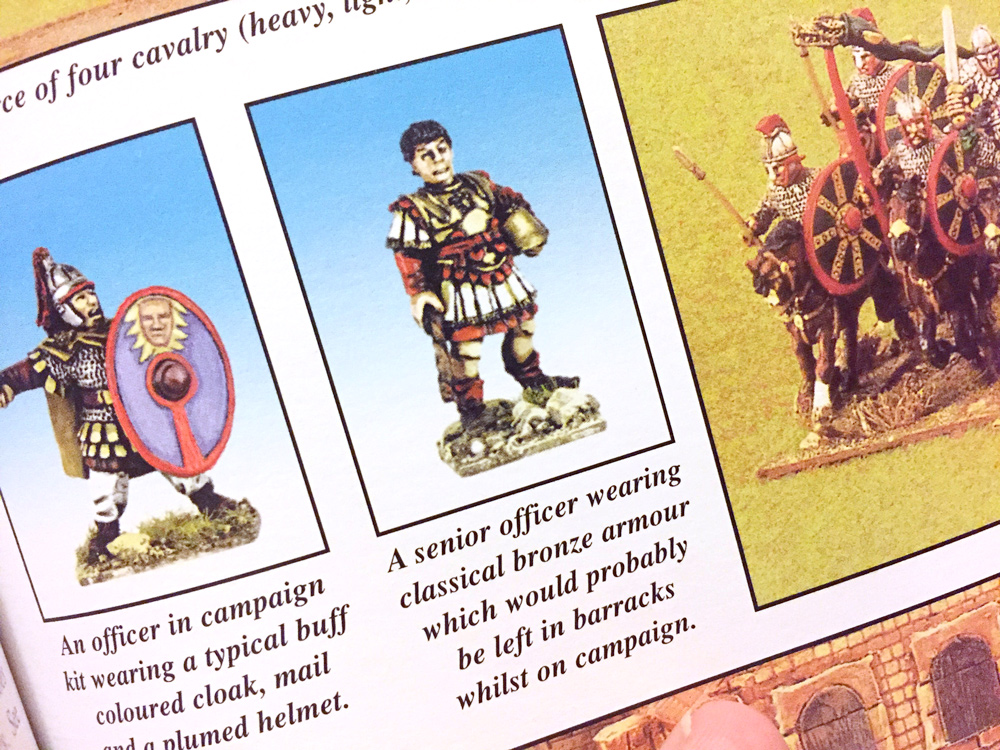
So this Late Imperial Roman figure is dressed as someone from much earlier antiquity. His hair is curly in the style of statues, and his helmet may even be a Theban/Corinthian design. He's one of those Romans yearning for a return to earlier times, when Romans were Romans and Emperors ruled wisely and justly. It was a very Roman trait, mistaking the past for a golden age unspoilt by moral decay and decadence. Livy expressed this sentiment centuries earlier in his preface to The History of Rome.
The subjects to which I would ask each of my readers to devote his earnest attention are these – the life and morals of the community; the men and the qualities by which through domestic policy and foreign war dominion was won and extended. Then as the standard of morality gradually lowers, let him follow the decay of the national character, observing how at first it slowly sinks, then slips downward more and more rapidly, and finally begins to plunge into headlong ruin, until he reaches these days, in which we can bear neither our diseases nor their remedies.
My Late Imperial Roman army is now two figures – both of them commanders. I plan to add a ballista next (specifically with games of Saga in mind), and some limitanei that have been lurking around my painting desk for years waiting for a shield design to come into being.
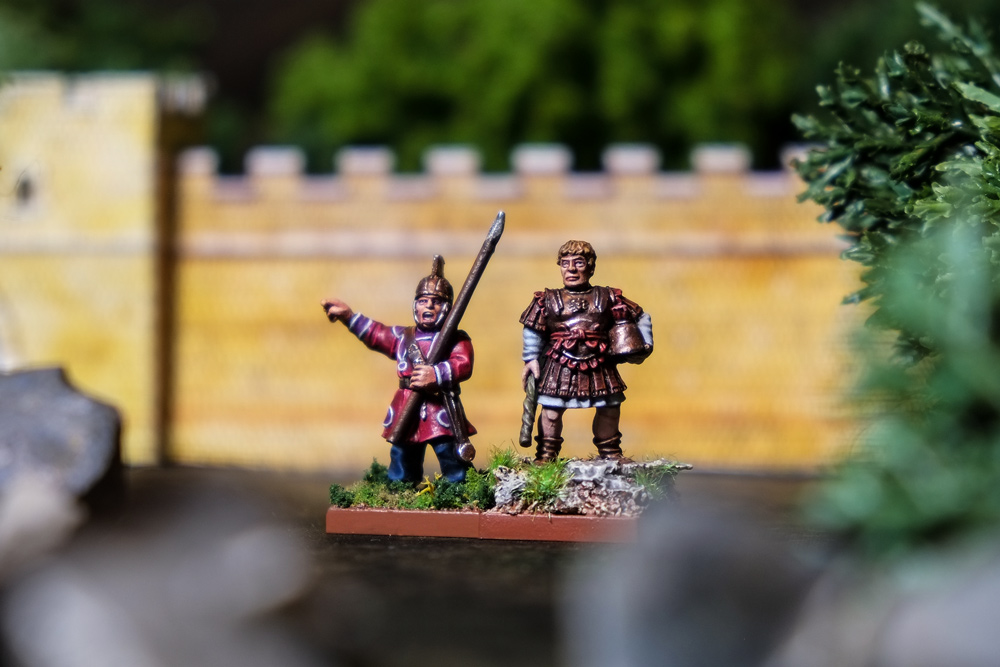
"Wasn't like this in Sulla's day, eh?"
|
|
|
|
 |
 |
![[Post New]](/s/i/i.gif) 2018/05/08 14:32:05
Subject: Curis' Normans and Medievals
|
 |

Regular Dakkanaut
|
This is “Biscuit Dude”, and he’s come to fight you with his sock dragon. He’s my first painted miniature of 2018, and it’s exactly thirty years since he was released.
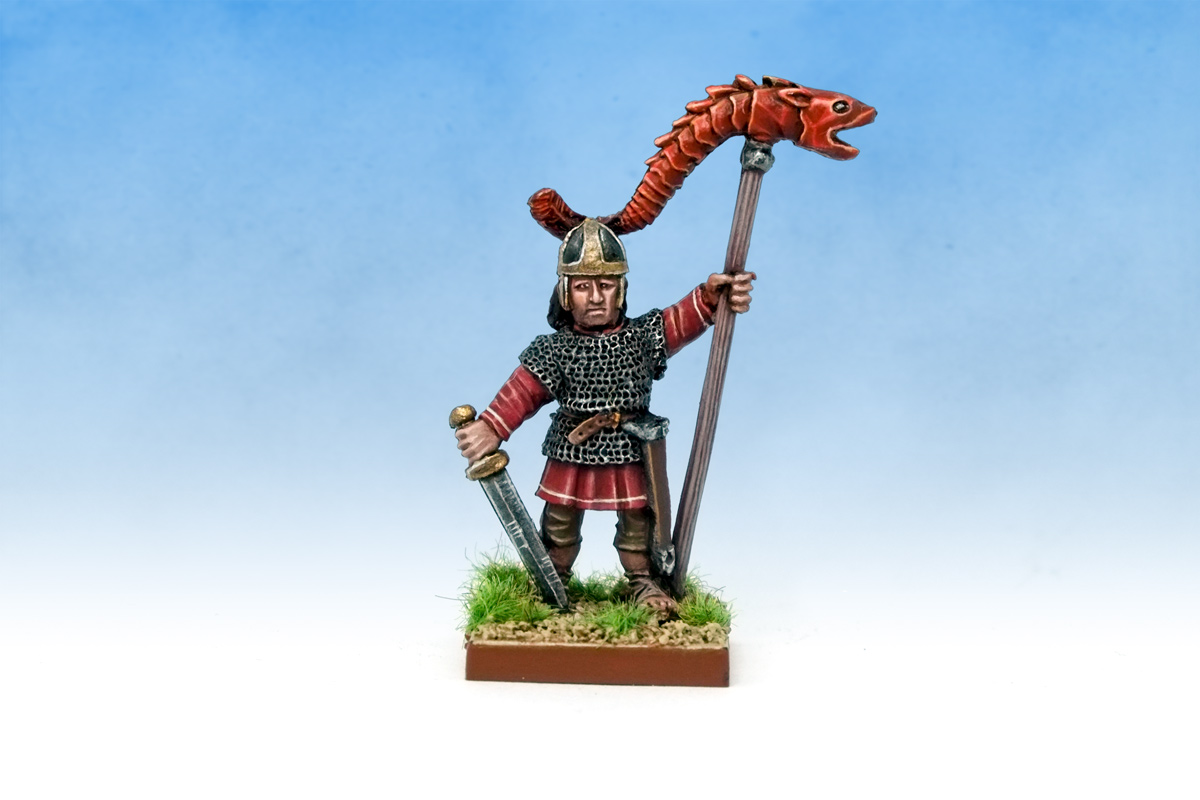 Rock out with your (dragon) sock out.
Rock out with your (dragon) sock out.
“Biscuit Dude” is a Late Imperial Roman standard bearer, released by Citadel Miniatures in January 1988 as part of the Blandford Warriors range – twelve medieval(ish) characters also appearing in the 1987 Blandford Press book Medieval Warlords.
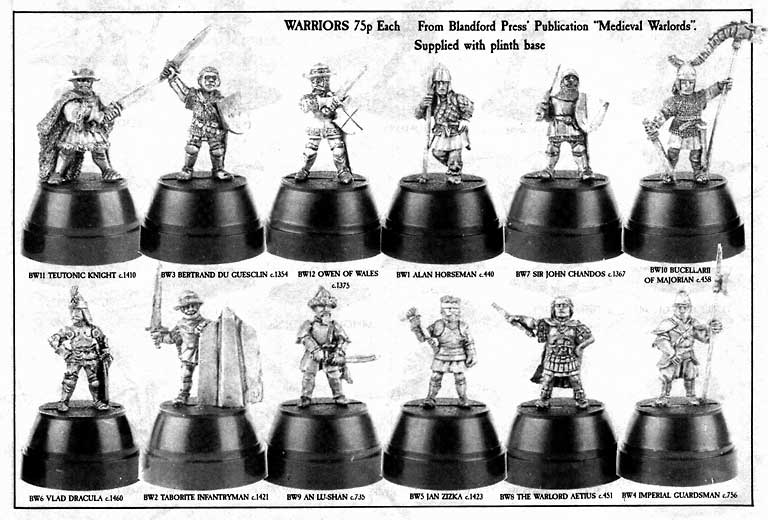 The complete Blandford Warriors range, image from Stuff of Legends
The complete Blandford Warriors range, image from Stuff of Legends
The range is a curious mix of generic fighters like “Teutonic Knight” (top left), and named personalities like “Betrand du Guesclin” (one in from top left). If you’re unfamiliar with medieval history it’s confusing who’s a character and who’s a unit type – Alan Horseman, I am looking at you.
Looking at the name of the miniature on the flyer, I assumed “Bucellarii of Majorian” was a person, but turns out “bucellarii” (singular: “bucellarius”) is actually a name for the household troops in the Late Roman period. It’s Latin for “biscuit dude” – troops were so named as on campaign they were given their grain ration (or “bucellatum”) in the form of a hard biscuit. This kind of diminutive naming humour is common in the Late Imperial Roman military – the heavily armoured cavalry troops were called “clibanarii” or “little ovens” as it got so hot inside their armour.
I based the paintjob for my miniature off the Angus McBride colour plate from the Medieval Warlords book.
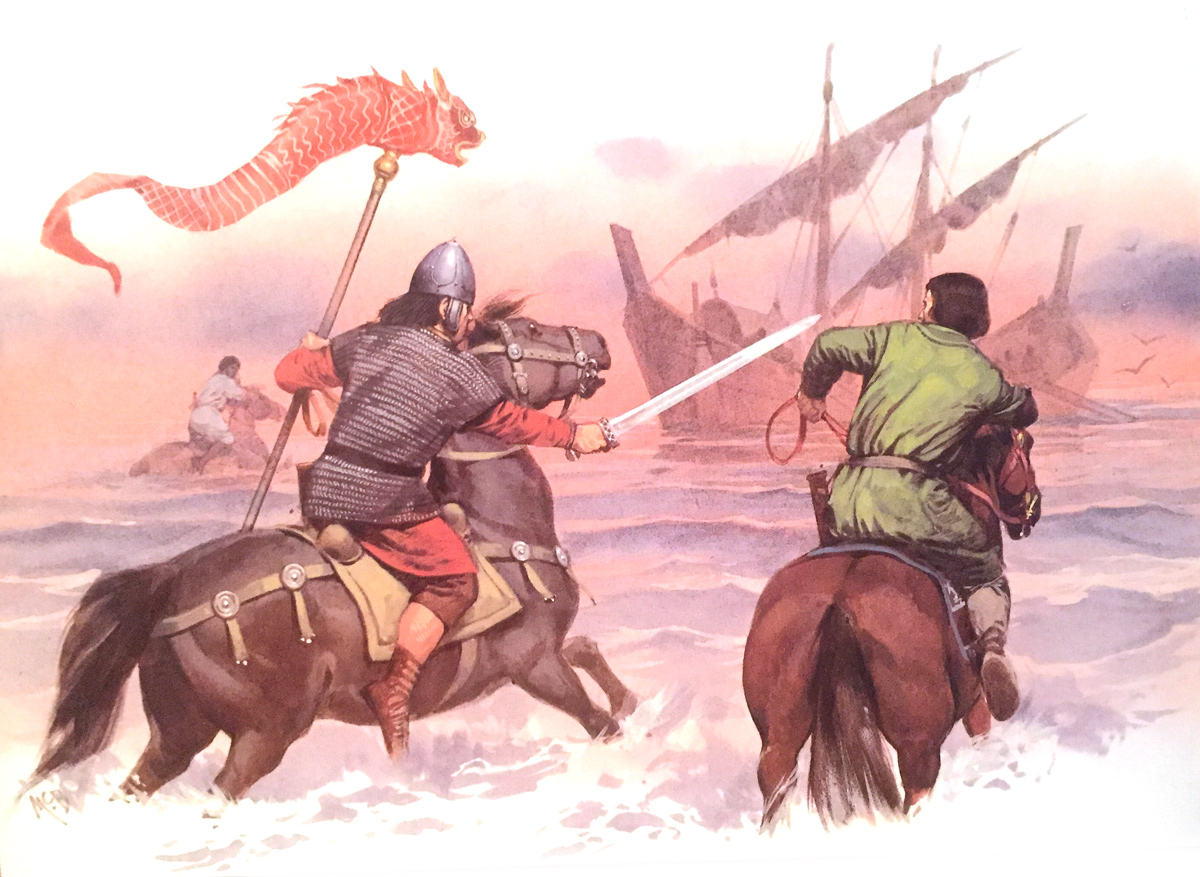 Vandal and Moorish pirates flee to their ship after an ambush set up by Biscuit Dude and his seahorse, Seabiscuit.
Vandal and Moorish pirates flee to their ship after an ambush set up by Biscuit Dude and his seahorse, Seabiscuit.
The Bucellarius fits really nicely into my fledgling Late Imperial Roman army, as will the two other fifth century Blandford Warriors – “The Warlord Aetius” and “Alan Horseman”. Here’s my mighty army so far, needing a lot of reinforcements before they get that Warhammer Ancient Battles +1 rank bonus.
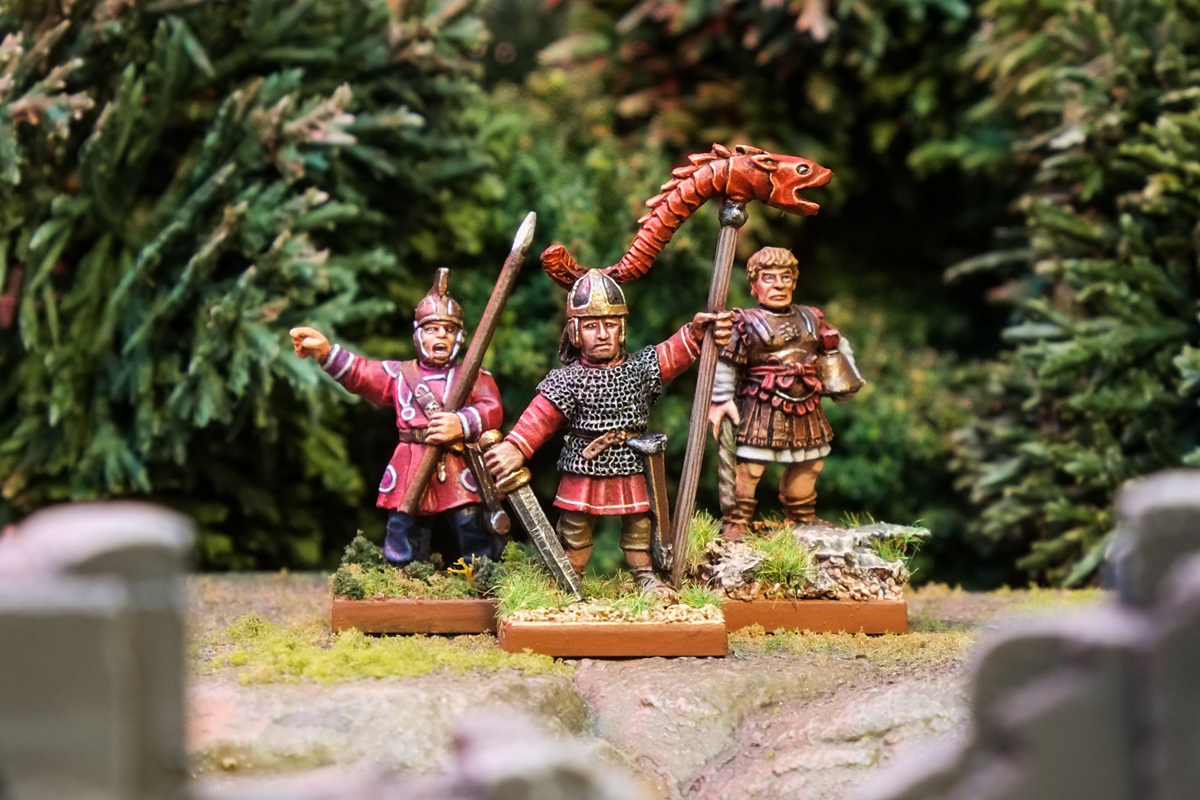 The mighty Triumverate of Maximianus, Biscuit Dude and Araneus.
The mighty Triumverate of Maximianus, Biscuit Dude and Araneus.
The complete set of twelve Blandford Warriors miniatures was re-released last summer by Wargames Foundry, so now everyone can own them without paying ridiculous prices on the secondary market.
|
|
|
|
 |
 |
![[Post New]](/s/i/i.gif) 2018/05/09 11:21:20
Subject: Curis' Normans and Medievals
|
 |

Regular Dakkanaut
|
With Britannia on the telly, I’m fired up for Roman Britain. The Emperor’s finest stabbing druids has given me the focus to paint these eight Late Imperial Roman spearmen.
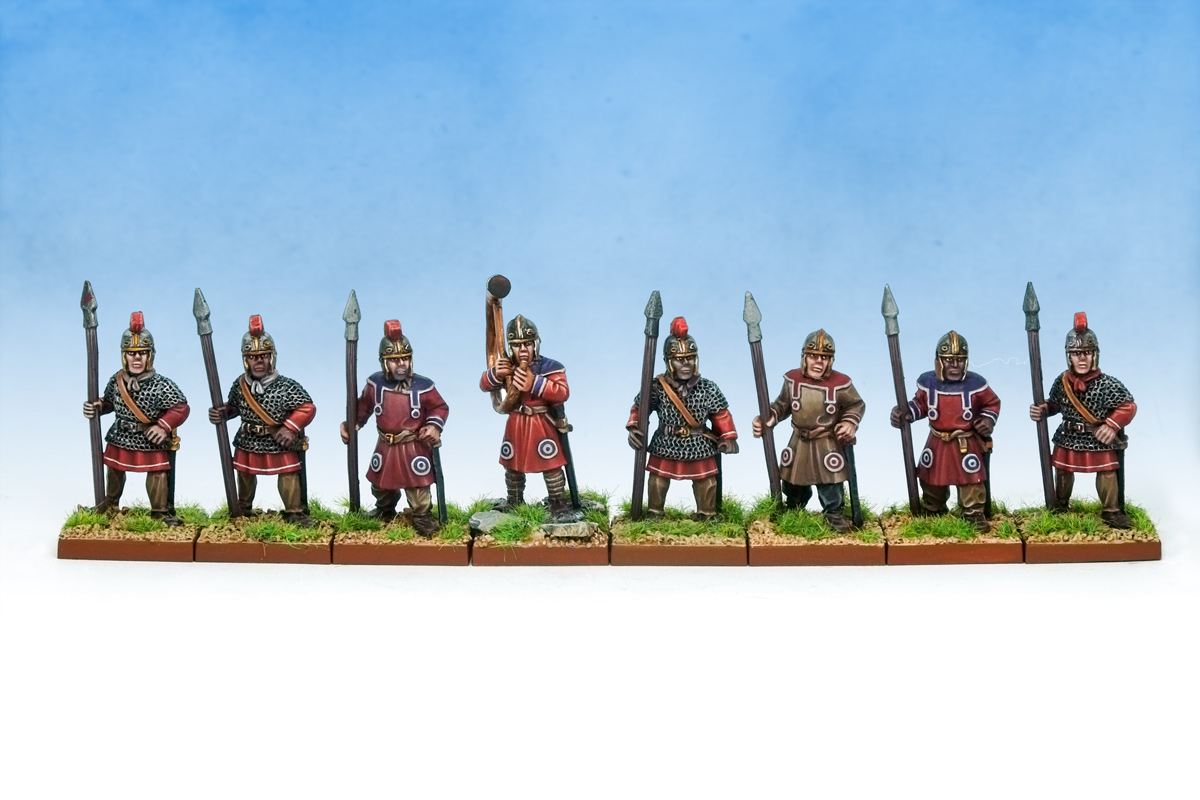 “Hurdy gurdy, hurdy gurdy, hurdy gurdy gurdy,” they sang.
“Hurdy gurdy, hurdy gurdy, hurdy gurdy gurdy,” they sang.
Late Imperial Romans? Late for what? They’d better hurry up and carpe those diems. The Late Imperial period, for me, covers everything from Septimius Severus as Emperor ( AD 193–8), the Crisis of the Third Century ( AD 235-84), the Barbarian Conspiracy ( AD 376–7), the Roman Exit from Britain ( AD 410), Flavius Aetius versus Atilla ( AD 452), the Fall of the Western Roman Empire ( AD 476), and beyond into the time of King Arthur. The army gives me a lot of history to play with and a lot of excuses to visit knee-high ruined walls in the rainy English countryside.
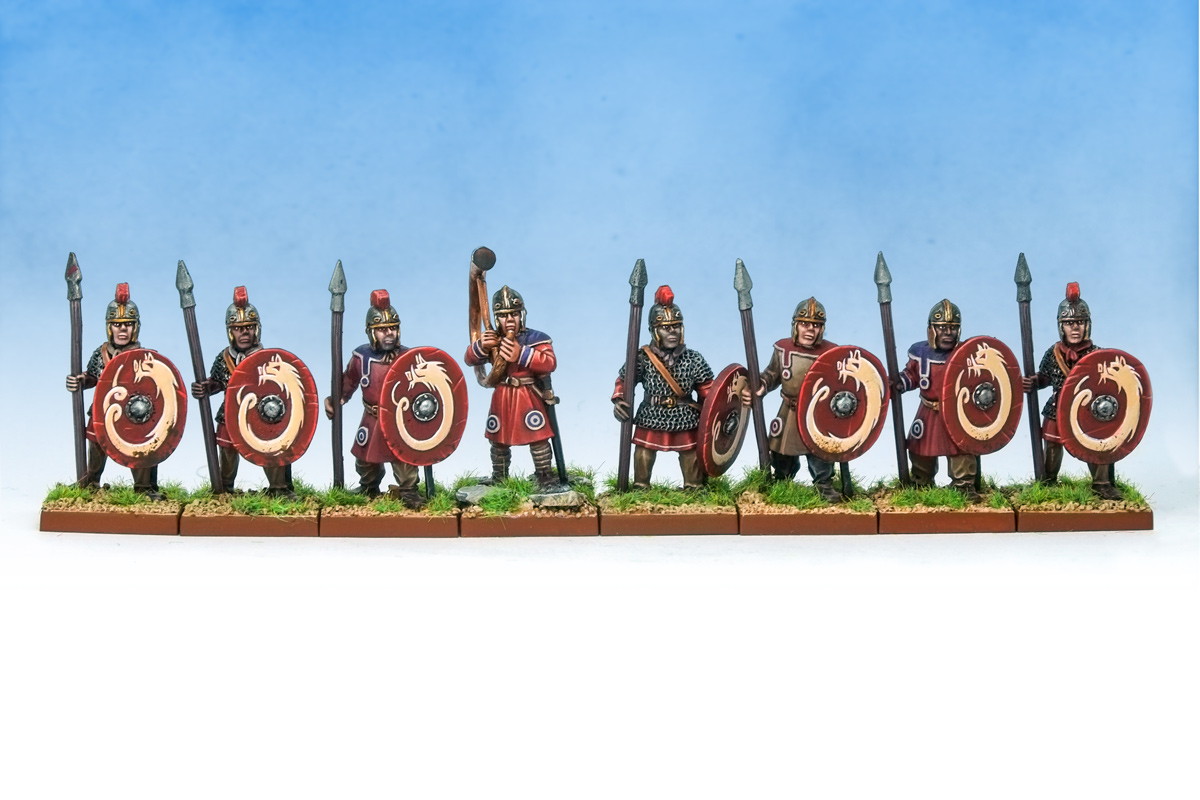 “Roly poly, roly poly, holy poly poly,” they sang.
“Roly poly, roly poly, holy poly poly,” they sang.
I invented a mythical beast to paint freehand onto the unit’s shields – the ophiosus. It’s a creature with the head of a pig and the body of a snake. The component animals might, based on the altar below, be symbolic of Veteris – thought to be the god of Hadrian’s Wall. If you like you can call the creature a “boar constrictor”.
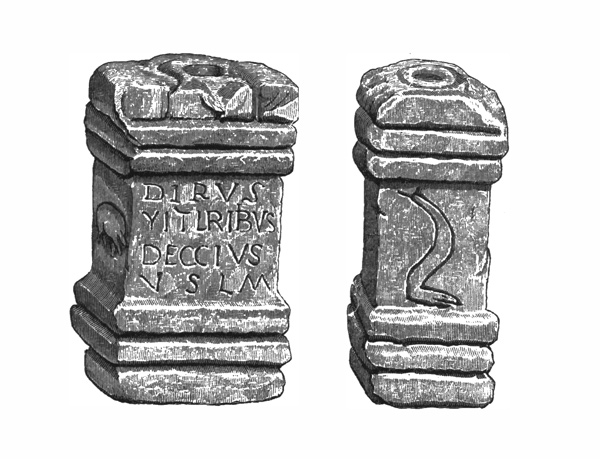 An altar found at the Roman fort of Magnae Carvetiorum, with a pig and a snake carved into opposite sides. RIB1805.
An altar found at the Roman fort of Magnae Carvetiorum, with a pig and a snake carved into opposite sides. RIB1805.
The first shield took several hours to do – from idea through to pencil sketch then freehand painting. The next shields I batch-painted and they took about 45 minutes on average. I experimented with a couple of variations from shield to shield, refining it as I went. The minor variations in design I rationalise along with the different armour styles I’ve mixed together.
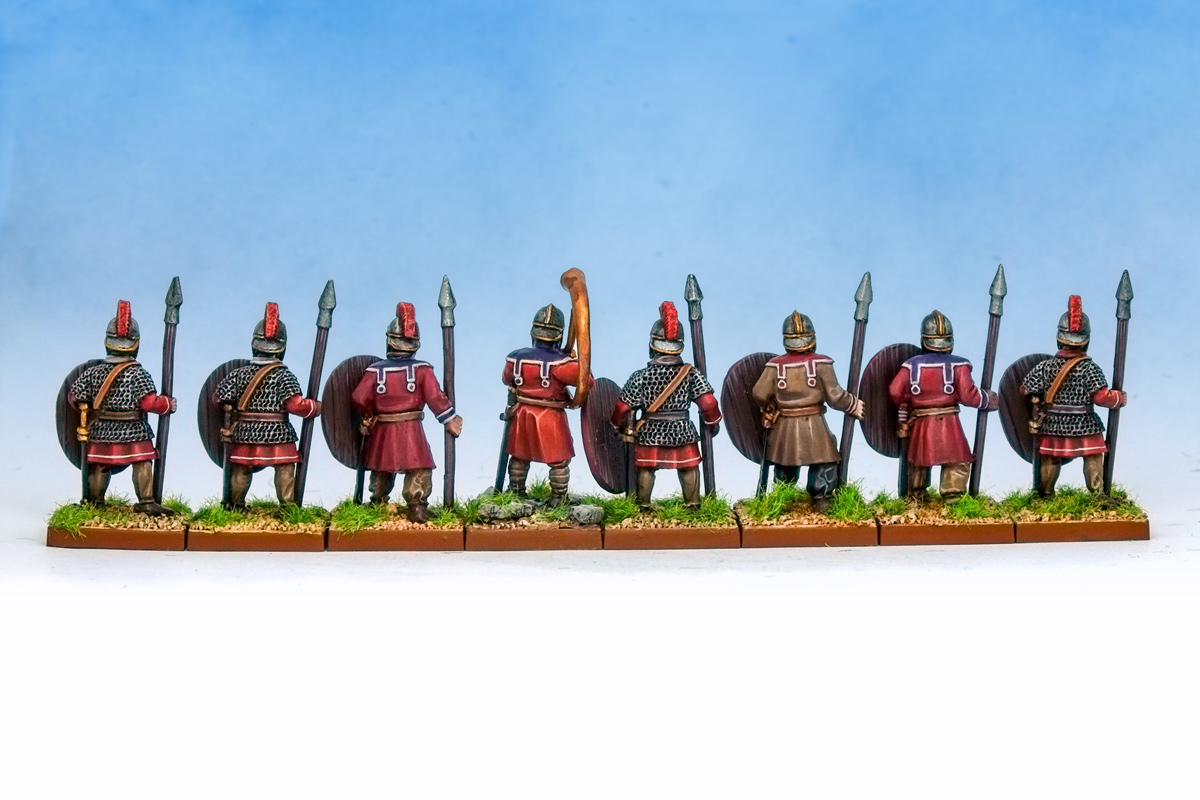 “Derpy merpy, derpy merpy, slurpy merpy merpy,” they sang.
“Derpy merpy, derpy merpy, slurpy merpy merpy,” they sang.
The miniatures are from Crusader Miniatures, and are satisfying for army building as they’re one piece castings (with separate shields). I worked on them as a batch of eight, imagining them as a contubernium – the smallest organisational unit of the Roman army who all shared a tent or barrack room together. Conveniently it’s also an instantly game legal unit for Saga’s Aetius & Arthur. Eight is enough figures to make me feel like I’m making progress on a significant chunk of infantry, while not causing burn out.
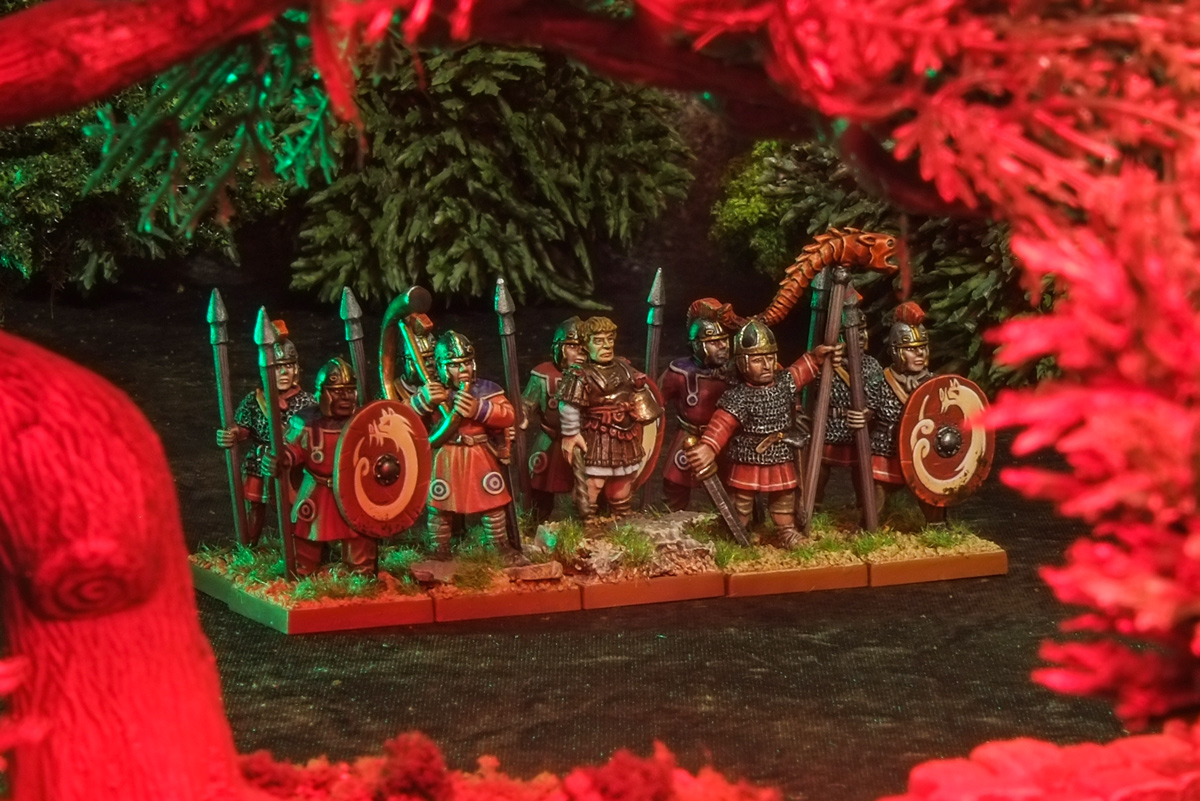 “Sminky pinky, sminky pinky, sminky pinky pinky,” they sang.
“Sminky pinky, sminky pinky, sminky pinky pinky,” they sang.
Congratulations for getting to the end of this post. As a special reward, let me tell you about a marvellously named woman. She discovered another altar dedicated to Veteris, and her name was “Miss Fanny Bacon”.
|
|
|
|
 |
 |
![[Post New]](/s/i/i.gif) 2018/05/10 07:12:17
Subject: Curis' Normans and Medievals
|
 |

Regular Dakkanaut
|
As names for ranges go, “Blandford Warriors” is a little … underwhelming. Rather than conjuring up images of medieval warlords on their bloodthirsty rampages it puts me instantly in mind of the sleepy Dorset village – Blandford. Blandford’s top tourist attraction is a museum with a diorama of the 1731 Great Fire of Blandford. Blandford is a bland name. A dull name. A boring name. This feeling of deep ennui also manifests in the pose of the second miniature I’ve painted – Alan Horseman.
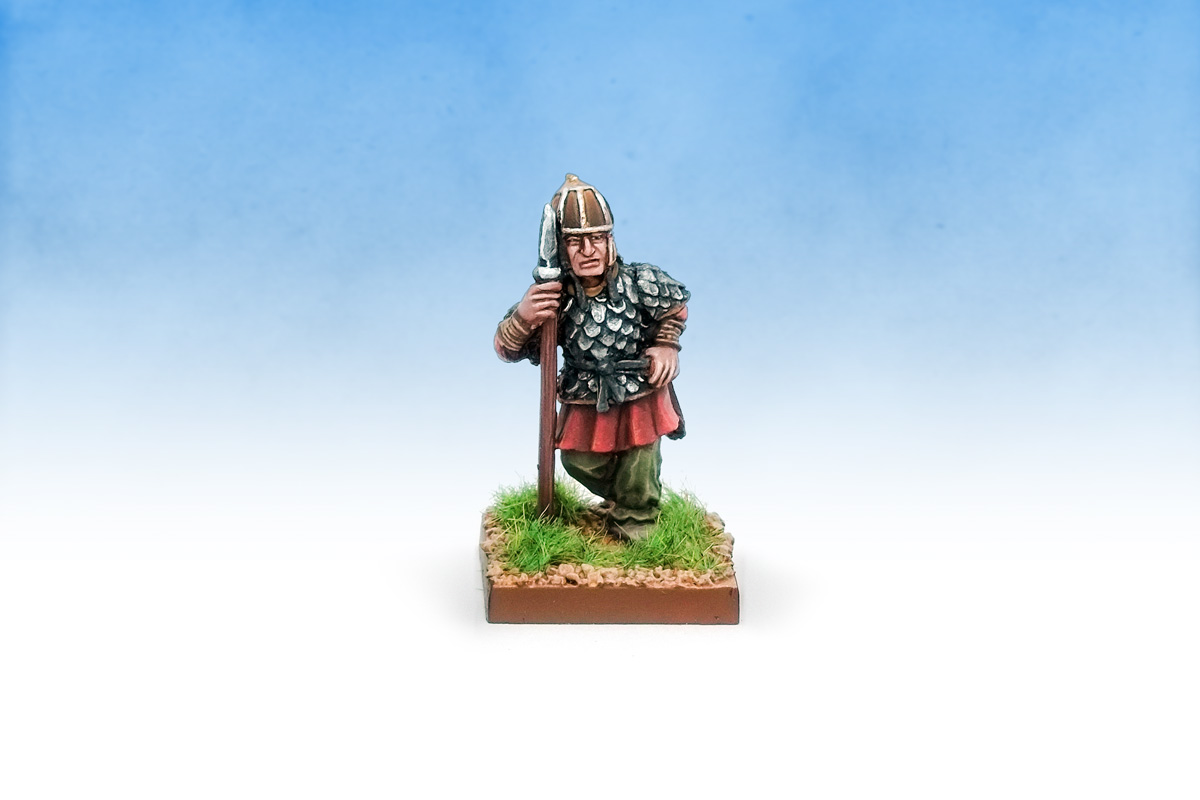 “This spear has a point. Unlike my life. Sigh”
“This spear has a point. Unlike my life. Sigh”
Even the name, Alan Horseman, oozes boredom. It’s one of those historical terms, like “Norman Shields”, that doubles as the personal name of a twenty-first century dullard. I imagine it painted on the side of a white van – “Alan Horseman Electrical Contractor”. Of course, the Alans were a tribe of fierce warrior horsemen instrumental in the defeat of Atilla the Hun. Here’s the Angus McBride colour plate from Medieval Warlords of this Alan getting around on his horse and not a Ford Transit
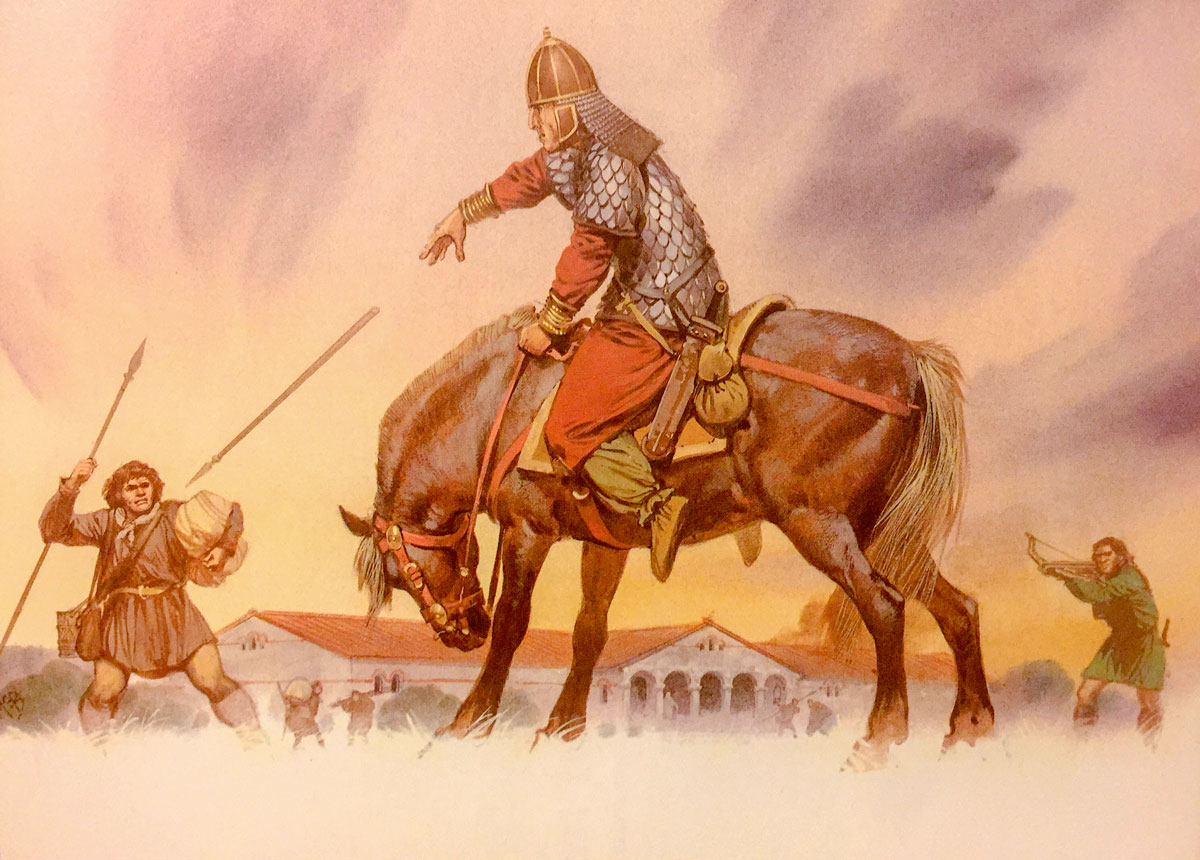 Alan Horseman of Orleans, on the orders of Aetius, clashes with bacudae on an estate in eastern Brittany, 440s. Sigh.
Alan Horseman of Orleans, on the orders of Aetius, clashes with bacudae on an estate in eastern Brittany, 440s. Sigh.
Coincidentally the colours Angus chose and I copied match my Late Roman Comitatenses – so I can roll Alan in to that collection. Late Imperial Roman armies relied heavily on barbarian troops ( foederati) such as the Alans as their military manpower dwindled in the 4th and 5th centuries. Flavius Aetius let the Alans, originally from North Caucasus, settle in parts of Ancient France in return for providing fighters. It was a clever policy for Rome as it motivated the tribe to fight not out of abstract loyalty to Rome, but in defence of their newly-acquired land and accompanying wealth.
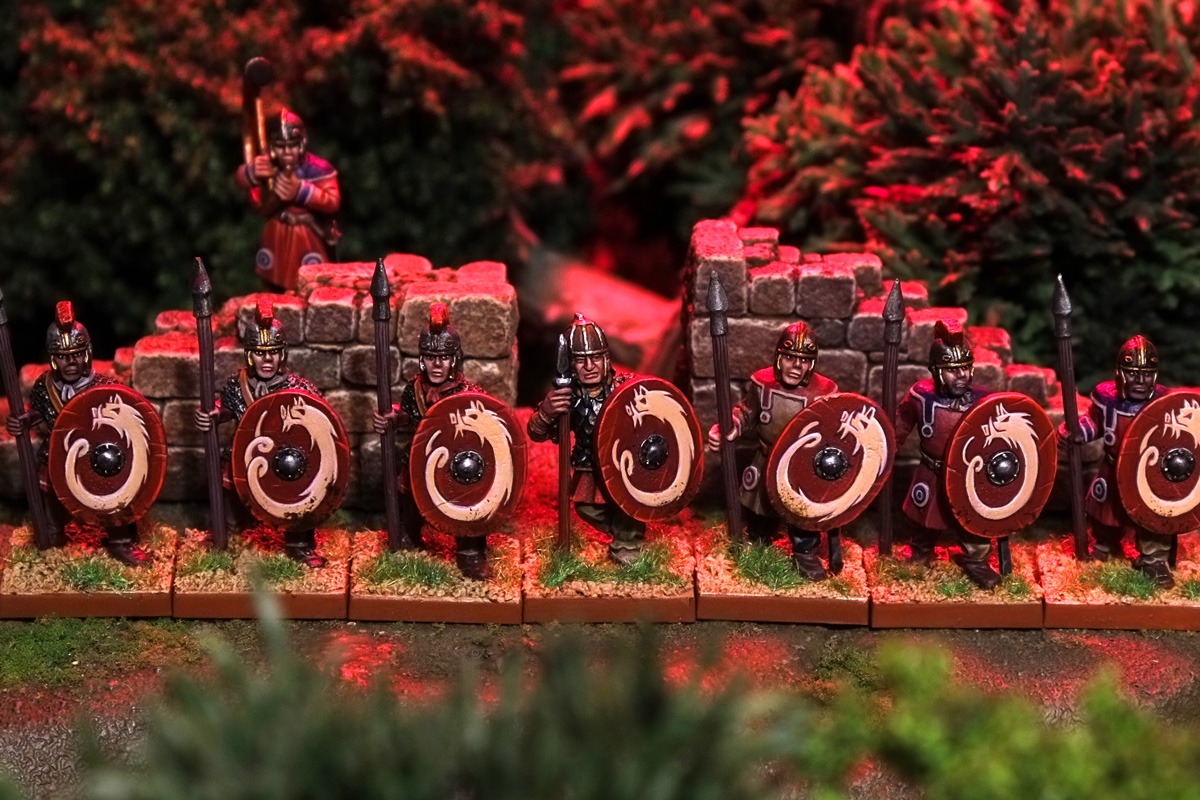 Late Imperial Romans forming a shield wall in the ruins of the partially demolished Epiacum. Sigh.
Late Imperial Romans forming a shield wall in the ruins of the partially demolished Epiacum. Sigh.
The walls in the above shot are from the excellent Fogou Models, more focus on them in a future blog post!
|
|
|
|
 |
 |
![[Post New]](/s/i/i.gif) 2018/05/10 07:35:49
Subject: Curis' Normans and Medievals
|
 |

Roarin' Runtherd
|
Some amazing painting here! Thanks for sharing.
|
|
|
 |
 |
![[Post New]](/s/i/i.gif) 2018/05/11 13:15:17
Subject: Curis' Normans and Medievals
|
 |

Regular Dakkanaut
|
Thanks Jez!
Arch-rivals from opposing sides of the Hundred Years’ War. Each of them a talented medieval commander, but with a great respect for the other’s skills and abilities. Presenting two classic Citadel Miniatures – Sir John Chandos and Bertrand du Guesclin.
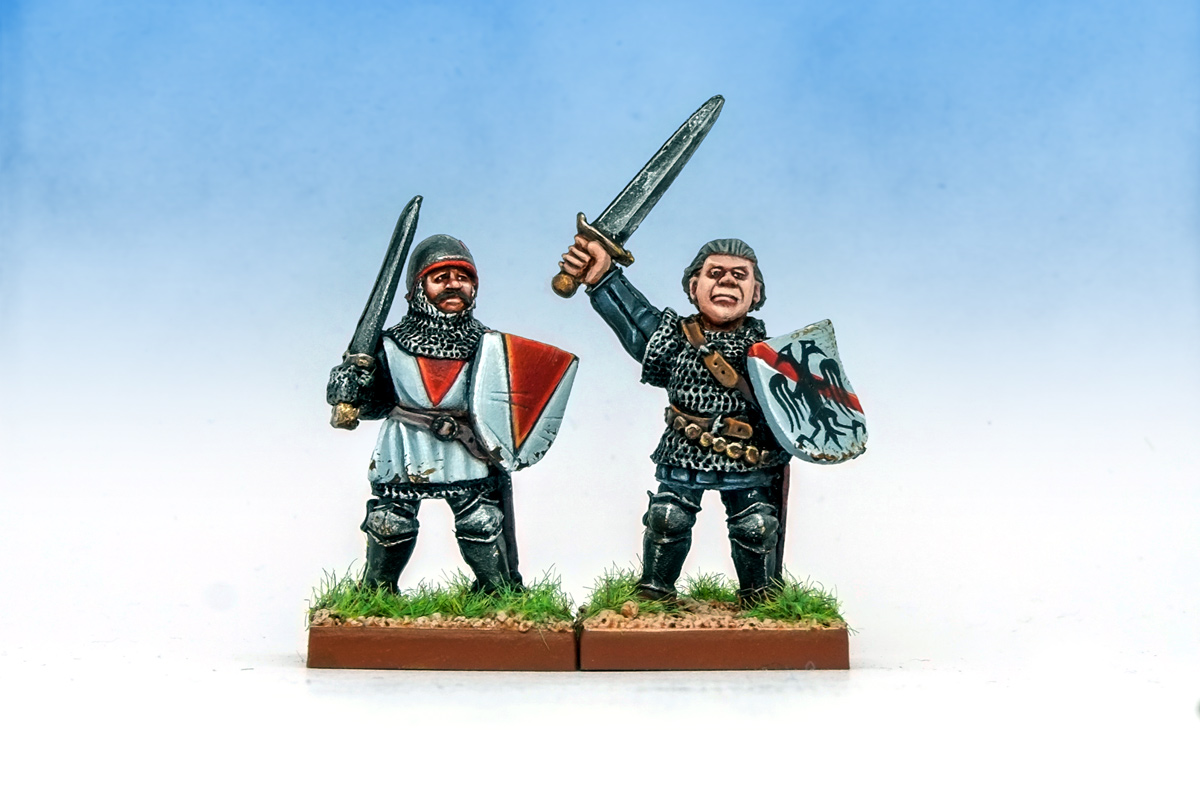 English commander Sir John Chandos and French commander Bertrand du Guesclin.
English commander Sir John Chandos and French commander Bertrand du Guesclin.
I like how different the miniatures are to each other. Chandos is depicted as a classic knight in shining armour, with his “sharp pile gules” (a medieval way of saying “upside down red triangle”) heraldry sculpted onto both his tabard and shield. His chainmail coif and fine moustache mark him out as a gentleman. In contrast, du Guesclin with his black Breton eagle is a scruffy bugger with his bare head and loose-fitting straps. Du Guesclin was a low-born brawler who started his career as a marauder, ambushing people in the forests of Brittany. His equipment was reputedly in such poor condition he was sometimes mistaken for a common brigrand rather than a knight. When the pair first met, Chandos lent du Guesclin his own armour and horse, as du Guesclin’s own kit wasn’t nice enough to be seen duelling in.
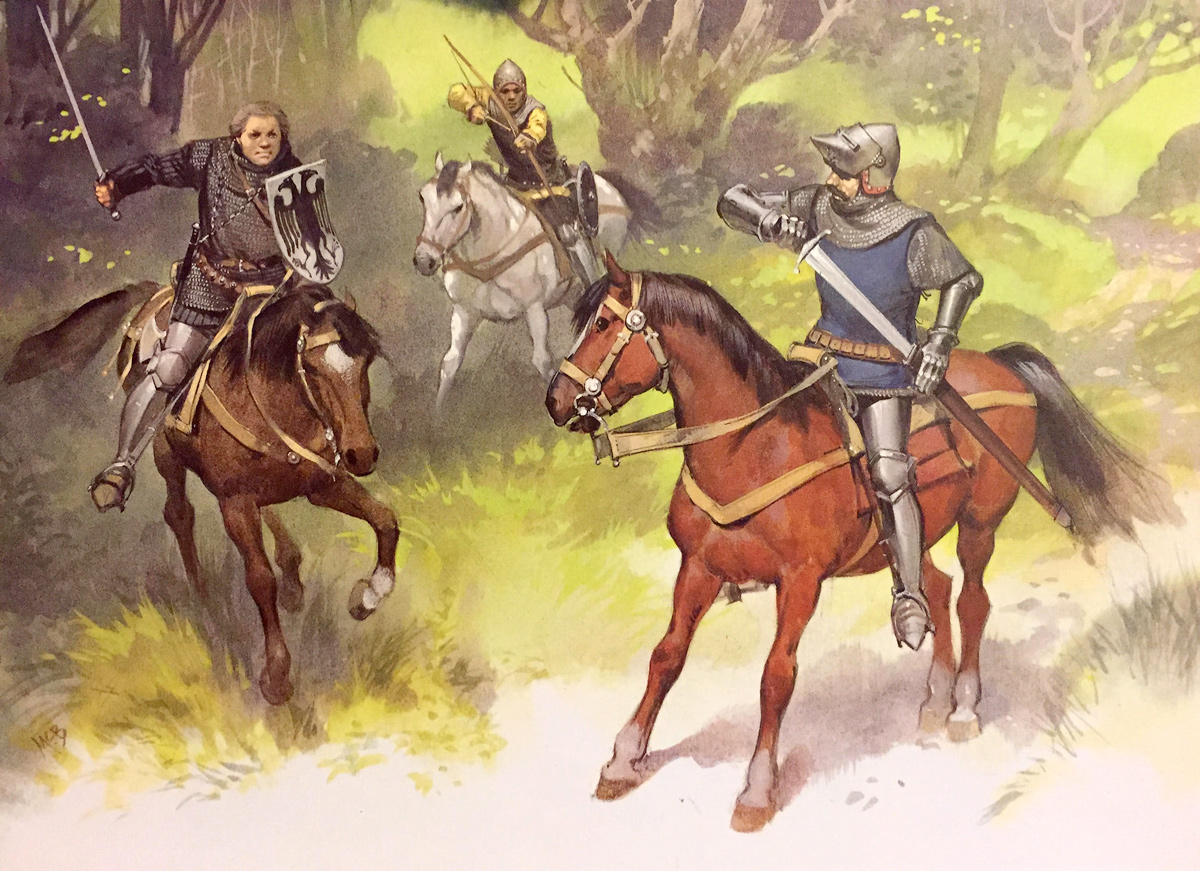 Bertand du Guesclin and his retainers surprising men-at-arms of Sir High Calverly on the road to Montmuran, Brittany, 1354.
Bertand du Guesclin and his retainers surprising men-at-arms of Sir High Calverly on the road to Montmuran, Brittany, 1354.
The two men clashed on opposing sides of the Battle of Auray in 1364. The French were defeated, and du Guesclin taken prisoner by Chandos. France quickly paid his 40,000 florins ransom as they were keen for him to command an expedition to assist in the Castilian Civil War. Guesclin invited Chandos along with him to Castile, a sign the two men had grown into friends, though Chandos declined.
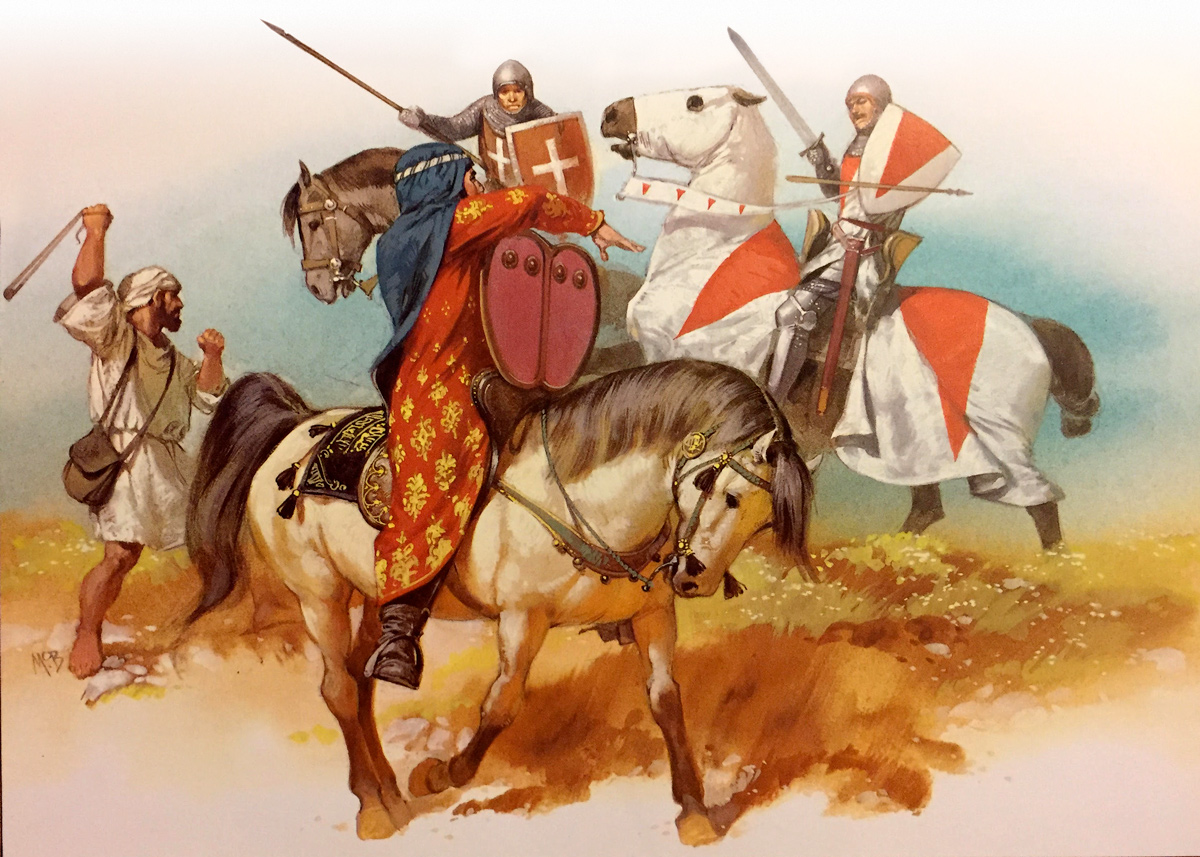 Sir John Chandos is harassed by Moorish genitors in the army of Henry Castile at the battle of Nájera, northern Spain, 1367.
Sir John Chandos is harassed by Moorish genitors in the army of Henry Castile at the battle of Nájera, northern Spain, 1367.
The pair also fought on opposing sides at the Battle of Nájera in 1367. Again the French were defeated and again du Guesclin was taken prisoner by Chandos. Again France were eager to have him back and paid a massive 100,000 francs.
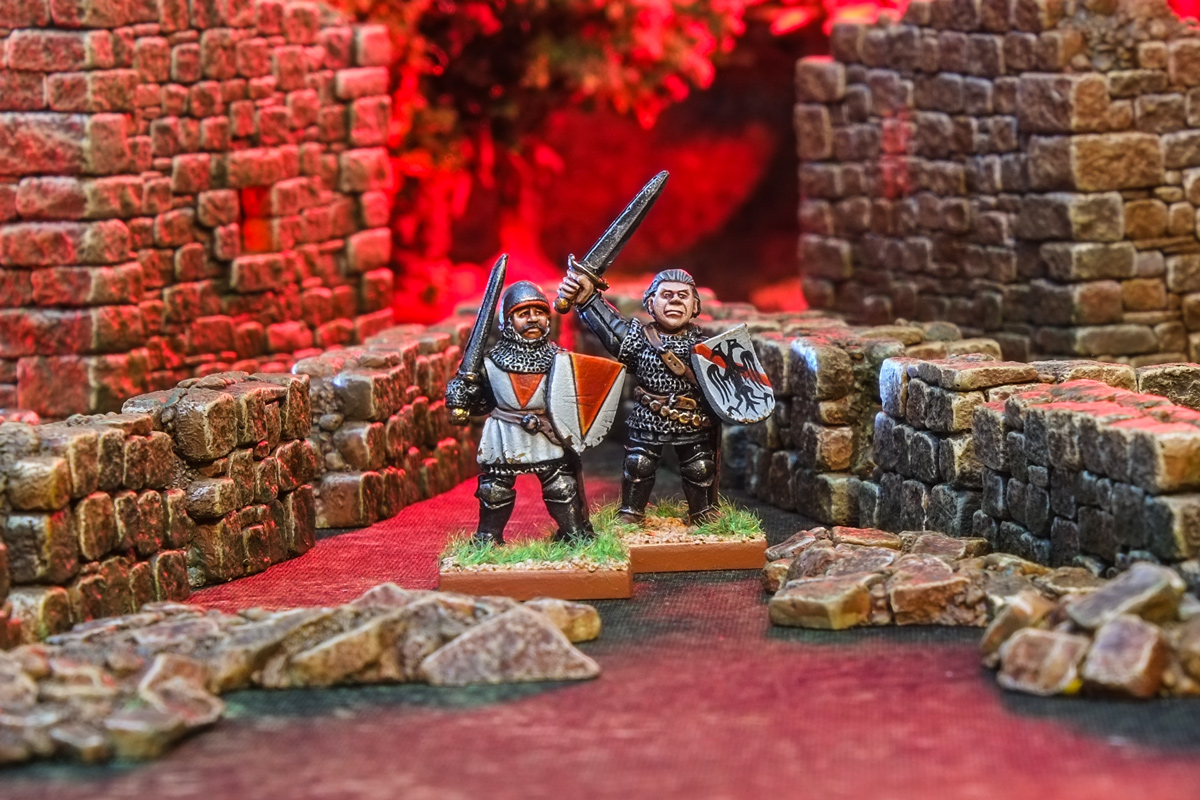 Chandos and du Guesclin in the crumbling Burgundian ruins of Grenoble.
Chandos and du Guesclin in the crumbling Burgundian ruins of Grenoble.
The walls of Grenoble in the picture above are from an upcoming Kickstarter from Fogou Models. I’ve been gifted a set to paint ahead of the campaign, and they’ve been an absolute joy to drybrush and weather up. Expect to see a lot more photographs of them in the future.
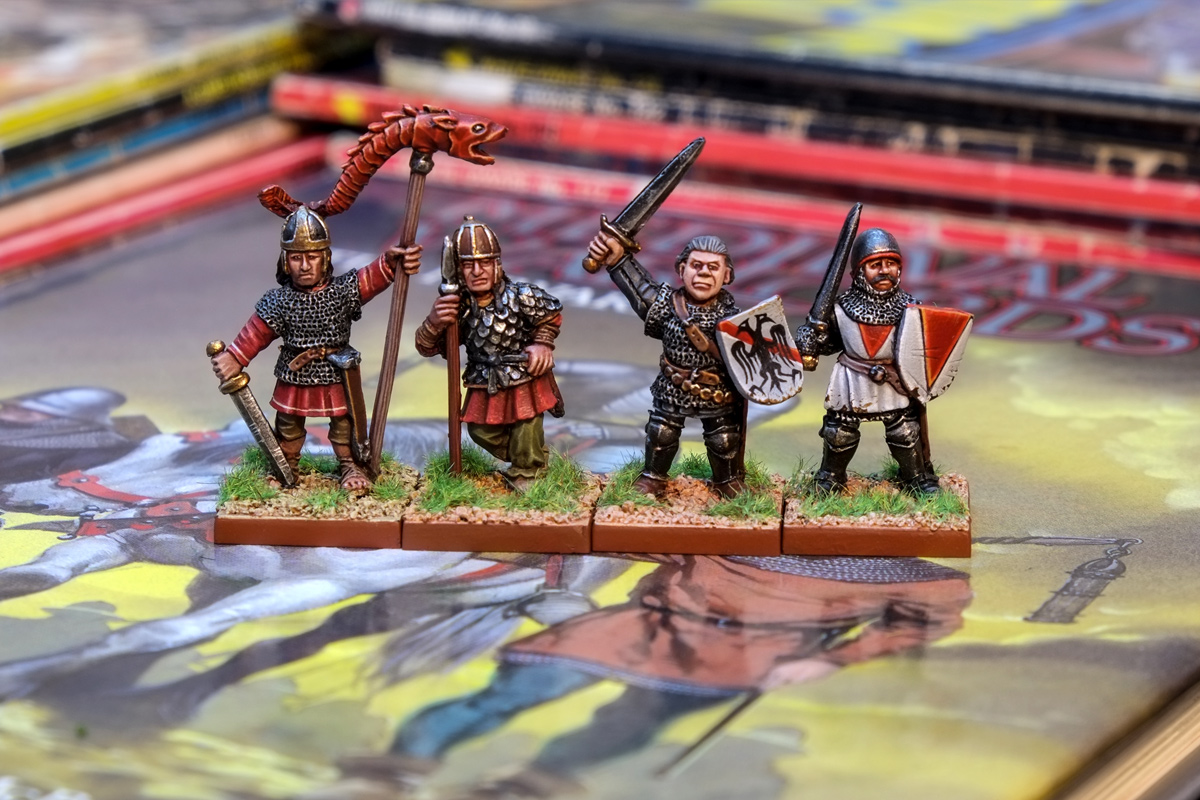 Left to right: Biscuit Dude, Alan Horseman, Bertand du Guesclin and Sir John Chandos.
Left to right: Biscuit Dude, Alan Horseman, Bertand du Guesclin and Sir John Chandos.
That’s one third of the Blandford Warriors painted now! I’m hoping to get all twelve finished for Bring out Your Lead in August – they were last year’s reissue and want to buy this year’s without any lead-guilt. Next up, we’ll be going in to the Hussite Wars.
|
|
|
|
 |
 |
![[Post New]](/s/i/i.gif) 2018/05/12 11:19:48
Subject: Re:Curis' Normans and Medievals
|
 |

Battlefield Tourist
|
WTF!!! How has this awesome blog not got more comments? I love your painting, it's so clean, bright and bold. Absolutely stunning to look at. But your photography is really excellent too - the shot of the church is amazing. I've been grinning away reading your posts too. Awesome. And the art reference pieces and stuff...this is what all our blogs should aspire to. Absolutely great work! It's such a shame that any non-Warhammer blogs get so little traffic and comment here. Yours deserves much more recognition.
|
|
|
|
 |
 |
![[Post New]](/s/i/i.gif) 2018/05/12 21:39:10
Subject: Re:Curis' Normans and Medievals
|
 |

Druid Warder
|
Some are still looking for words, apparently. 
Thumbs up and all that! Great paintwork and wonderful presentation.
|
Painting progress tracker:
2017: 50 of 50 planned; 2018: 80 of 60 planned; 2019: 75 of 75 planned
Pledge 2020:
6 to sculpt, 75 to paint (2/57 done) |
|
|
 |
 |
![[Post New]](/s/i/i.gif) 2018/05/12 22:09:07
Subject: Curis' Normans and Medievals
|
 |

Crushing Black Templar Crusader Pilot
|
Some great work here, I too am amazed at the lack of comments
|
  
Relapse wrote:
Baron, don't forget to talk about the SEALs and Marines you habitually beat up on 2 and 3 at a time, as you PM'd me about.
|
|
|
 |
 |
![[Post New]](/s/i/i.gif) 2018/05/18 12:48:55
Subject: Curis' Normans and Medievals
|
 |

Regular Dakkanaut
|
Thanks Da Boss! It's really heartening to know people read the posts, the painting takes a load of hobby time but writing it all up for public consumption takes a huge chunk again. Nice to know it's worth it! Generally though, I find forums are much quieter places these days, and most online hobbyists have switched to Facebook instead, which is a crying shame.
Cheers Wirecat! Cheers IGtR=!
If you’re into Czech action cinema you might already know Jan Žižka as the titular hero of the upcoming Jan Žižka film from director Petr Jákl – the man famous for films such as Pterodactyl and Born Into Shit. If you’re not, lemme walk you through this trio of classic 1988 Citadel Miniatures.
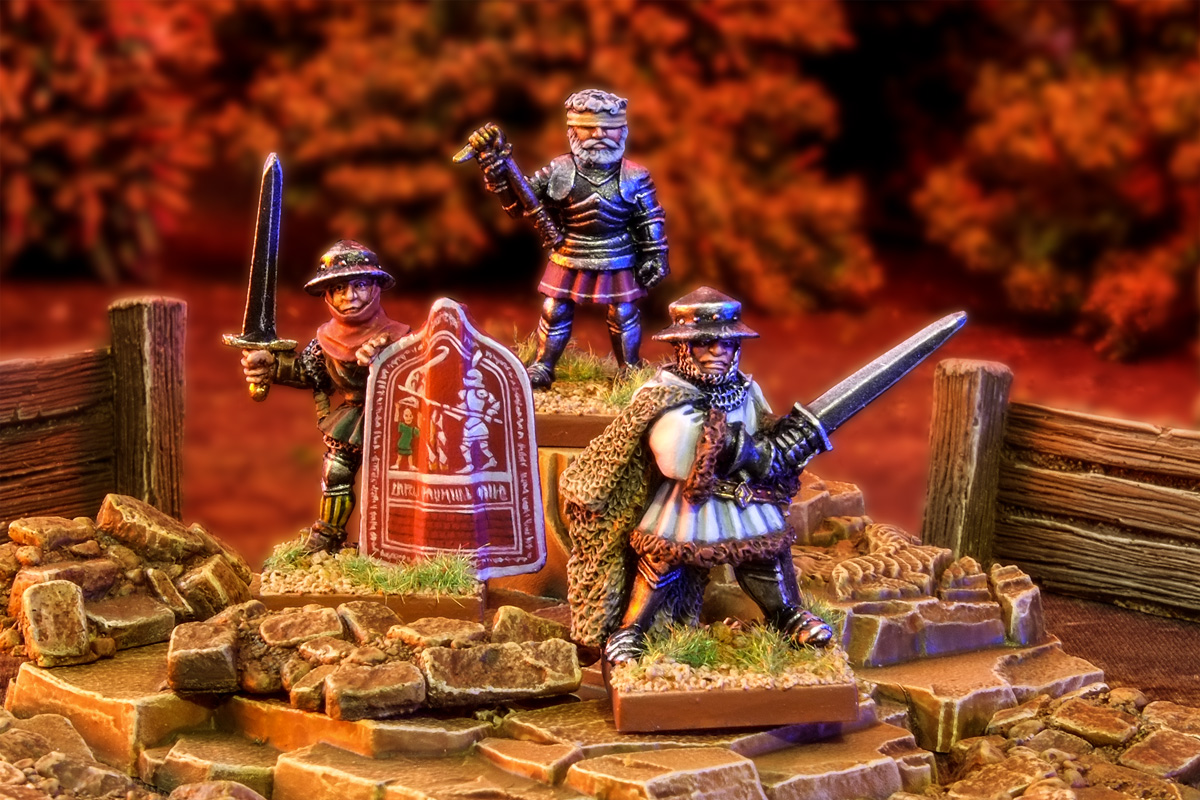 Left to right: Taborite Infantryman, Jan Žižka and Teutonic Knight.
Left to right: Taborite Infantryman, Jan Žižka and Teutonic Knight.
Who are these miniatures? Welcome to my history lesson. A wise man once said, “Those who do not learn history are doomed to repeat it.” And I don’t want you, dear reader, to be doomed to fighting in a series of 15th century Eastern European wars.
Teutonic Knight (1412)
The Teutonic Knight was, for many years, the Holy Grail for Blandford Warrior collectors. Wargames Foundry had quietly reissued the other eleven Blandford Warriors across a couple of blister packs, making Teutonic Knight the rarest. Luckily they brought him back in to production at Bring Out Your Lead 2017, so we johnny-come-latelies can be completists.
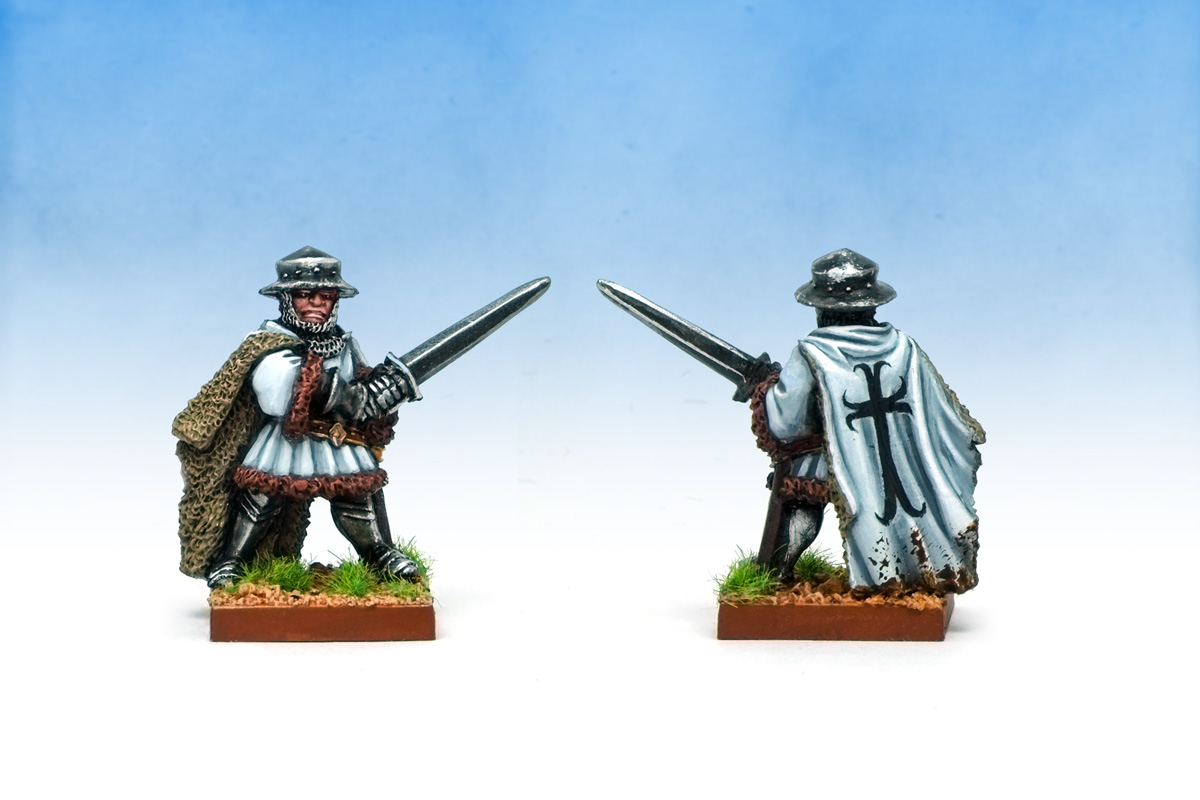 A literal white knight.
A literal white knight.
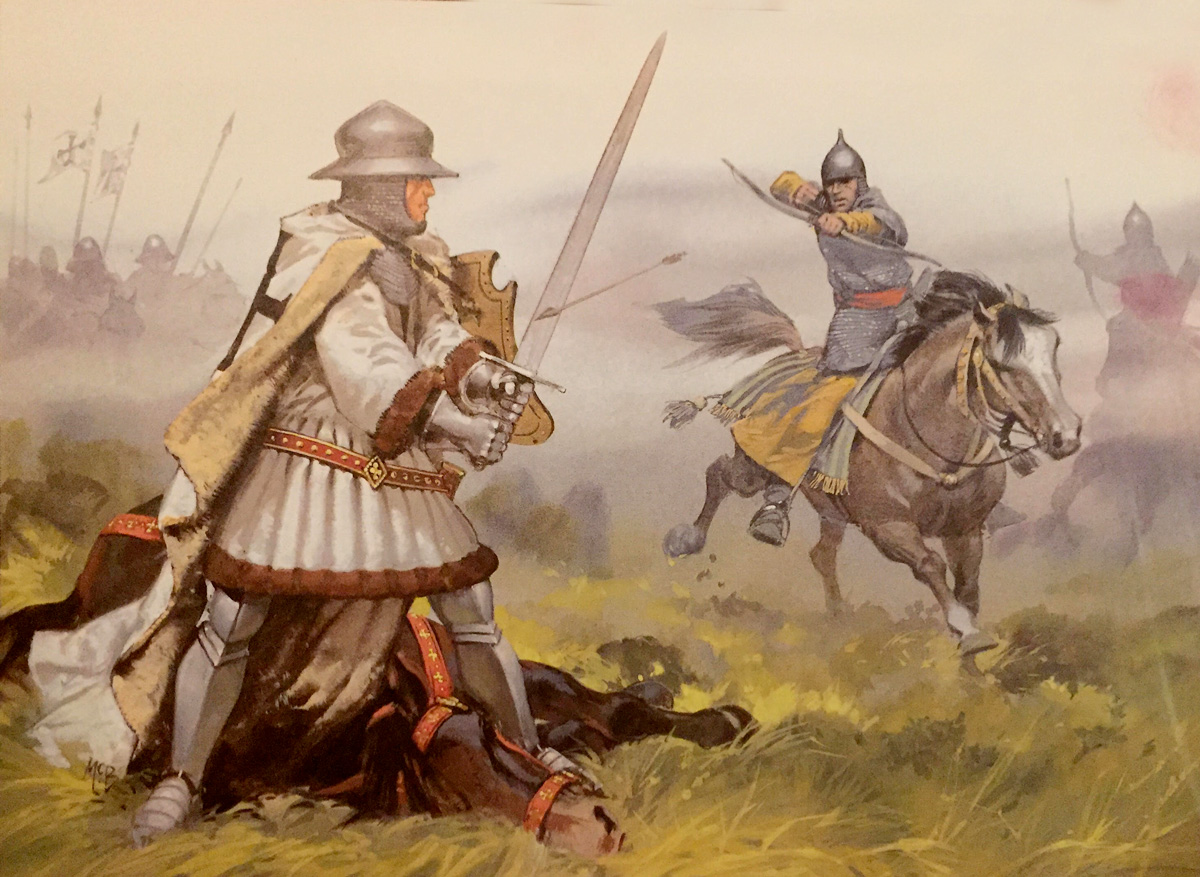 Teutonic knight attacked by Lithuanian horse-archers at the Battle of Tannenberg, 1410.
Teutonic knight attacked by Lithuanian horse-archers at the Battle of Tannenberg, 1410.
At the start of the 15th century the Teutonic Grand Order had turned its crusading ire on the Baltic peoples, and invaded Greater Poland. Against these Catholic invaders the Kingdom of Poland allied with the Grand Duchy of Lithuania and crushed them at the Battle of Tannenburg in 1410. A certain man was (probably) at that battle, and (maybe) got his left eye stabbed out of his face by the knights. This man was …
Jan Žižka
The cover star of the Medieval Warlords book. The Medieval Warlord. Angus McBride paints two colour pictures of him while medieval warlord Gaiseric, with his own whole chapter, gets none! Jan Žižka is sculpted as he would have appeared in 1423, after he lost his right eye to an arrow while besieging the castle of Rábí, and holding the famous fist-shaped mace he used in battle despite being totally blind.
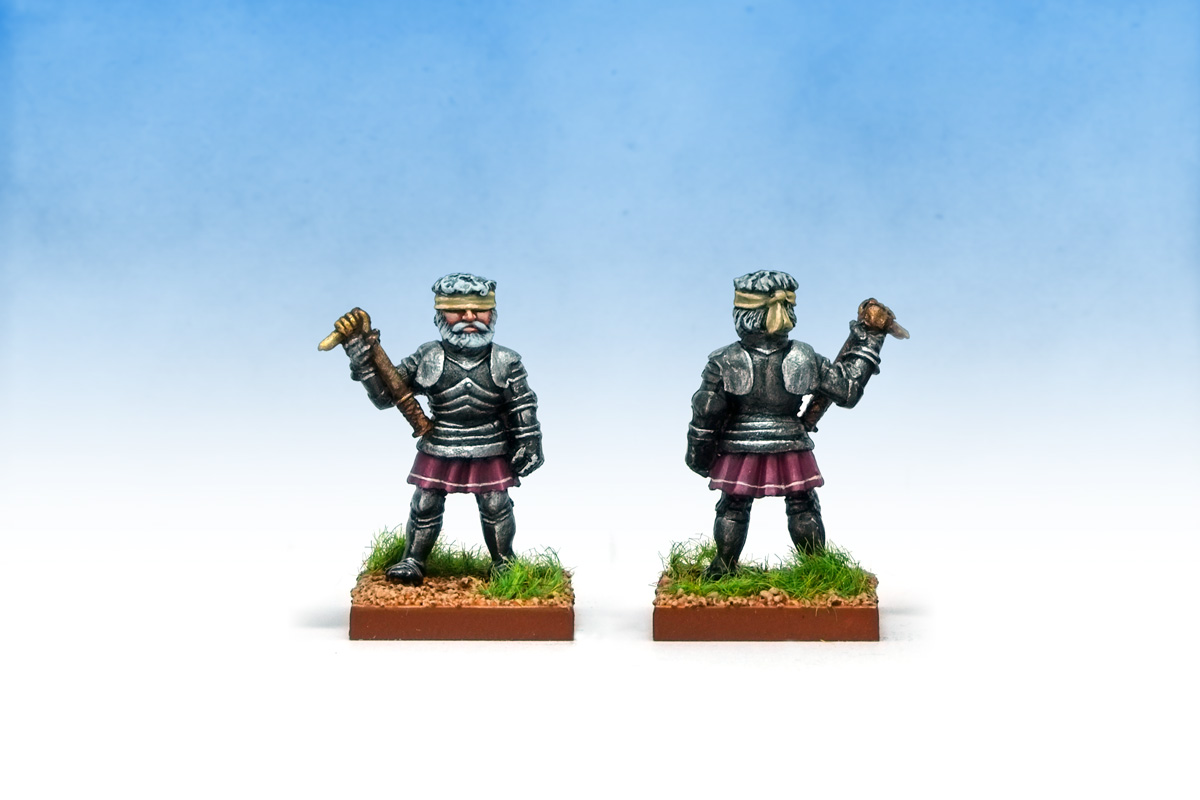 “No one’s ever really disabled so long as he has courage.” – Chip Chase
“No one’s ever really disabled so long as he has courage.” – Chip Chase
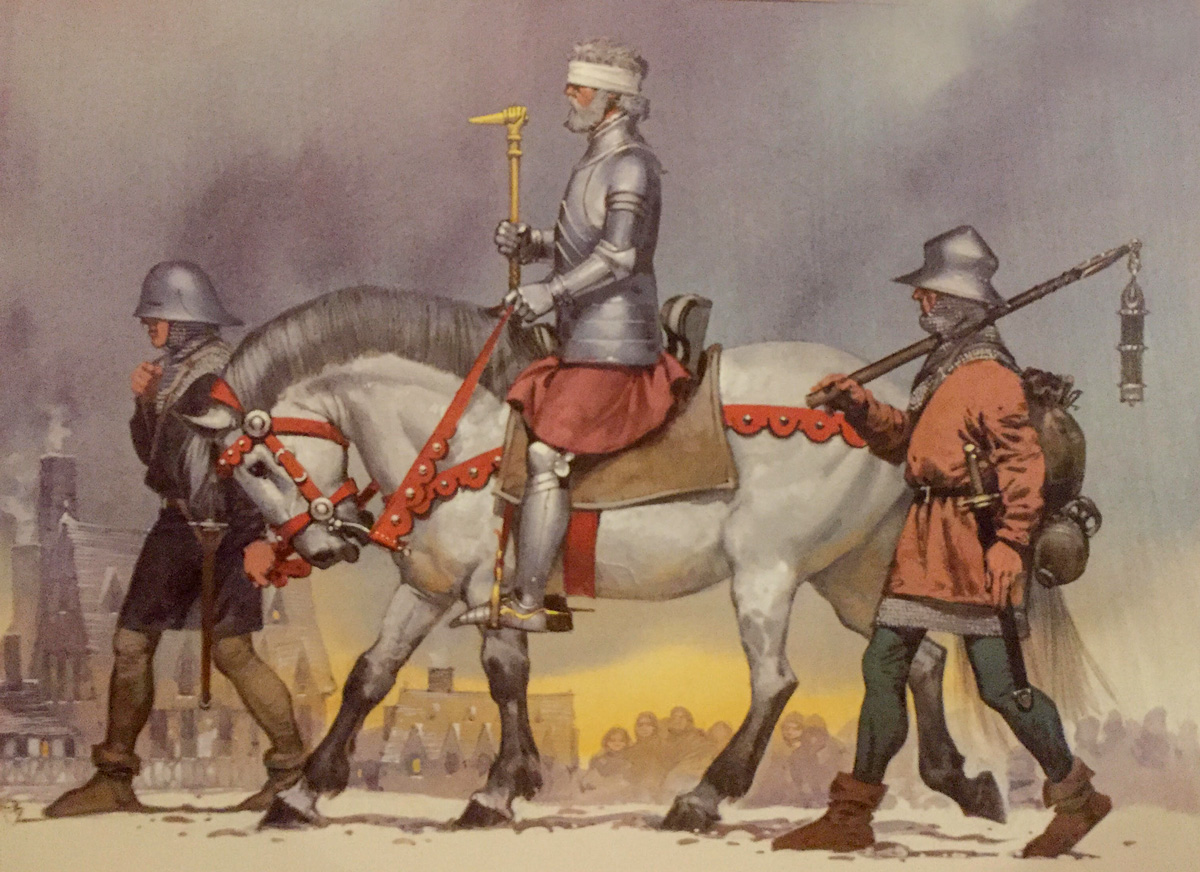 Jan Žižka enters Prague with his Orebite Warriors, 1421.
Jan Žižka enters Prague with his Orebite Warriors, 1421.
Jan Žižka was one of the greatest military leaders of all time. He was never defeated in battle. He invented the war wagon – the earliest form of tank warfare. He stood against the power of the Catholic Church and served as an inspiration for the Reformation a century later. After he died he asked to be flayed and have his skin used as a drum so he could continue to lead his followers into battle. What more can a man achieve in his life? (Fighting a Pterodactlyl?)
Dirty advertisement. Ninjabread continues below.
Who did Jan Žižka lead into battle? It was people like…
Taborite Infantryman
The Pope as the antichrist, attended by a large number of whores. The Pope celebrating mass, served by the devil, while an entourage of demons stand around the altar. These vivid religiously-charged images were served up by the Taborites, unhappy with the corruption of the medieval Catholic church, and wanting to spread their ideas to the illiterate peasant masses. For battle they decorated their shields similarly, like this tiny peasant behind earthworks squaring up to the Catholic knight – presumably evoking a David-and-Goliath narrative with the peasant’s sling and relative size of the combatants.
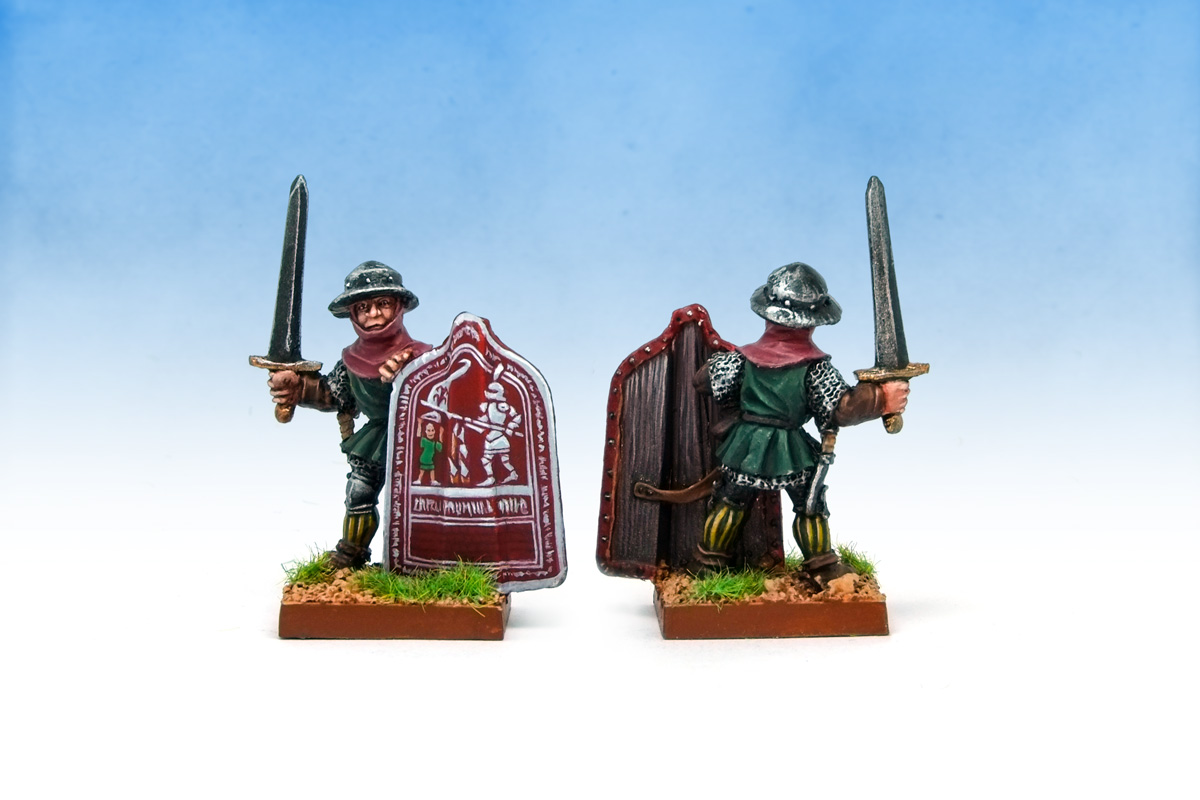 The shield design is based on the design of a surviving pavise at the National Museum of Prague.
The shield design is based on the design of a surviving pavise at the National Museum of Prague.
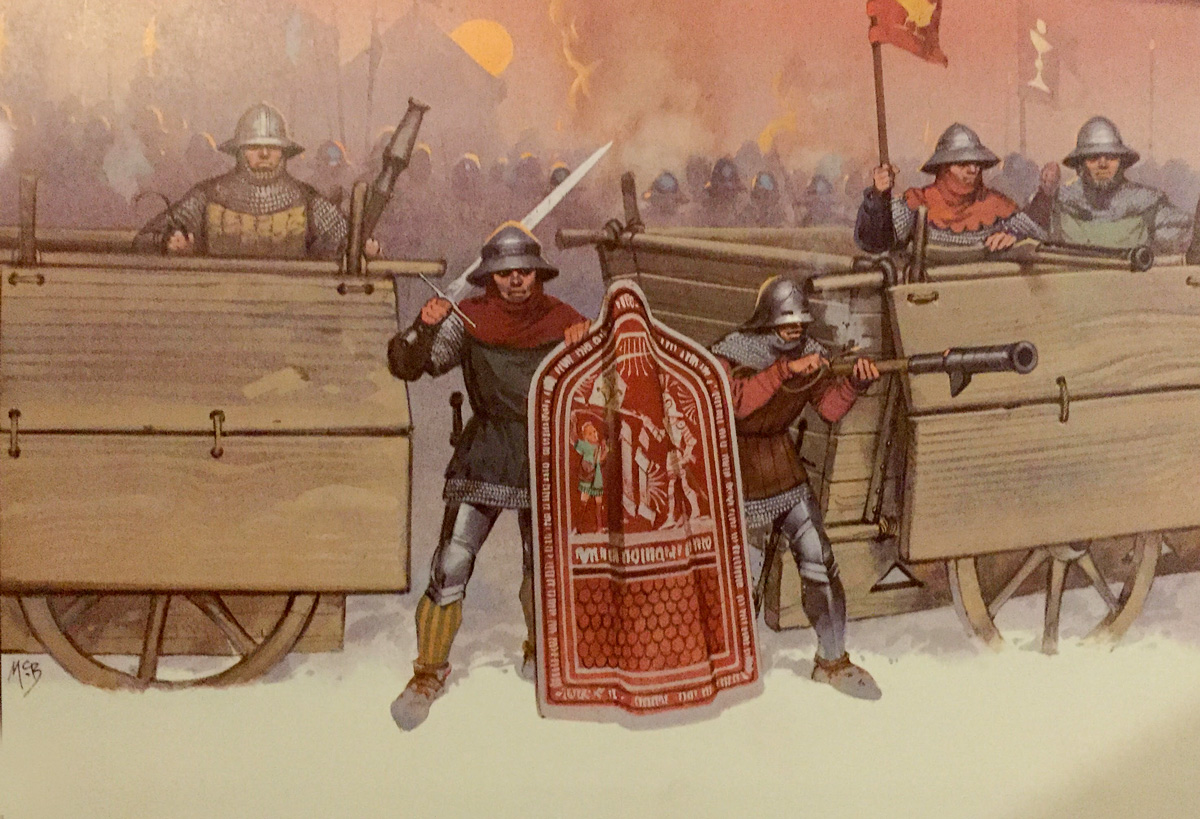 Taborite war wagons await the attack of Sigismund’s Hungarian horsemen, outside Kutna Hora, 1421, Eastern Bohemia.
Taborite war wagons await the attack of Sigismund’s Hungarian horsemen, outside Kutna Hora, 1421, Eastern Bohemia.
The Taborites were named after their fortified city in Bohemia, which was in turn named after the Mount Tabor of Biblical fame. They were a radical sub-faction of the larger anti-Catholic movement, the medieval equivalent of anarcho-communists who wanted to share everything they had – to the point where they even practised free love. Jan Žižka led them into battle numerous times against the Emperor Sigismund, but eventually found their theology (and perhaps their free love) too radical, and he parted ways to found the less hardline Oberite faction.
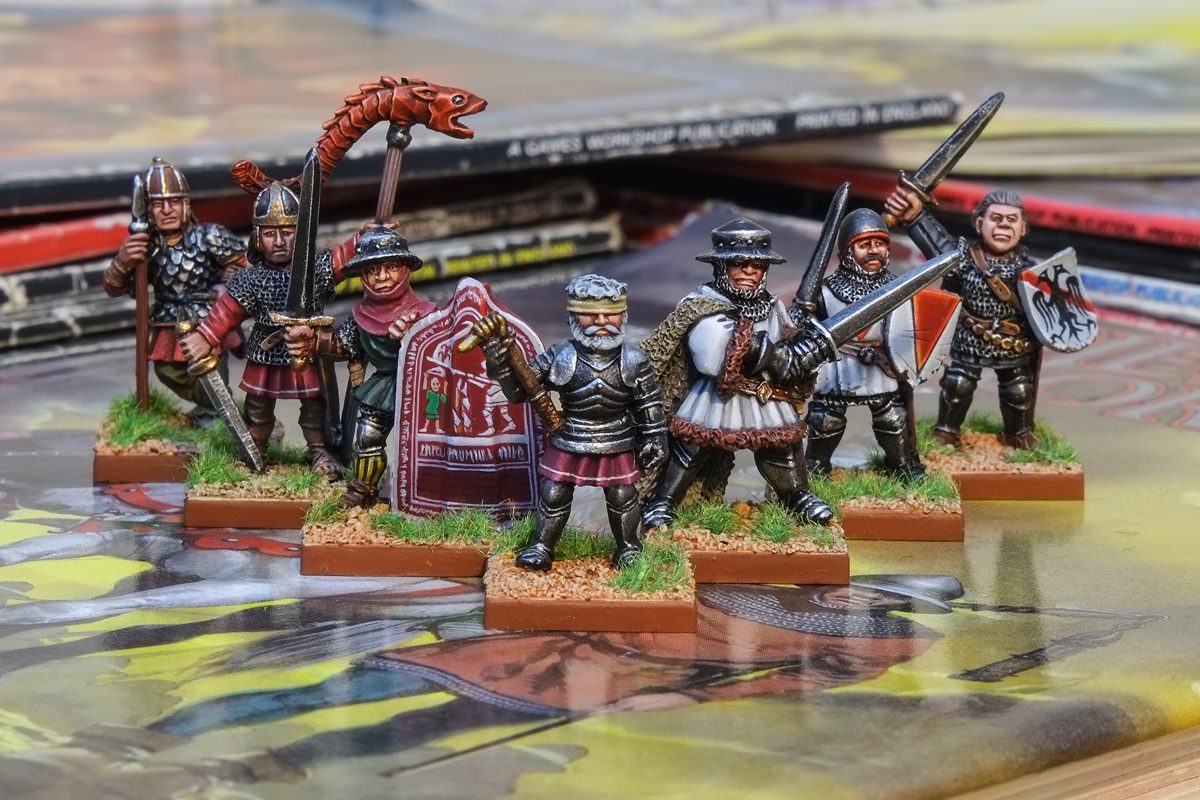 Pictured left to right: Alan Horseman, Biscuit Dude, Taborite Infantryman, Jan Žižka, Teutonic Knight, Sir John Chandos and Bertrand du Guesclin. Not pictured: Sir-Not-Appearing-In-This-Blog.
Pictured left to right: Alan Horseman, Biscuit Dude, Taborite Infantryman, Jan Žižka, Teutonic Knight, Sir John Chandos and Bertrand du Guesclin. Not pictured: Sir-Not-Appearing-In-This-Blog.
That’s seven of the twelve Blandford Warriors painted. I almost included Vlad Dracula with this lot, as he was a member of the Ordo Draconis that Emperor Sigismund founded to stamp on people like Jan Žižka. At times like this I love history; it’s like the Marvel Cinematic Universe – a shared reality with potential for crossover events.
Coming soon to Ninjabread – Big Trouble in Little Tang Dynasty.
More of my miniatures at: http://www.ninjabread.co.uk
|
|
This message was edited 4 times. Last update was at 2018/05/18 12:50:56
|
|
|
 |
 |
![[Post New]](/s/i/i.gif) 2018/05/20 15:00:07
Subject: Curis' Normans and Medievals (Hussite Wars added 18th May)
|
 |

Druid Warder
|
Almost too colourful! But it makes sense to remind that history could have been much more than faded pages of medieval texts. Thank You for sharing them, really lovely miniatures!
|
Painting progress tracker:
2017: 50 of 50 planned; 2018: 80 of 60 planned; 2019: 75 of 75 planned
Pledge 2020:
6 to sculpt, 75 to paint (2/57 done) |
|
|
 |
 |
![[Post New]](/s/i/i.gif) 2018/05/20 16:24:19
Subject: Curis' Normans and Medievals (Hussite Wars added 18th May)
|
 |

Damsel of the Lady
|
Huh. i thought i had already commented to say just how much i enjoy this blog, but apparently not!
So i um... really enjoy this blog. Both the painting, the lessons in history, and the really bad* jokes.
I'm still groaning over the seabiscuit one.
*Good
|
realism is a lie
|
|
|
 |
 |
![[Post New]](/s/i/i.gif) 2018/07/19 09:43:28
Subject: An Lushan and Imperial Guardsman
|
 |

Regular Dakkanaut
|
Thanks Wirecat! It's very easy to slip into the trap of thinking everything from history looked like a museum artefact does nowadays.
Cheers amazingturtles. Plenty more jokes to come!
*********
If you're into your medieval history you WILL NOT have heard of these models. That's cos they're not medieval at all. Welcome to my next two classic Citadel Miniatures from the range based on the 1987 Medieval Warlords book.
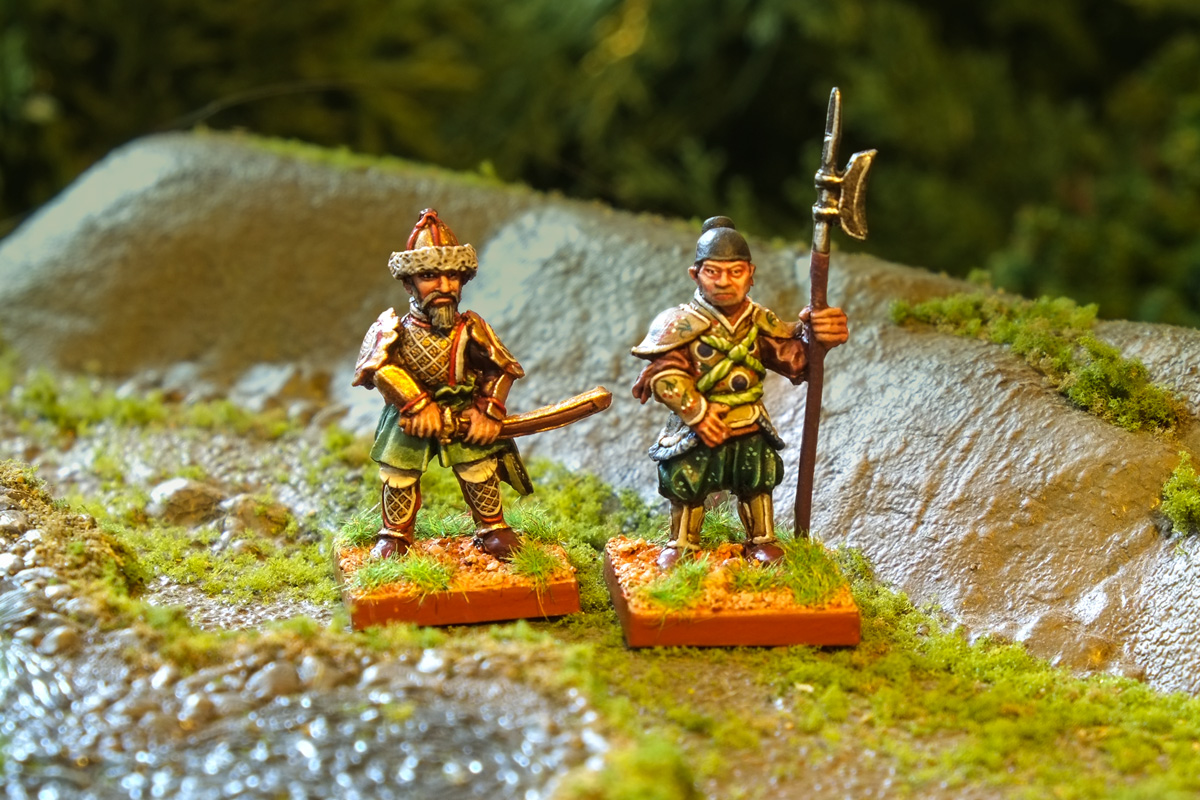 An Lushan and Imperial Guardsman on the lower reaches of the Yellow River.
An Lushan and Imperial Guardsman on the lower reaches of the Yellow River.
So, I have beef with An Lushan being classified as "Medieval" as it's a specifically European term for a historical period, and China ain't Europe. Calling An Lushan a Medieval Warlord is like calling Richard the Lionheart an Imperial Chinese Warlord. I imagine the publishers had a shortlist of even less suitable titles for the book.
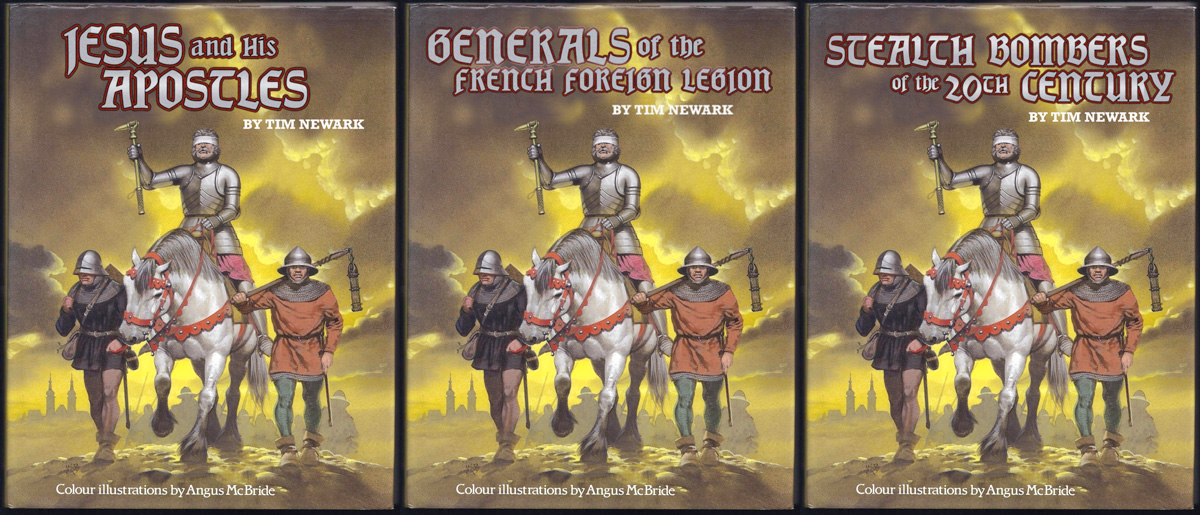 "Okay, sod it, we'll go with Medieval Warlords."
"Okay, sod it, we'll go with Medieval Warlords."
With the historian's pedantry out of the way, who are these two Medie... classic Citadel Miniatures?
An Lushan
An Lushan was possibly Mongol. Possibly Turkish. Possibly Liverpudlian (going off the model's uncanny resemblence to Ringo Starr). What we can definitely say is he wasn't Han Chinese as he was allowed to rise to power as a regional military governor in 8th century China when policy was to keep these powerful posts away from the capital's politicians to prevent rebellion.
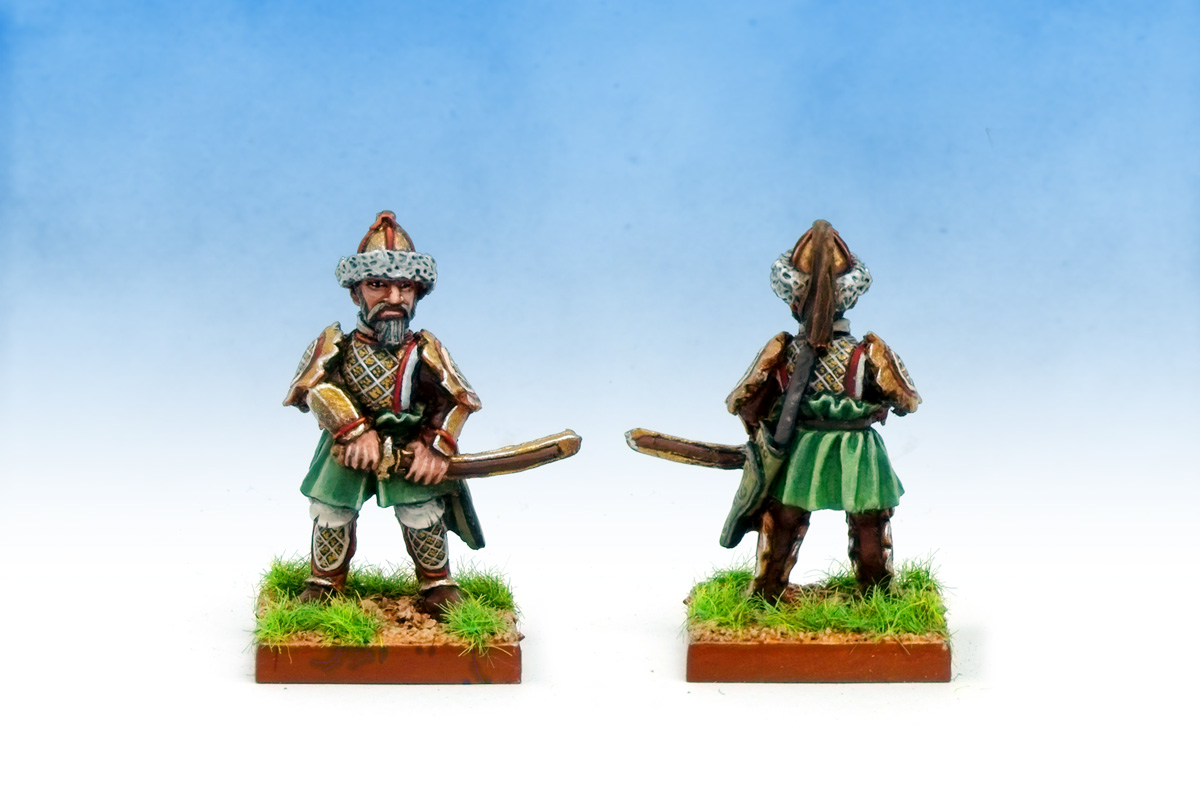 "In the town where I was born, lived a man who sailed to sea."
"In the town where I was born, lived a man who sailed to sea."
However, in 755, An Lushan's previously amazing relationship with Tang Dynasty soured. He marched on the heartland cities and declared himself emperor of his own brand new dynasty. This was the An Lushan Rebellion, which was one of the bloodiest wars of all time – the Tang Empire was bigger than even the Roman Empire at its height, and the scale of slaughter as cities were toppled and populations massacred reached perhaps into the tens of millions. Fascinatingly, the rebellion seems to have been sparked not by lofty political ideals, or a popular dissatisfaction with the ruling elite, but by a concern (or possibly paranoia) that the Tang Dynasty's Chief Minister was personally out to get An Lushan.
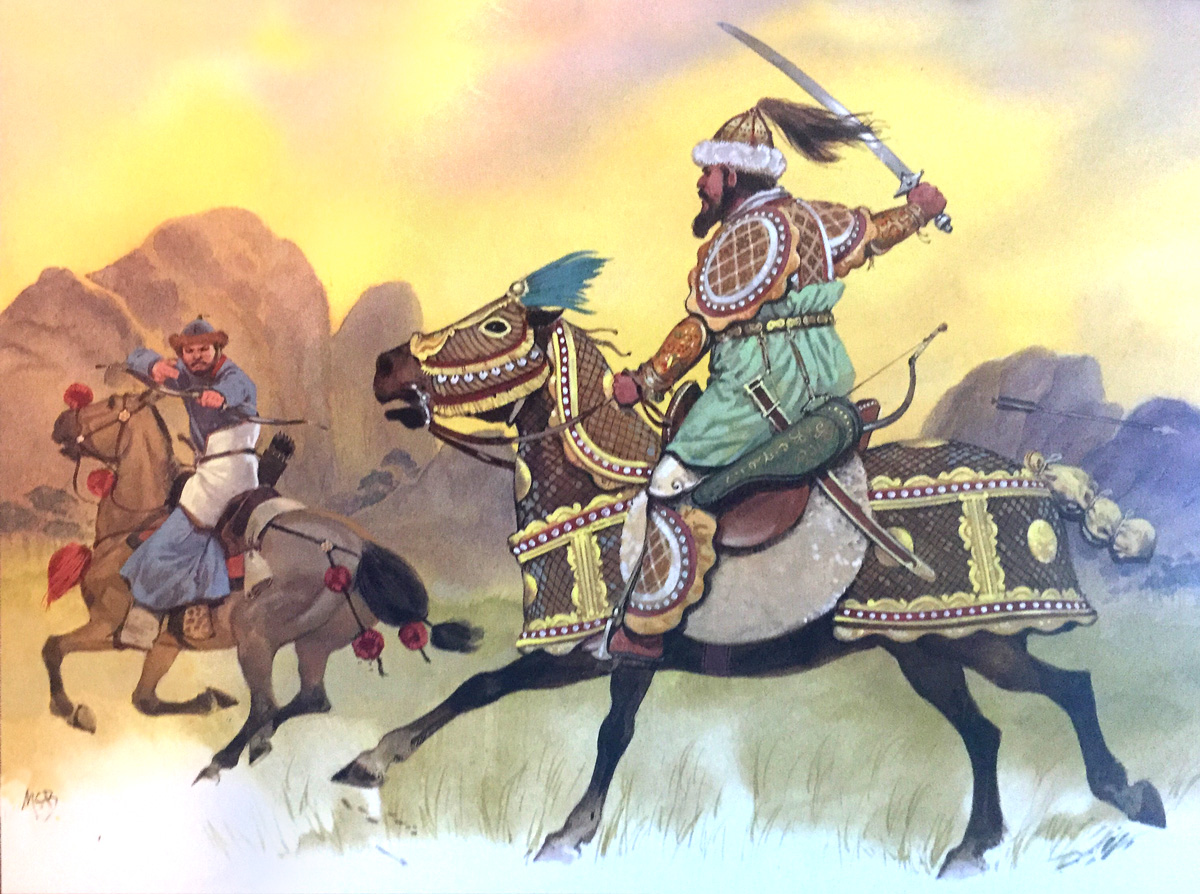 An Lushan pursues a Khitan Mongol beyond the Great Wall on the north-east Chinese border, 735.
An Lushan pursues a Khitan Mongol beyond the Great Wall on the north-east Chinese border, 735.
The Tang Emperor fled as the rebels stormed city after city. But as An Lushan's paranoia increased and his health worsened, he became a vulnerability and was assassinated by his own son (a surprisingly common fate in Imperial China). The Tang Dynasty was severely weakened by the uprising, and it marked the beginning of the end for China's golden age of civilisation.
But who had opposed An Lushan? It was…
Imperial Guardsmen
By the time of the An Lushan Rebellion, the Tang military was split between militia on the Empire's frontiers (which made up the bulk of An Lushan's forces), and the Imperial Guard who were permanently garrisoned at the capital city and the Imperial palaces. However, as with Ancient Rome's Praetorian Guard, an elite fighting force concentrated at the seat of Imperial power could lead to violent coups.
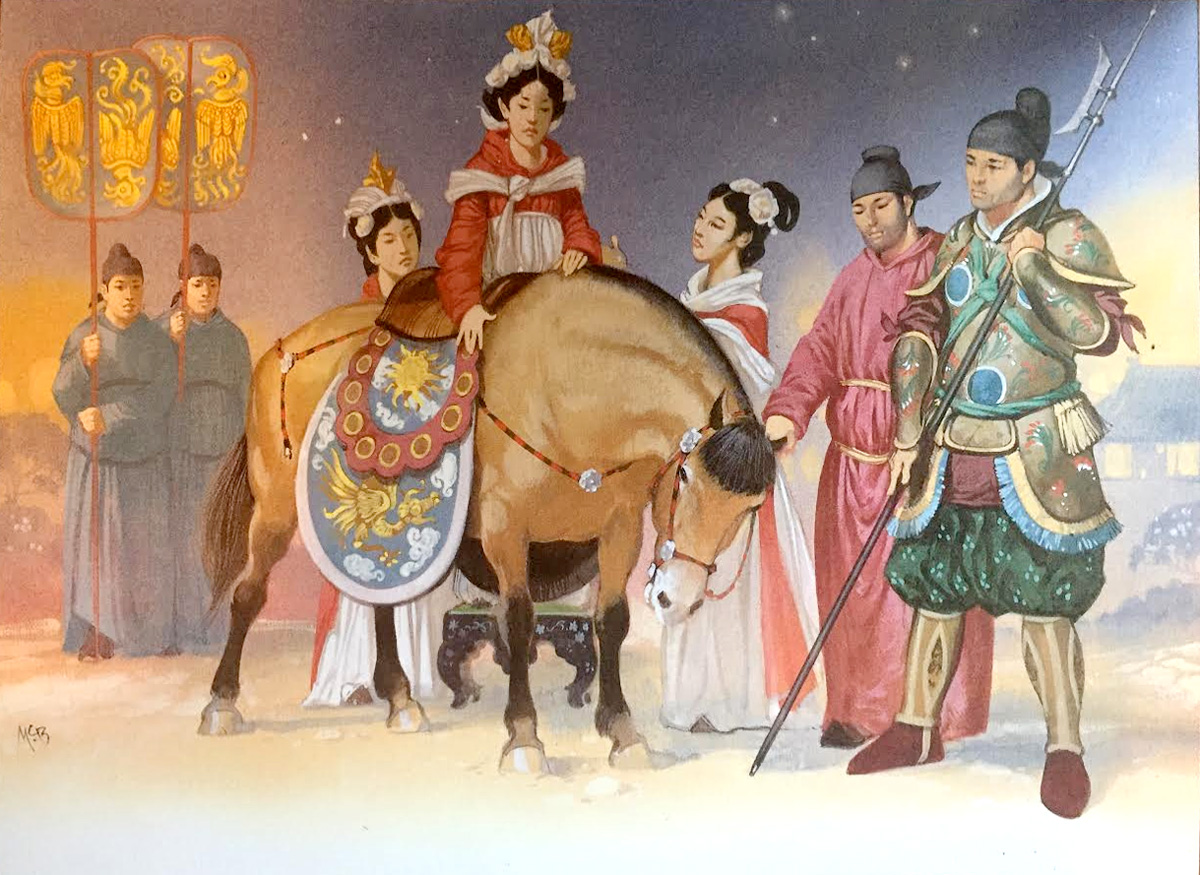 Yang Guifei – the Emperor's consort – and the Imperial Guard prepare to leave Ch'ang-an before the army of An Lushan, 756.
Yang Guifei – the Emperor's consort – and the Imperial Guard prepare to leave Ch'ang-an before the army of An Lushan, 756.
The Imperial Guard certainly proved wilful during Emperor Xuanzong's time – as they escorted Yang Guifei (the Emperor's favourite consort) away from the rebels' pillaging of the capital city they blamed her personally for their military misfortunes and demanded her immediate death. Needing to keep his elite guard on side, the Emperor consented and Yang Guifei was strangled.
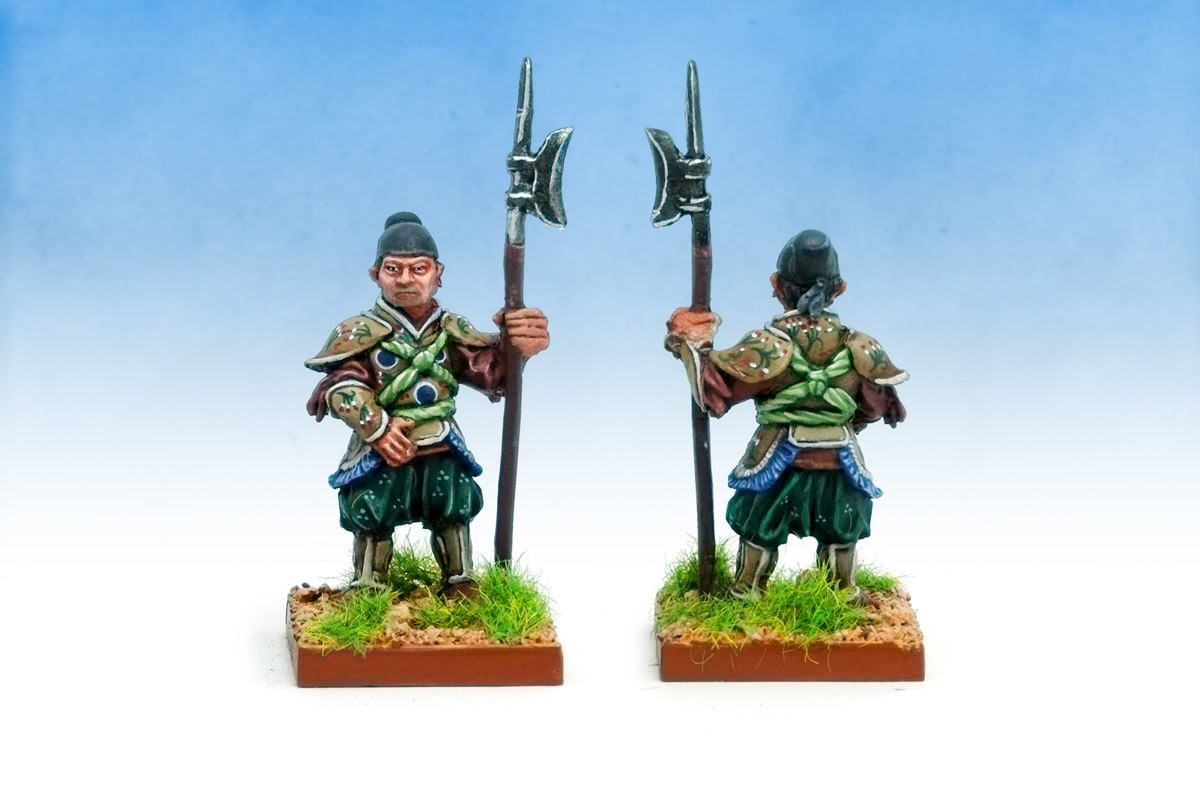 Imperial Guard circa 736.
Imperial Guard circa 736.
I've freehanded floral patterns onto the Imperial Guard's decorated leather armour to match the Angus McBride colour plates from the book. I enjoyed painting the stubble – all you've got to do for the five o'clock shadow look is shade and highlight the skin as normal then glaze the manly areas with a warm mid-grey (for example Skavenblight Dinge).
Blandford Warriors Assemble!
So that's nine of the twelve Blandford Warriors painted. I'm enjoying the tour around history and the opportunity to dabble with different periods without having to collect dozens upon dozens of figures for gaming.
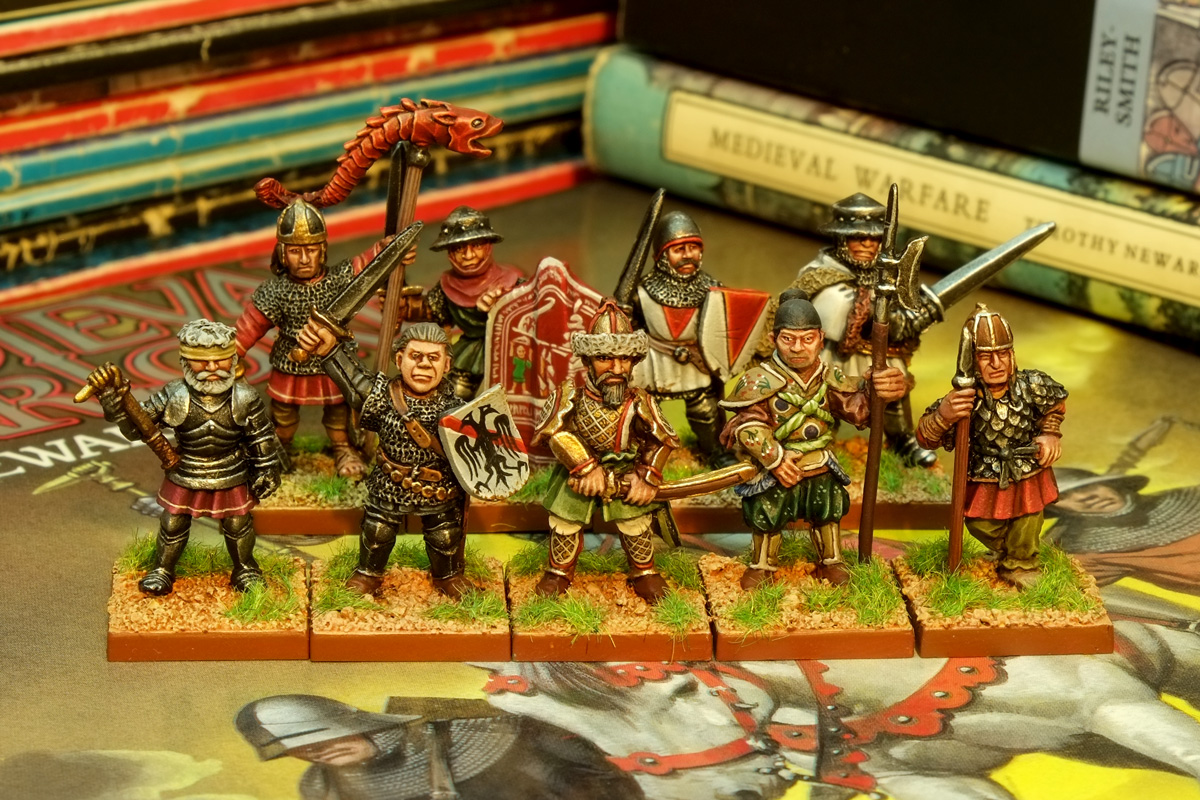 Left to right: Jan Žižka, Bucellarius of Majorian, Betrand du Guesclin, Taborite Infantryman, An Lushan, Sir John Chandos, Imperial Guardsmen, Teutonic Knight and Alan Horseman.
Left to right: Jan Žižka, Bucellarius of Majorian, Betrand du Guesclin, Taborite Infantryman, An Lushan, Sir John Chandos, Imperial Guardsmen, Teutonic Knight and Alan Horseman.
I'm looking forward to working on the final trio of Blandford Warriors to complete this historical wargaming project!
More of my miniatures at: www.ninjabread.co.uk/
More of my historicals at [url=http://www.ninjabread.co. uk/category/blog/historicals/]http://www.ninjabread.co. uk/category/blog/historicals/
[/url]
|
|
|
|
 |
 |
![[Post New]](/s/i/i.gif) 2018/08/23 11:39:20
Subject: Re:Curis' Normans and Medievals (An Lushan & Imperial Guard added 19th July)
|
 |

Regular Dakkanaut
|
It’s the end of the line for the Blandford Warriors! All twelve in this limited series of classic 1988 Citadel Miniatures are now painted and standing alongside each other in the cabinet, jostling for position of most dramatic medieval warlord.
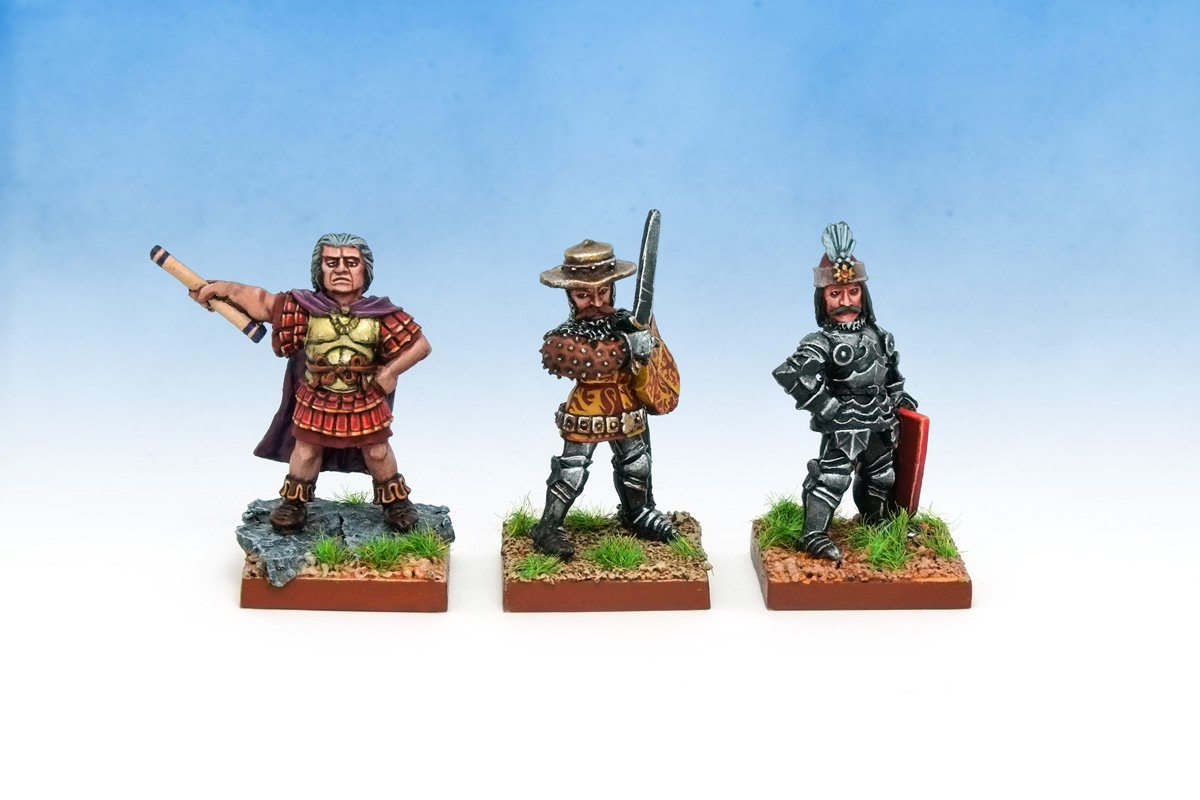 Left to right: Flavius Aetius, Owen of Wales and Vlad Dracula.
Left to right: Flavius Aetius, Owen of Wales and Vlad Dracula.
The final triumverate are spread across a thousand years of European history. Let’s take a look at them each in turn.
Flavius Aetius
Chances are you’ve not heard of Aetius, but you’ll have heard of his most famous opponent – Attila the Hun. Aetius and Attila clashed at the Battle of the Catalaunian Plains in AD451 – one of the greatest bloodsheds as the Western Roman Empire crumbled under the weight of barbarian invaders. Aetius was supreme commander of all military forces in the west, and crushed the Huns, stopping their advance into Gaul, and ultimately breaking Atilla’s tribal empire – earning him a place in history as the last of the great Romans.
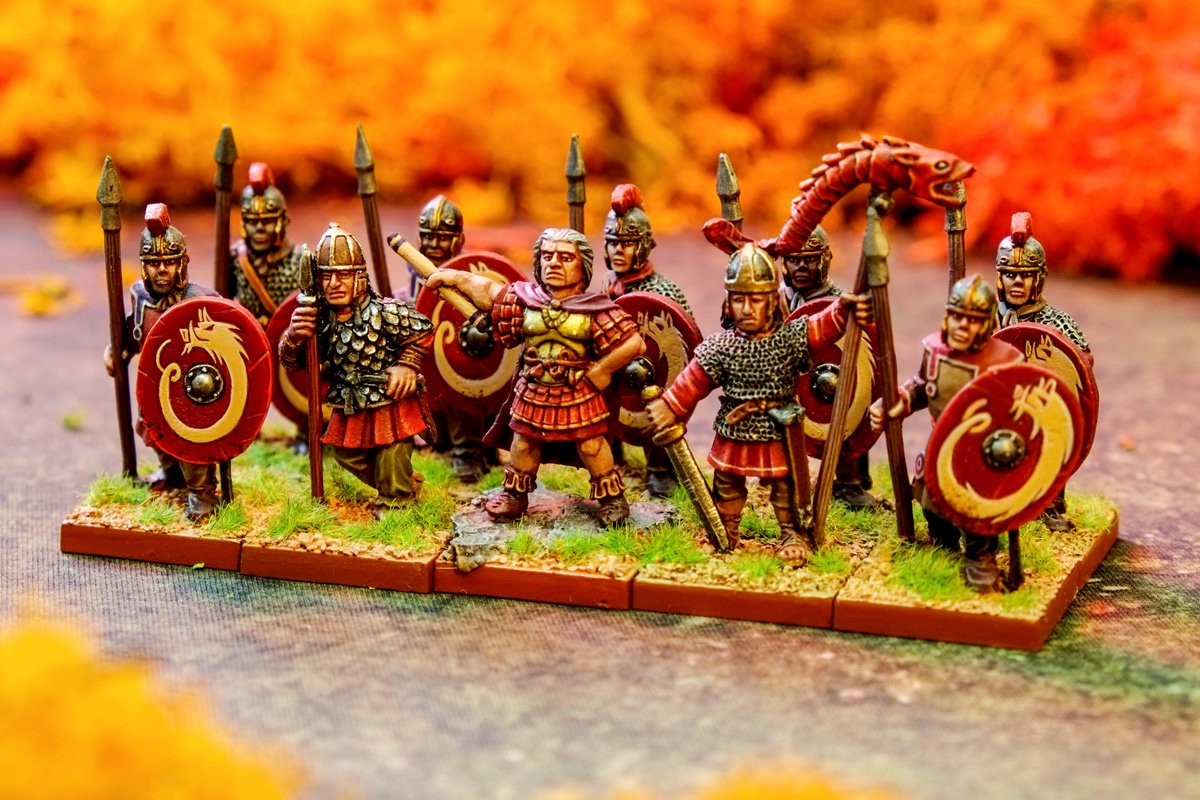 Flavius Aetius and his supporting Blandford Warriors – Alan Horseman and Bucellarius of Majorian – leading the defence of the Empire.
Flavius Aetius and his supporting Blandford Warriors – Alan Horseman and Bucellarius of Majorian – leading the defence of the Empire.
I really enjoyed painting Aetius, and mounted him a small rocky outcrop so he cuts a commanding presence over my Late Imperial Roman. The mini is at least 20 years older than his rank-and-file counterparts, so he needs the height along the more modern, bigger figures.
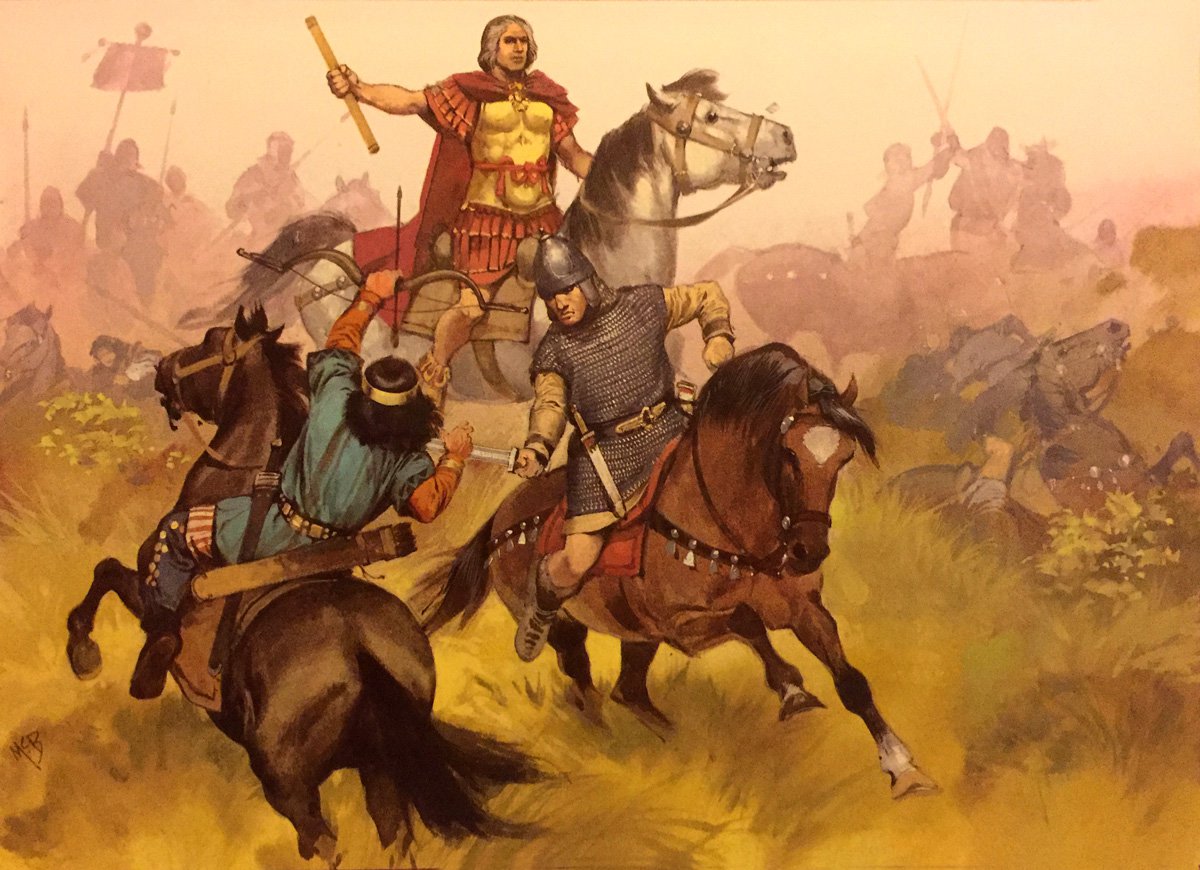 The Warlord Aetius and a Burgundian retainer attacked by a Hun at the Battle of the Catalaunian Plains, northwest France, AD451.
The Warlord Aetius and a Burgundian retainer attacked by a Hun at the Battle of the Catalaunian Plains, northwest France, AD451.
Aetius has the unique honour of being the titular star of both a wargame AND an opera by Handel. The wargame is Aetius and Arthur (which must be 50% about him if you go off just the title). The opera is Ezio (that’s Italian for “Aetius”), and sees our general returning home from defeating Attila, trying to disentangle himself and his future wife from a plot to assassinate the Emperor. This is the only Citadel miniature I know of which has an opera about it, until my own work, Marneus Calgaro Maestro di Ultramarines, debuts this winter.
Owen of Wales
This miniature is Owen of Wales (“Owain Lawgoch” if you’re Welsh), who was a mercenary captain in the Hundred Years War (c. 1330 – 1378). He hated the English so much he sided with their arch-nemesis, France, hoping his military service would ultimately help him claim the Prince of Wales title. He was killed by a sheep (well, an English spy named “Johnny Lamb”).
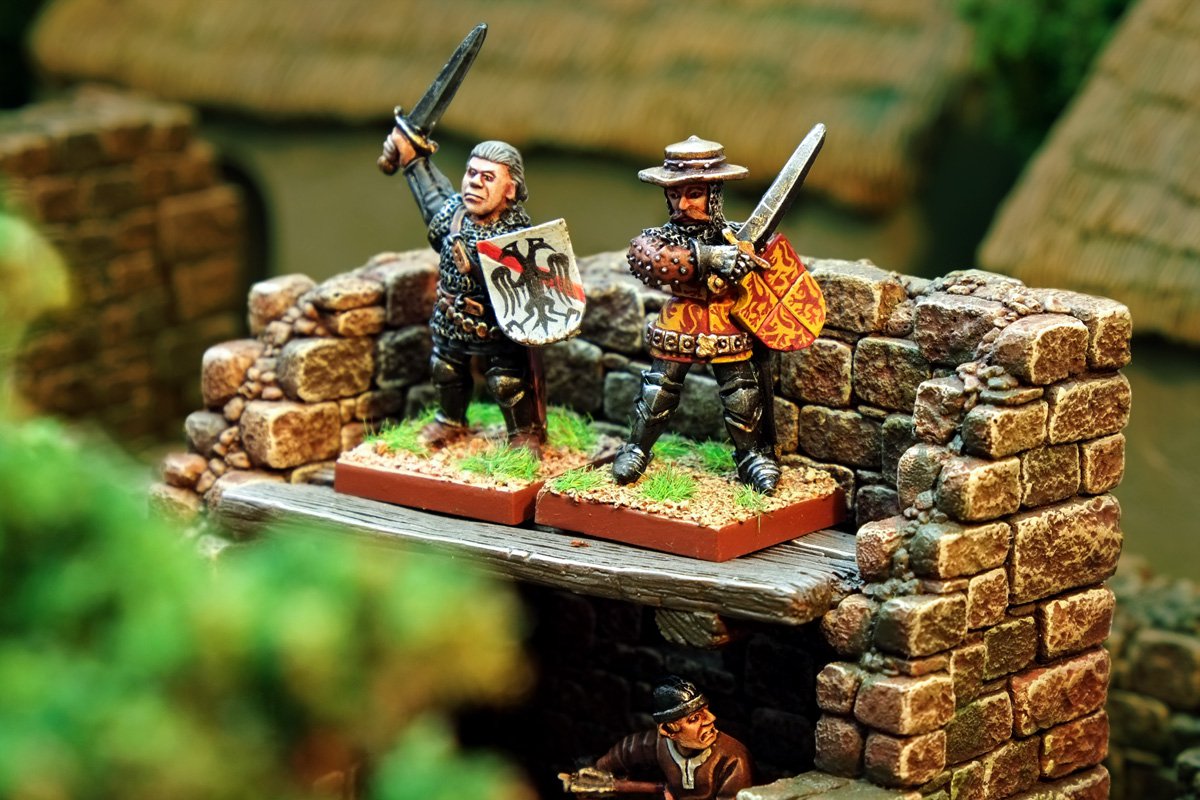 Bertrand du Guesclin and Owen of Wales fighting together, united in their hatred of the English.
Bertrand du Guesclin and Owen of Wales fighting together, united in their hatred of the English.
I had a load of fun painting all twelve of the lions rampant on his heraldry. They are the arms of the royal house of Gwynedd – which Owen would have worn to cement his image as the rightful Prince of Wales.
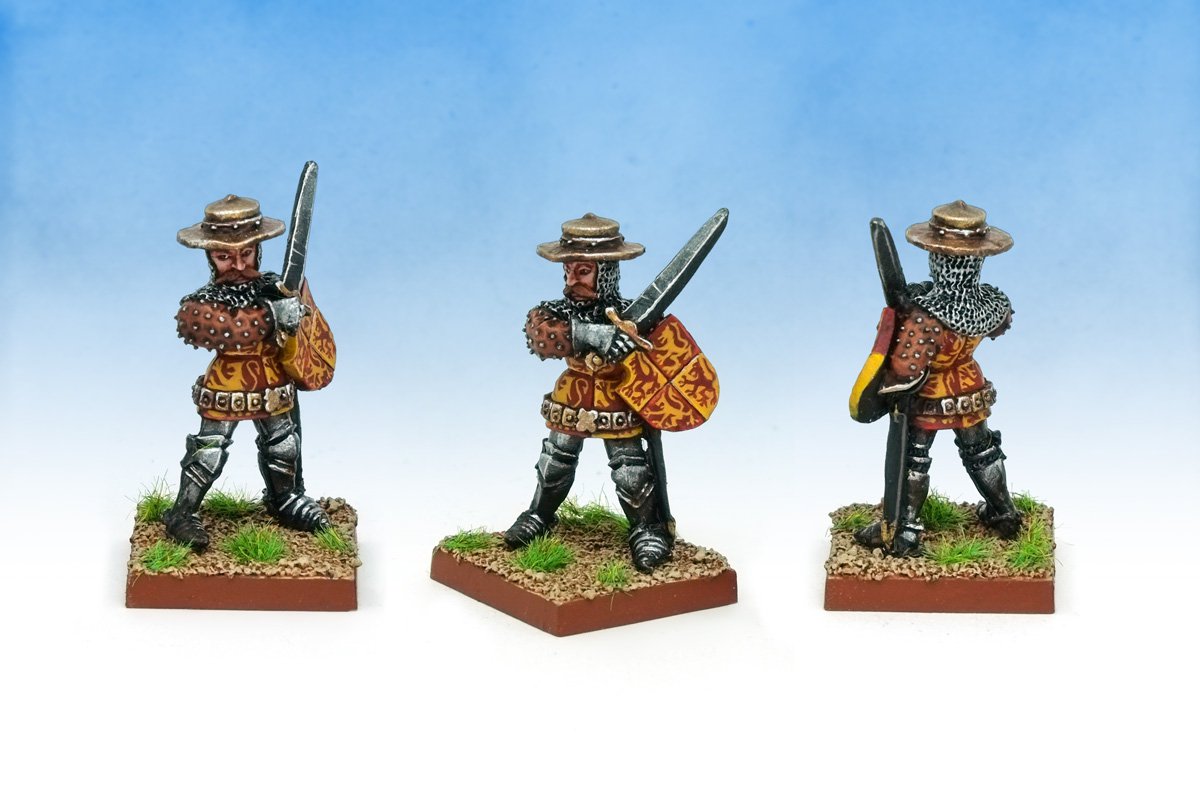 “Oh I just can’t wait to be ki… prince!”
“Oh I just can’t wait to be ki… prince!”
Now, let’s all take a moment to reflect on the name of the Swiss municipality in the caption below.
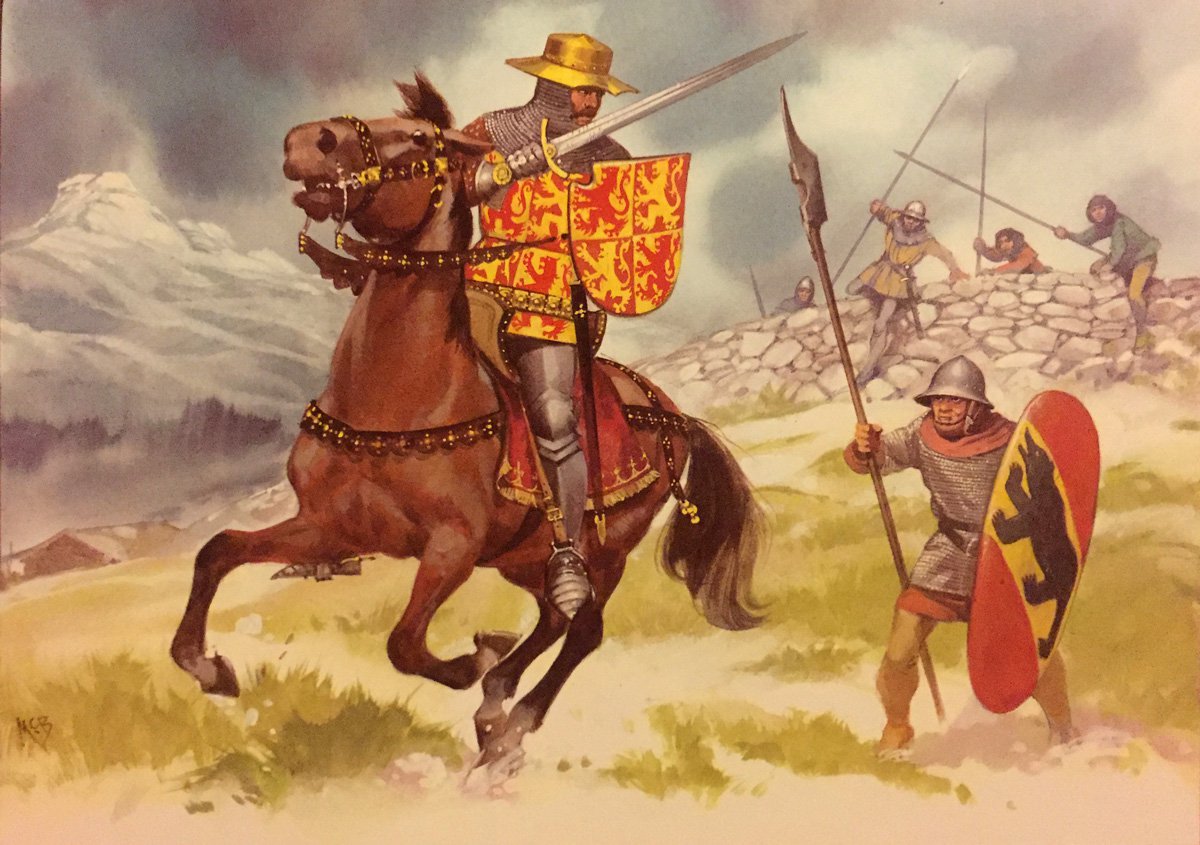 Owen of Wales is pursued by halberdiers from Berne at Buttisholz, Switzerland, 1375.
Owen of Wales is pursued by halberdiers from Berne at Buttisholz, Switzerland, 1375.
Now, there is a later Owen of Wales, (c. 1359 – c. 1415). A contemporary chronicler claimed this Owen of Wales (“Owain Glyndŵr” if you’re Welsh) adopted the name as he was inspired by the earlier medieval warlord. This is the Owen that instigated a rebellion against the English and got as far as establishing a proper Welsh parliament. Nowadays the Welsh celebrate him as a symbol of nationalism with their statues, their ship names, their music awards and their Manic Street Preacher songs. (Seriously, the Manics did the song 1404 all about this lad.)
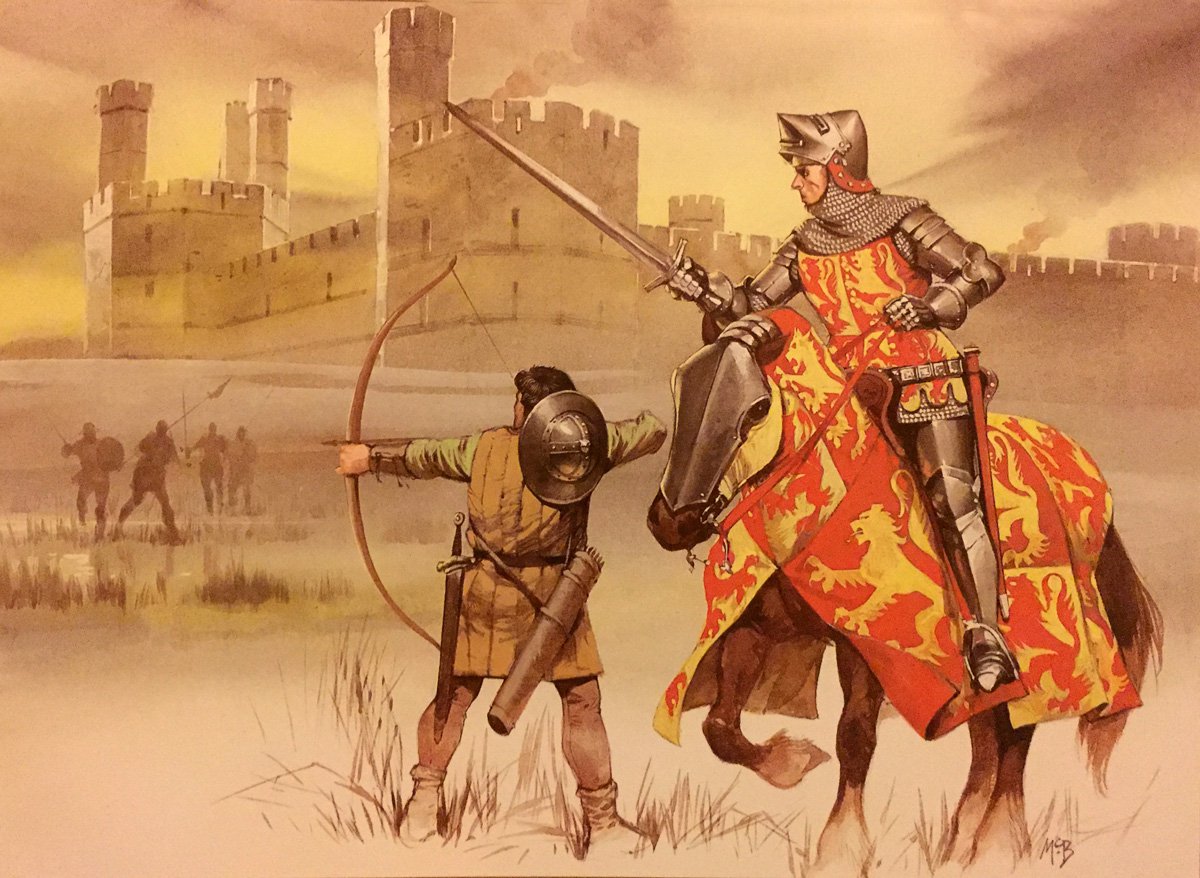 Owain Glyndŵr and his Welsh followers are attacked by the English garrison at Caernarfon Castle, AD1401.
Owain Glyndŵr and his Welsh followers are attacked by the English garrison at Caernarfon Castle, AD1401.
This later Owen pops ups in another Angus McBride illustration from Celtic Warriors that’s 83% more liontacular on account of that horse’s barding. That looks like an fun challenge to paint.
Vlad Dracula
Vlad Dracula, rose to power as Prince of Wallachia by impaling all the leading nobility on stakes in a single night and replacing them with a new totally-loyal nobility raised from the peasantry. He held on to power with the same impailment tactic – political enemies, suspected traitors, even whole armies of Turks found themselves with sharpened wooden stakes through their torsos. His brutality and violent excesses saw him dubbed “Vlad the Impaler” within his lifetime, and his legend has grown since his death to the point of him being the most iconic vampire in the modern popular imagination.
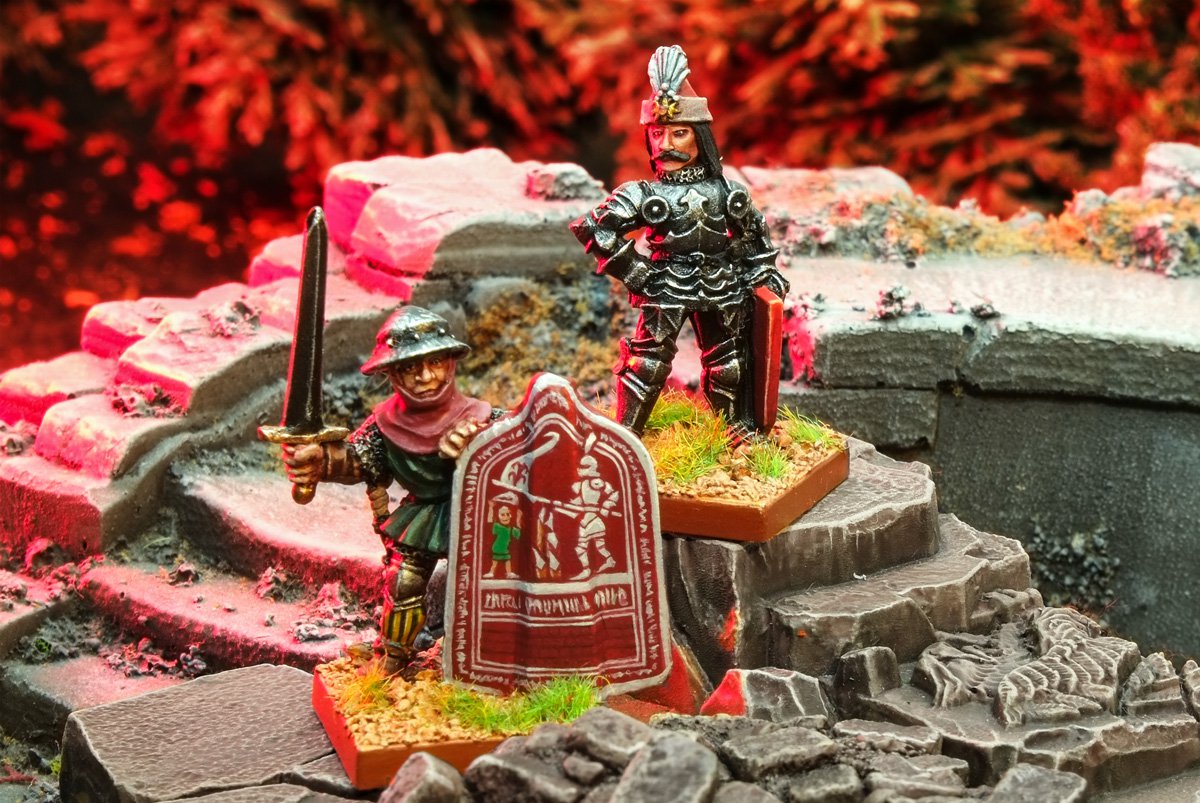 A veteran Taborite Infantryman and Vlad Dracula fighting together on the Hungarian border
A veteran Taborite Infantryman and Vlad Dracula fighting together on the Hungarian border
Vlad was a member of the Ordo Draconis, which was founded by the King of Hungary to stamp out the enemies of Christianity (including the likes of fellow Blandford Warrior Jan Žižka). Though ostensibly Christian, Dracula never quite grasped the essence of the religion – attempting to demonstrate his faith to the King of Hungary with a gift of two bags of Turkish heads, ears and noses. See how well that gift goes down with your vicar.
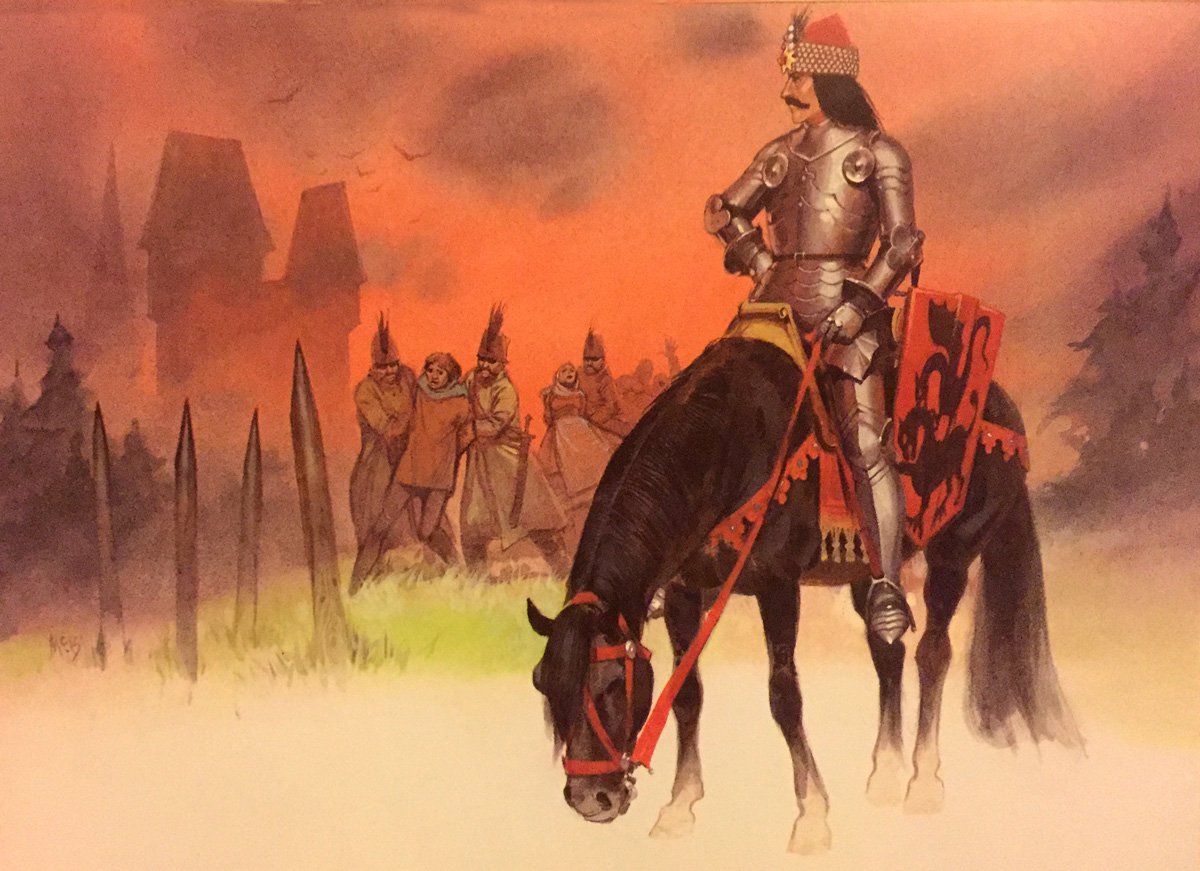 Dracula supervises the execution of prisoners after a raid on a German settlement in southern Transylvania, AD1460.
Dracula supervises the execution of prisoners after a raid on a German settlement in southern Transylvania, AD1460.
The heraldry of the Ordo Draconis, in the Angus McBride plate above, is a dragon swooping down on some sort of serpentine monster. Ordo Draconis is where Dracula’s father – Vlad II Dracul – got his name from, and “Dracula” is the diminuitive form – “little dragon”.
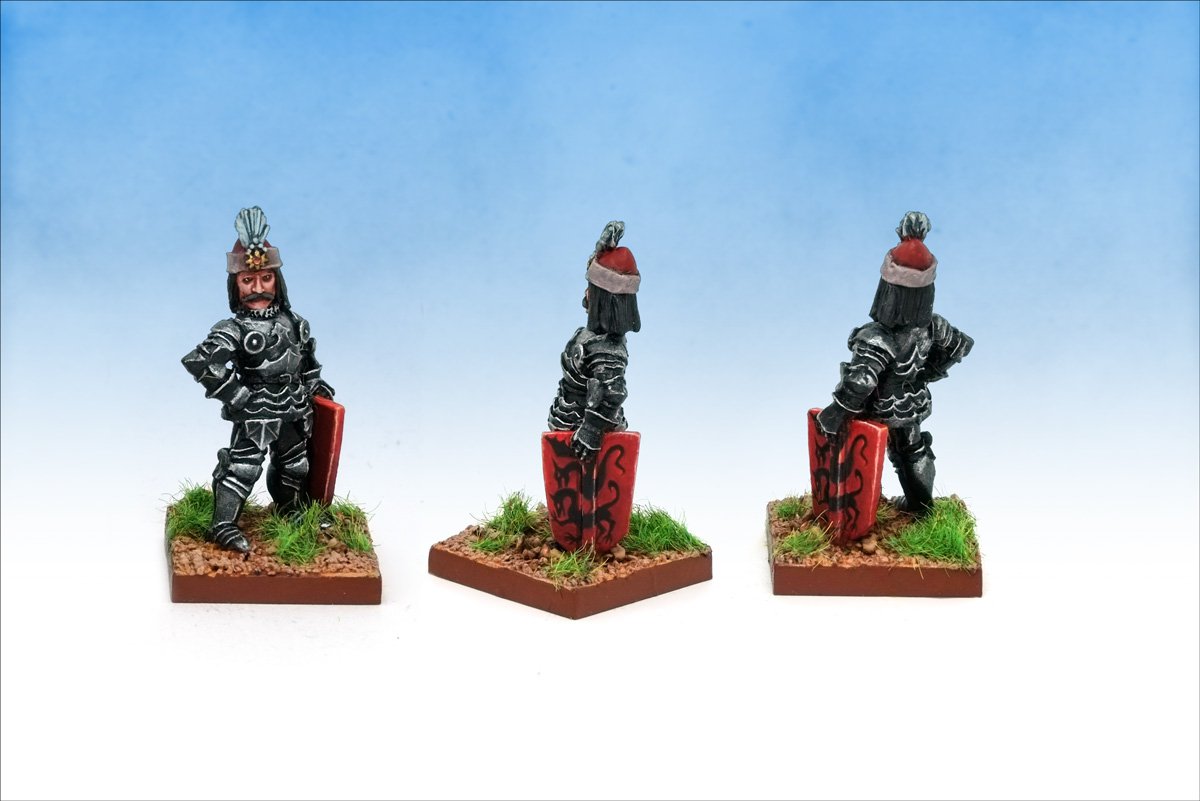 Dracula, looking every inch the cock of the town, though at 5’ 2” it’s not many inches.
Dracula, looking every inch the cock of the town, though at 5’ 2” it’s not many inches.
Vlad eventually died on the battlefield in AD1476, fighting the Ottoman Turks. They cut his head off and sent it to their Sultan, who impaled it on a spike. However, Vlad had converted from Greek Orthodoxy to Roman Catholicism during his lifetime – something considered so heretical that Wallachian folklore claimed that on death, any such heretic would transform into… a vampire.
Project Complete
I enjoy grouping the figures from different chapters of Medieval Warlords together (like the Taborite Infantryman and Dracula) to make the figures cross over. I can even draw a connection through a thousand years of time between Aetius (representing the earliest medieval warlord), and Dracula (the latest): Aetius defeated Attila the Hun, and Bram Stoker’s Dracula character was a member of the Hungarian tribal group that claimed direct descent from those Huns.
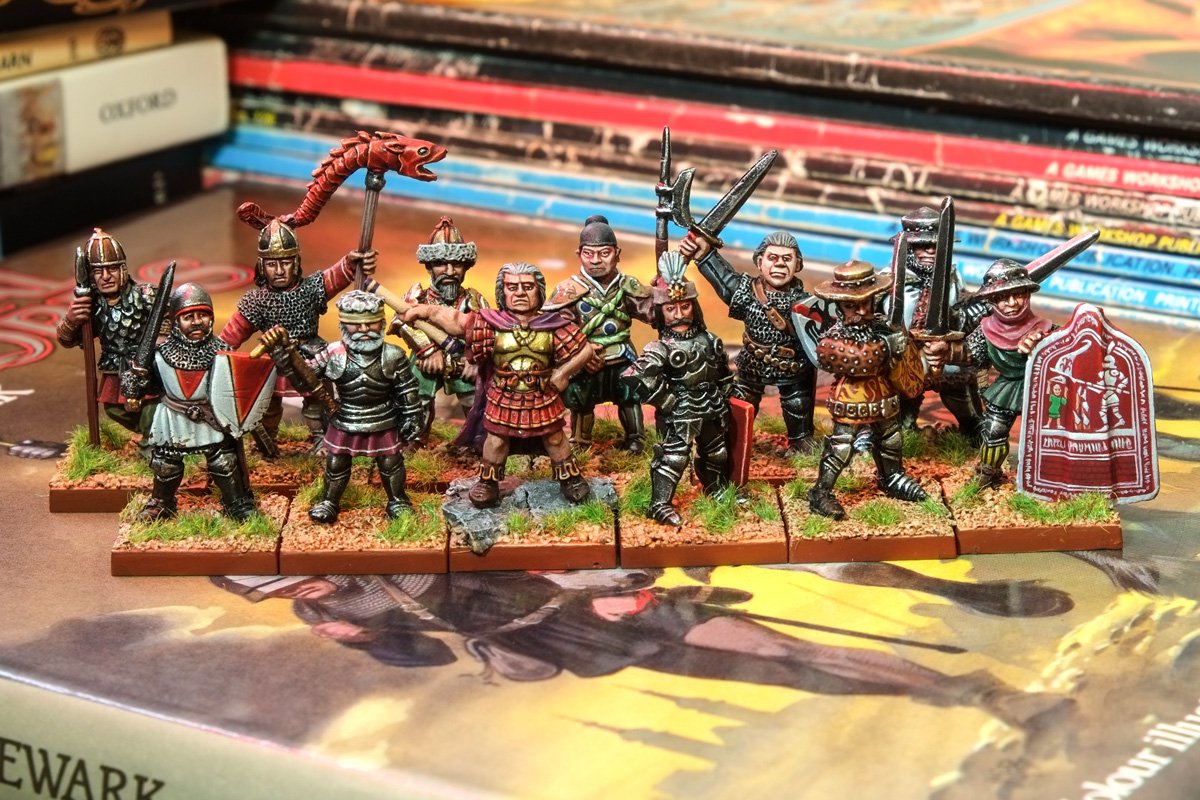 Left to right: Alan Horseman, Sir John Chandos, Bucellarius of Majorian, Jan Žižka, An Lushan, Flavius Aetius, Imperial Guardsman, Vlad Dracula, Bertrand du Guesclin, Owen of Wales, Teutonic Knight and Taborite Infantryman.
Left to right: Alan Horseman, Sir John Chandos, Bucellarius of Majorian, Jan Žižka, An Lushan, Flavius Aetius, Imperial Guardsman, Vlad Dracula, Bertrand du Guesclin, Owen of Wales, Teutonic Knight and Taborite Infantryman.
That’s each and every Blandford Warrior painted. The set is complete. Project over. Now I can give my historical wargaming energy to something else. Reinforcements for my Normans? Siege of Oxford? Early Imperial Romans? Late Imperial Romans? I’m giddy with excitement, all I can say with certainty is that’s the end of my Blandford Warriors.
…
…
…
Or is it … ?
Stay tuned to Ninjabread for more minis. If you fancy your own set of Blandford Warriors they’re available from the excellent Wargames Foundry.
More of my miniatures at: www.ninjabread.co.uk/
More of my historicals at [url=http://www.ninjabread.co. uk/category/blog/historicals/]http://www.ninjabread.co. uk/category/blog/historicals/
[/url]
|
|
|
|
 |
 |
![[Post New]](/s/i/i.gif) 2018/08/24 18:31:48
Subject: Curis' Normans and Medievals (Aetius, Owen and Dracula added 23rd August)
|
 |

Rampaging Reaver Titan Princeps
|
I take it Marneus Calgar Maestro di Ultramarino will deal with the return of Roboute Gulliman?
|
"But me no buts! Our comrades get hurt. Our friends die. Falkenburg is a knight who swore an oath to serve the church and to defend the weak. He'd be the first to tell you to stop puling and start planning. Because what we are doing-at risk to ourselves-is what we have sworn to do. The West relies on us. It is a risk we take with pride. It is an oath we honour. Even when some soft southern burgher mutters about us, we know the reason he sleeps soft and comfortable, why his wife is able to complain about the price of cabbages as her most serious problem and why his children dare to throw dung and yell "Knot" when we pass. It's because we are what we are. For all our faults we stand for law and light.
Von Gherens This Rough Magic Lackey, Flint & Freer
Mekagorkalicious -Monkeytroll
2017 Model Count-71
|
|
|
 |
 |
![[Post New]](/s/i/i.gif) 2018/10/05 16:06:21
Subject: Curis' Normans and Medievals (Aetius, Owen and Dracula added 23rd August)
|
 |

Regular Dakkanaut
|
Spot on, Llamahead. And it's a trilogy.
This miniature is a mystery – an unreleased Warhammer treasure from the vaults of Citadel Miniatures. Who is he? Why have I got (perhaps) the only casting in existence?
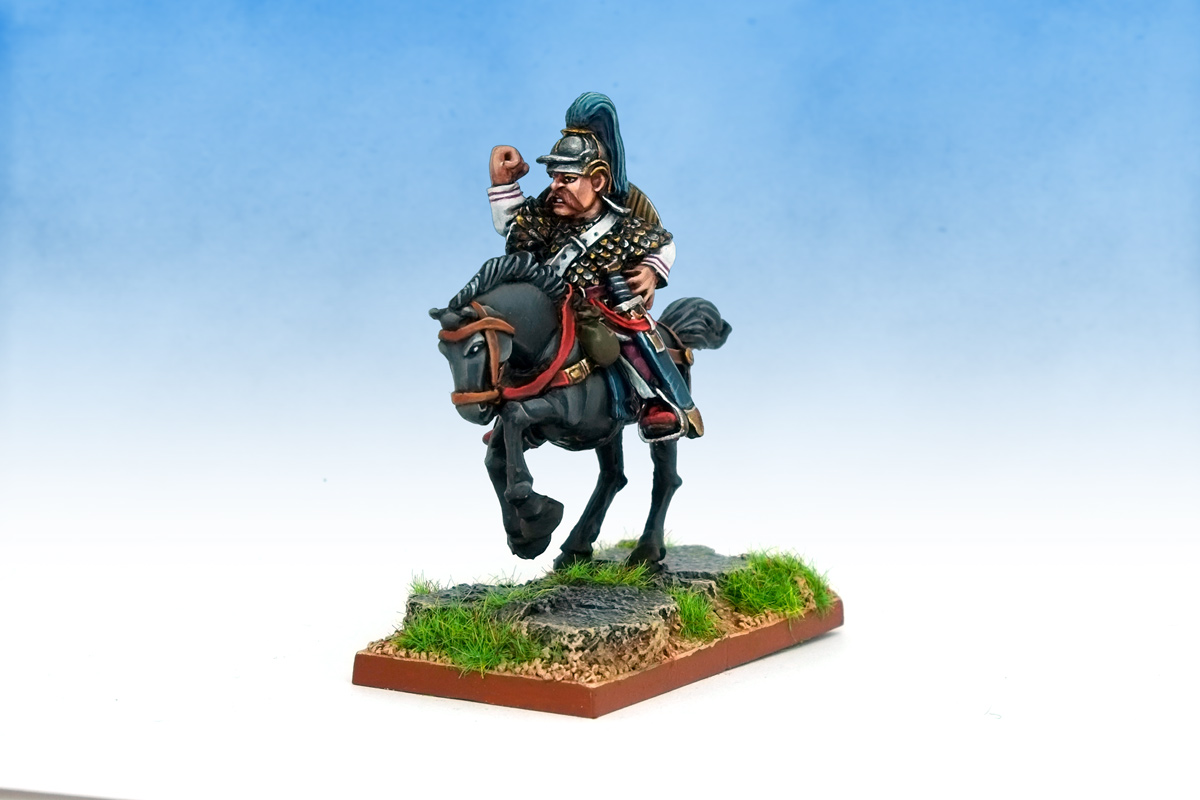
Could this be a dark horse on a dark horse?
This casting was a gift from Marcus Ansell of Wargames Foundry (thanks Marcus). The tab (“GENERAL” and “ © GW 1987″) shows its provenance as a piece of classic Warhammer – but beyond that everything else is a mystery. Who sculpted it? What range was it destined for? Why was it not released?
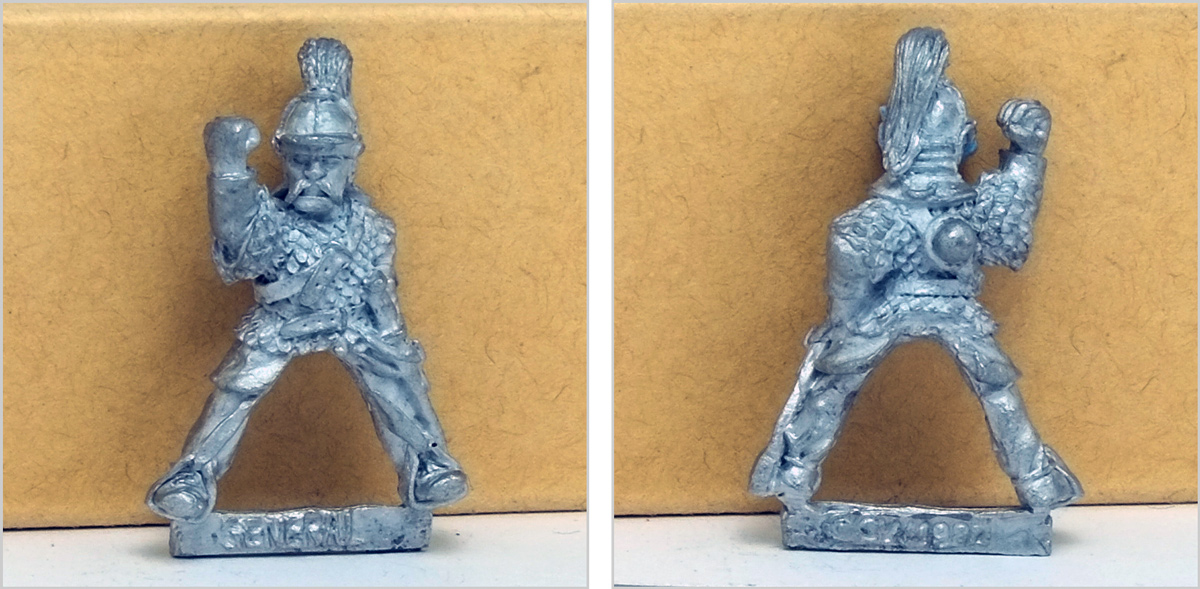
“A horse, a horse, my Romano-Germanic kingdom for a horse.”
The vibe of the figure is more historical than fantastical – the moustache, crested helm and scalemail give it a very Romano-Germanic kingdom vibe. It feels like an Alan or Michael Perry sculpt judging by this face and care put into the armour detailing. In fact it’s a bit too historically accurate to fit in with Citadel’s F3 Barbarian or F6 Barbarian Raider ranges, or the ADD21 Advanced Dungeons & Dragons mounted barbarian. The closest thing released by Citadel are the F7 Mounted Barbarian Raiders.

F7 Mounted Barbarian Raiders. Image from solegends.
The Mounted Barbarian Raiders were released at a time when the line between historical and fantasy figures was blurred, with Warhammer’s Empire, Norse, Bretonnian and Dogs of War ranges doing double-service as various historical Europeans. It’s conceivable that Citadel had plans for a Warhammer race with a strong Romano-Germanic design elements, and this General was a testpiece.
I gave my General one of the F7 horses as it’s coetaneous, and he deserves a bodyguard of these classics at a future point. I modelled the horse forward on the raised base so that when the planned regiment ranks up he will ride slightly above and ahead.
[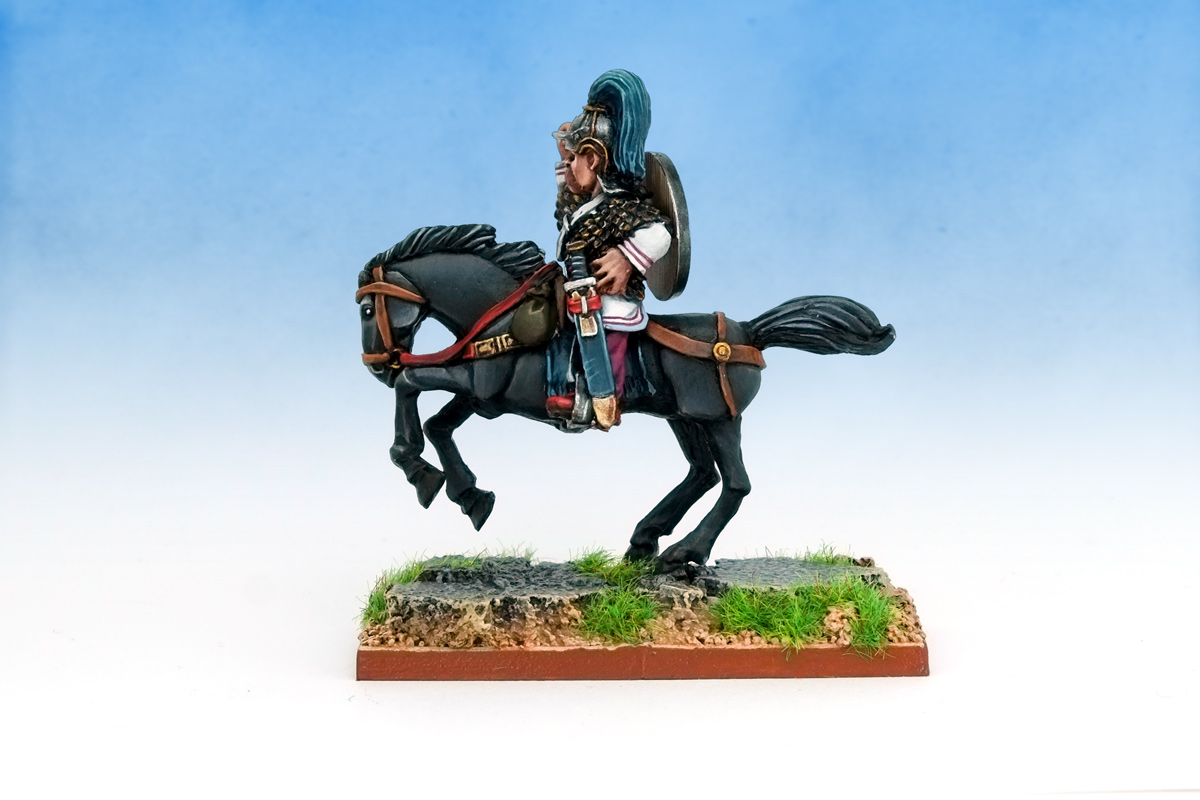
Then as I was researching colours a thought struck me. Is this mystery figure a … Blandford Warrior? He fits beautifully with the released Blandford Warriors in terms of style and scale.
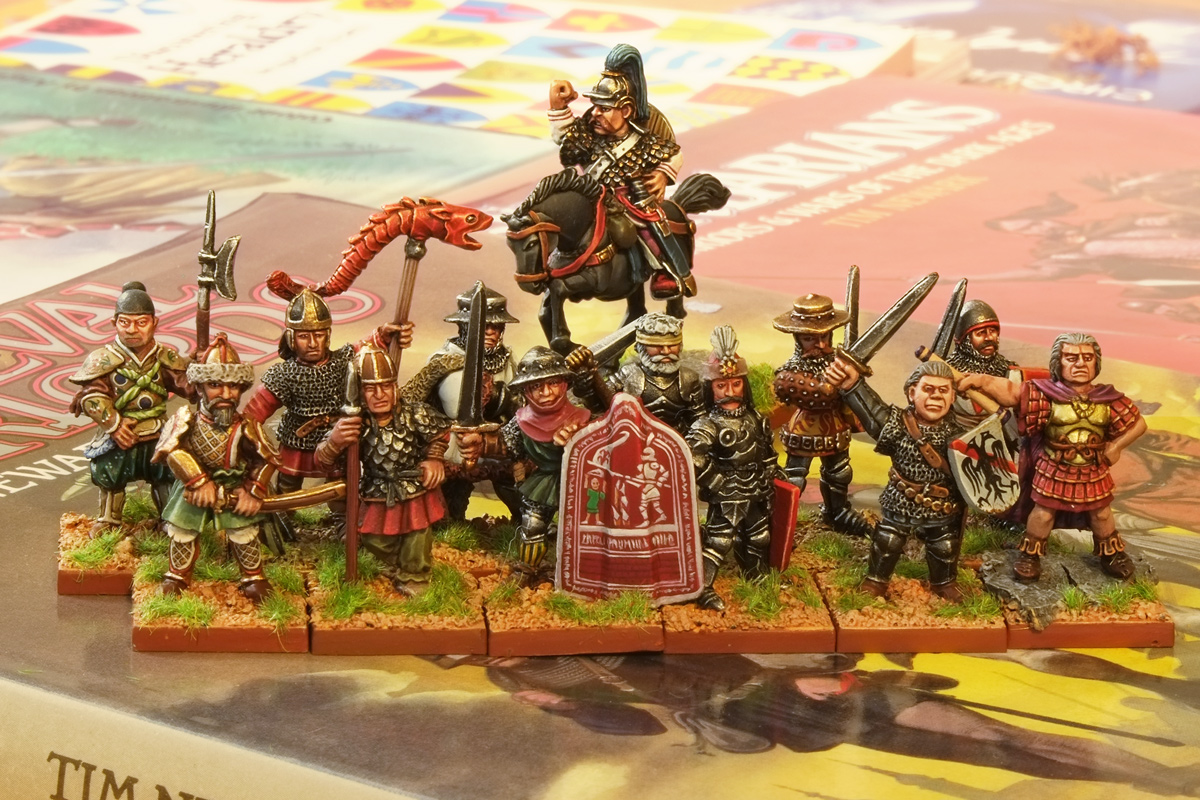
The 13th (Blandford) Warrior.
The Medieval Warlords book comprises seven chapters each detailing a different warlord, and Games Workshop released miniatures for only six of these characters. The warlord that appears as a chapter but not a miniature was Genseric – general of one of the most famous Romano-Germanic kingdoms. I think this figure could be him.
Genseric led the Vandals from the heartlands of the crumbling Roman Empire to Africa and around the Mediterranean region until they stormed Rome itself, looting its treaures. The incident stuck in the West’s poplar imagination, and ever since the word “vandal” has been a byword for destroying property.
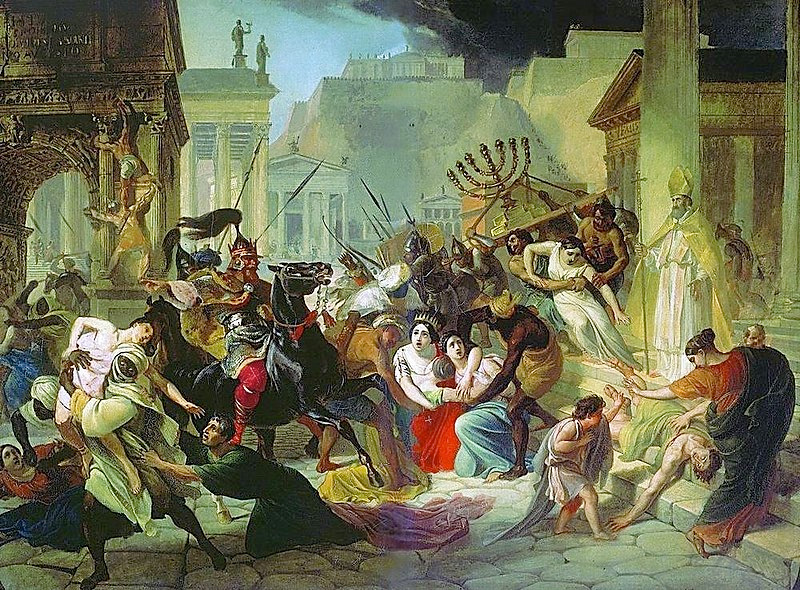
Genseric sacked Rome until politely asked to stop it by Pope Leo I, AD455.
I used the Karl Briullov painting above as the basis for my miniature’s colour scheme. I love the satanically-black horse implying he’s the Pope’s archnemesis – but the menace is rather undermined by the pink leggings and ruby red shoes.
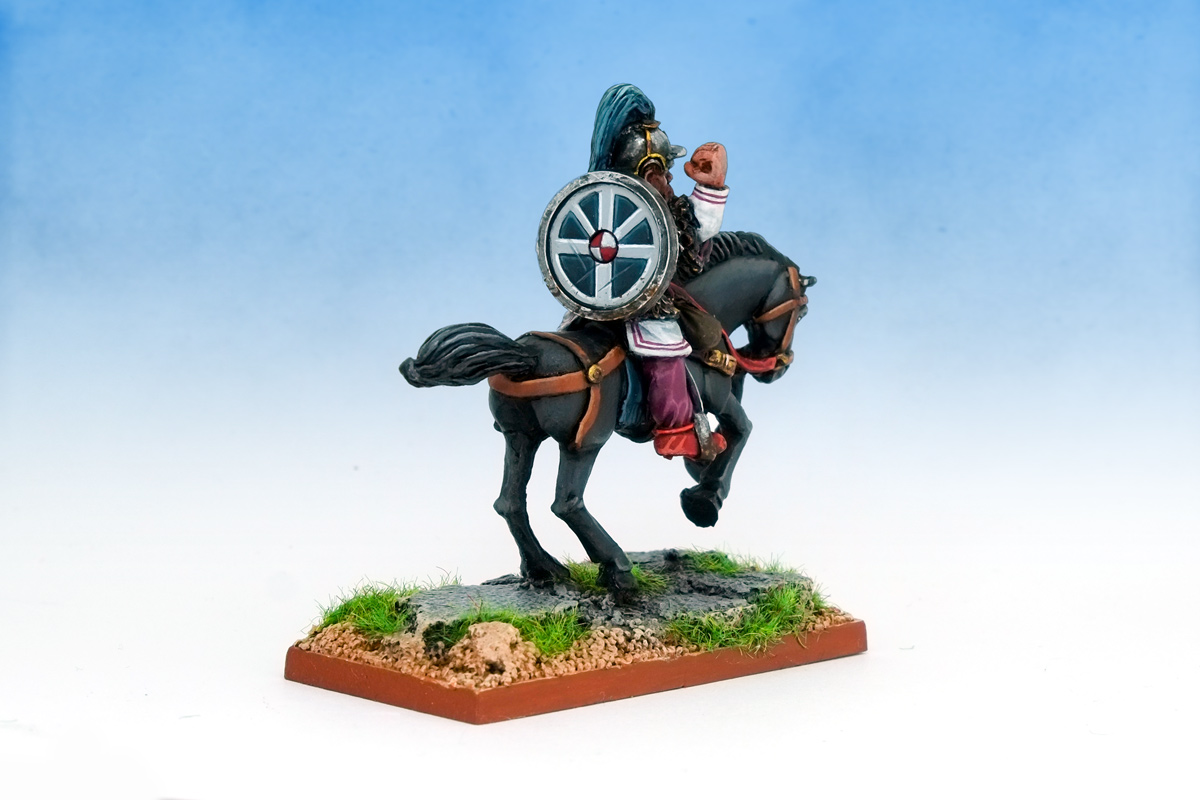
I painted the shield with an Arianist symbol – I’d like to stress this was the form of Christianity that took off in the Romano-Germanic kingdoms and was named after Arius and NOTHING TO DO WITH ARYANISM. (After all those “arian symbol german” google searches I think I’ve been put on a list.)
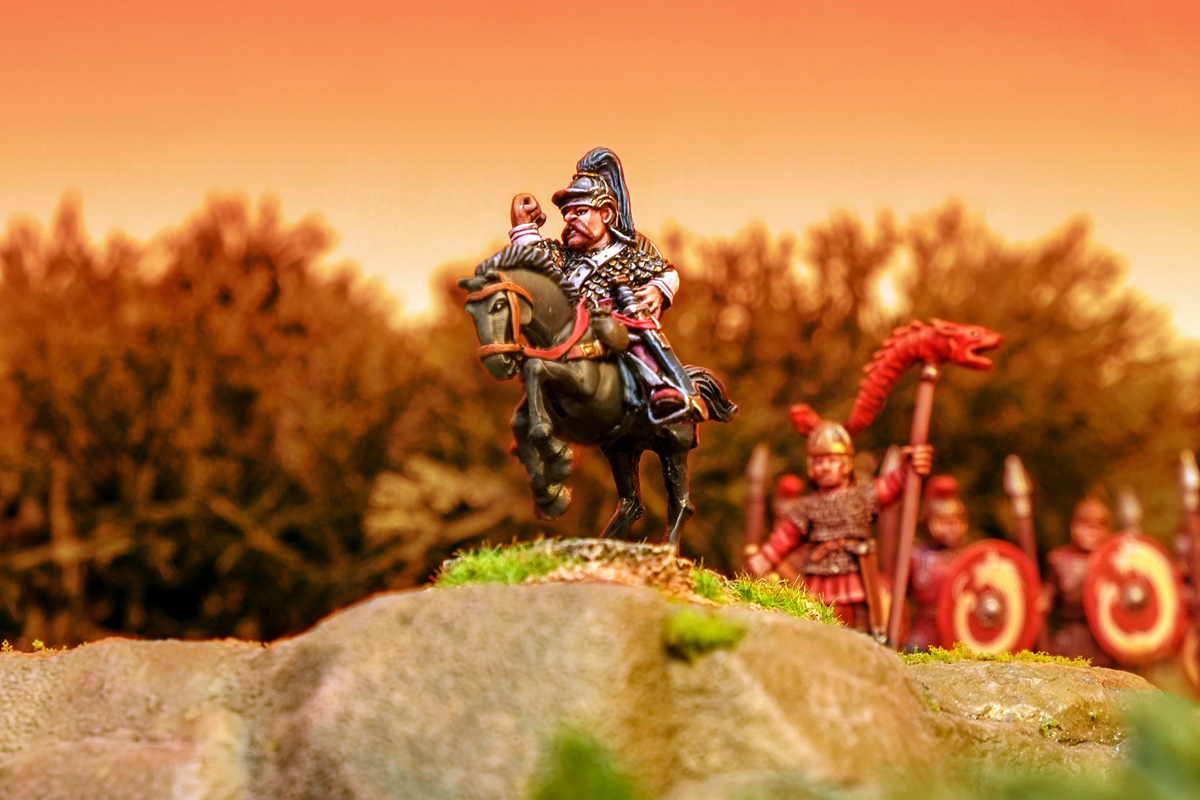
Genseric and his bucellarius on the outskirts of Carthage.
[url=http://http:" target="_new" rel="nofollow">www.ninjabread.co.uk/]
Not Genseric.
Regardless of the figure’s true identity, it’s now definitely part of my Late Imperial Roman army and will get some outings in SAGA when I’ve painted enough for a 4-point warband … coming soon.
If you’ve got any theories or information on the figure, please please let me know in the comments.
More of my miniatures at: http://www.ninjabread.co.uk/
Painting tutorials at: https://www.patreon.com/ninjabread
|
|
This message was edited 2 times. Last update was at 2018/10/05 16:07:44
|
|
|
 |
 |
|
|
|